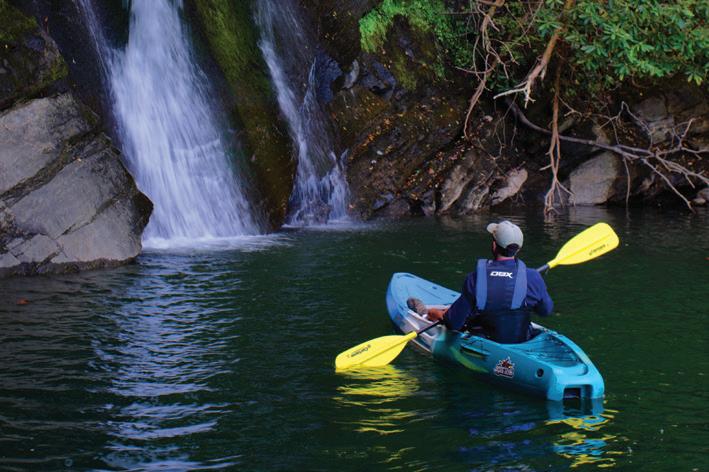


































































We’re going to let you in on a secret. Billionaires have billions because they know value is not increased by an in ated price. ey avoid big name markups, and aren’t swayed by ashy advertising. When you look on their wrist you’ll nd a classic timepiece, not a cry for attention–– because they know true value comes from keeping more money in their pocket. We agree with this thinking wholeheartedly. And, so do our two-and-a-half million clients. It’s time you got in on the secret too. e Jet-Setter Chronograph can go up against the best chronographs in the market, deliver more accuracy and style than the “luxury” brands, and all for far, far less. $1,150 is what the Jet-Setter Chronograph would cost you with nothing more than a di erent name on the face.


With over two million timepieces sold (and counting), we know a thing or two about creating watches people love. e Jet-Setter Chronograph gives you what you need to master time and keeps the super uous stu out of the equation. A classic in the looks department and a stainless steel power tool of construction, this is all the watch you need. And, then some. Your satisfaction is 100% guaranteed. Experience the Jet-Setter Chronograph for 30 days. If you’re not convinced you got excellence for less, send it back for a refund of the item price. Time is running out. Now that the secret’s out, we can’t guarantee this $29 chronograph will stick around long. Don’t overpay to be underwhelmed. Put a precision chronograph on your wrist for just $29 and laugh all the way to the bank. Call today!


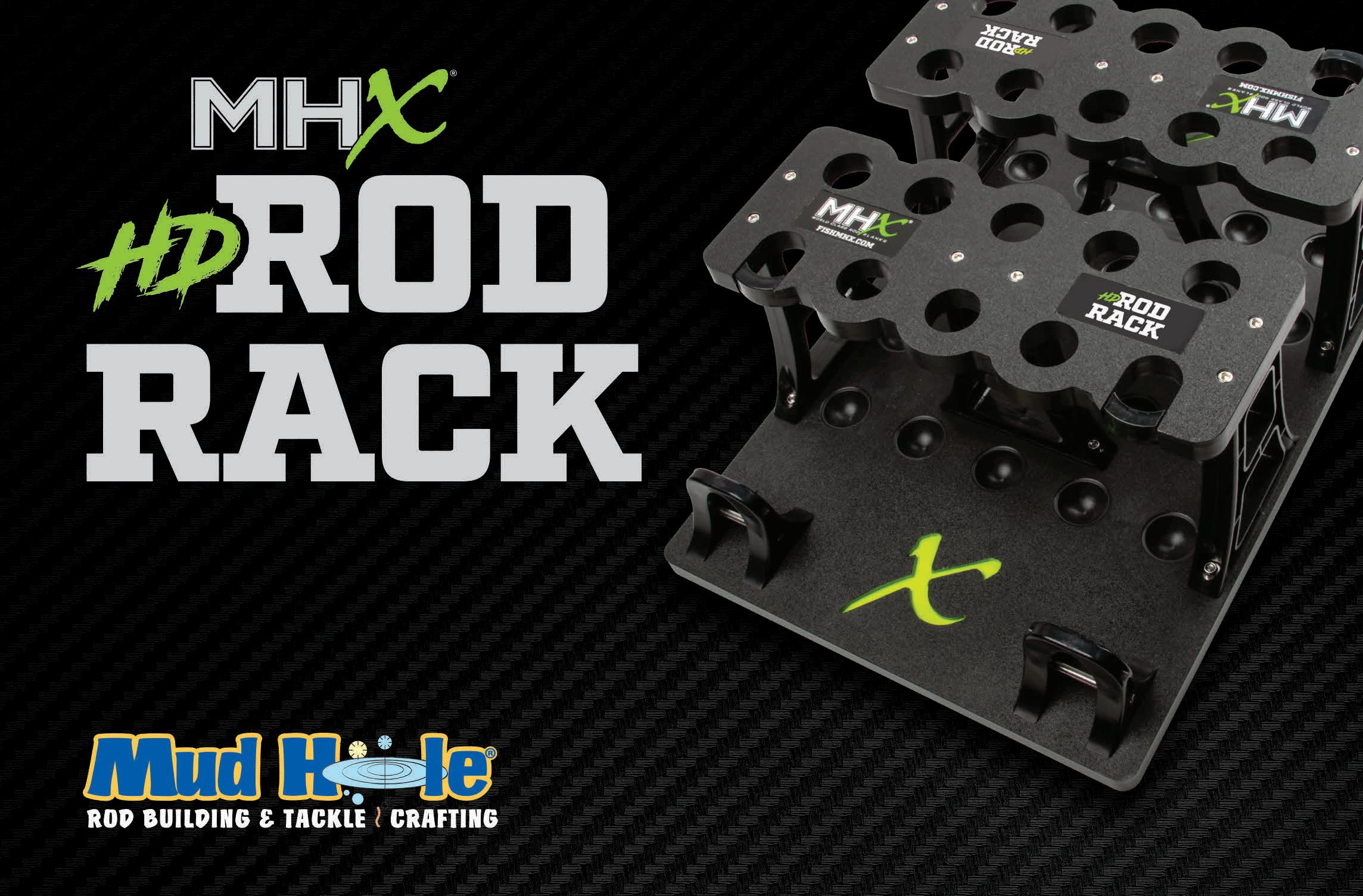

 By Nick Carter
By Nick Carter
Winter is the best time to sh,” said Capt. Chris Cameron, “the only problem is the weather.”
Capt. Cameron is owner/operator of Fired Up Fishing Charters out of Cocoa Beach, Fla. He said it was tough to nd good weather windows this November and early December, but that o shore shing is primed to re o like a Space Coast rocket whenever conditions stabilize.
Winter on Florida’s Atlantic Coast can be spectacular because of all the migratory species that push down to overwinter in milder temperatures. King sh, cobia, black n tuna, sail sh and others are all hunting the reefs about 18 miles o Port Canaveral. e key to the shery is menhaden.
“ is time of year, you get these huge baitballs,” said Capt. Cameron, “and there are all these sh following the bait around. You nd sh where you nd ‘bunka’ congregating on the reefs.”
Cameron is a transplant from Long Island, New York, and even a er more than two decades living and shing Florida’s east coast, he still refers to menhaden as “bunka,” which is Yankee dialect for bunker, which is what they call pogies up where boats are winterized this time of year.
“On good days, when you can get o shore and the water is clean, we might catch a limit of kings, a couple cobia, a couple black ns and hopefully a sail sh,” Cameron said. Even with 2022’s tightening of cobia regs, that’s a fun and delicious mixed bag to ll the freezer.

At places like Pelican Reef and 8A Reef, where depths range from 75 to 85 feet, Cameron nds the bait and then goes to work slow trolling live baits on double-hook stinger rigs and 20-pound line and tackle. He said he pulls baits at about 1 knot, which allows them to swim along naturally.
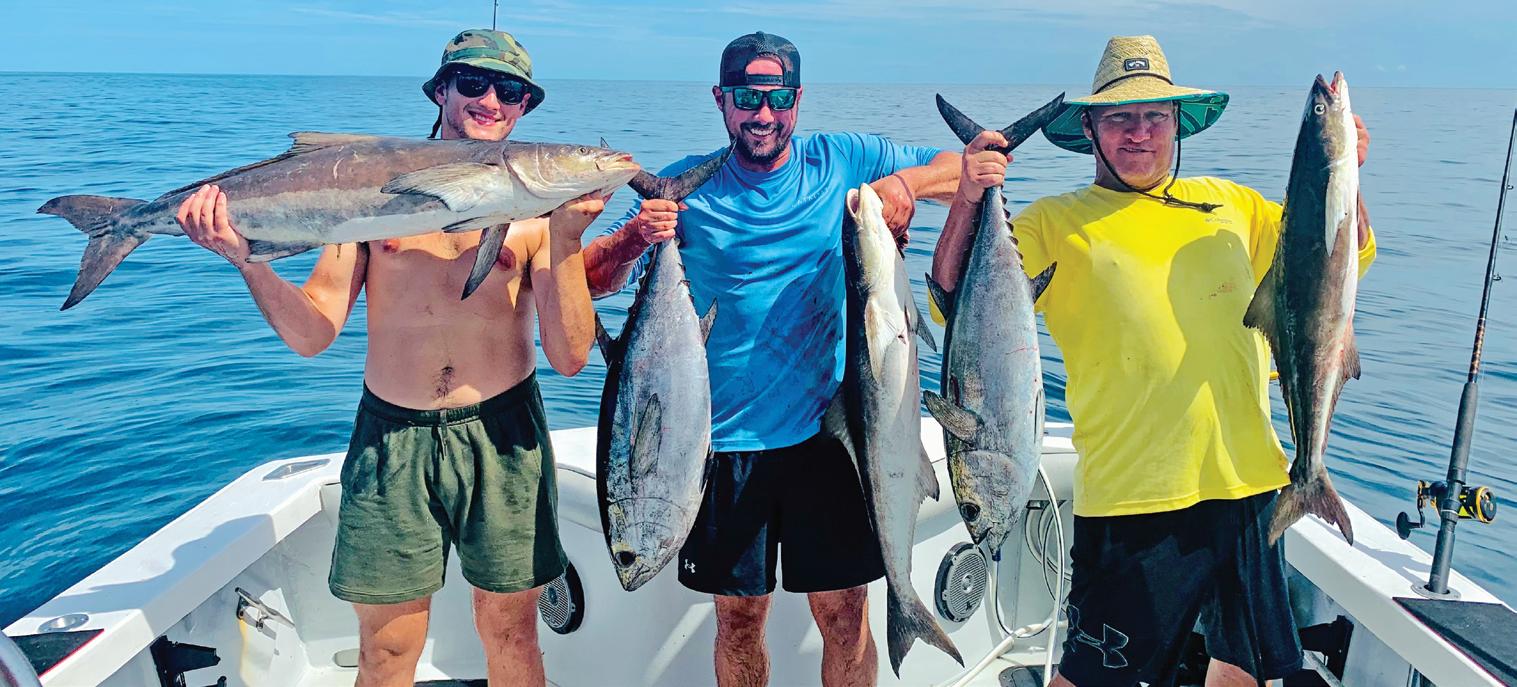
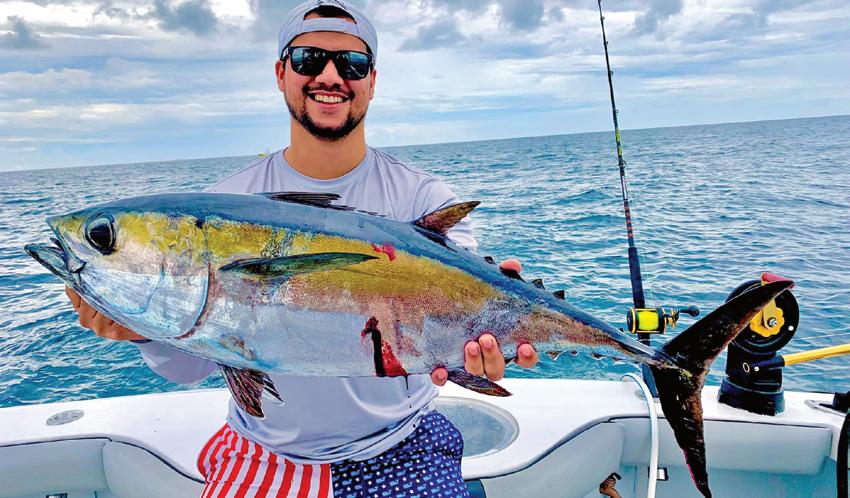
“ e thing with slow trolling is you never know what you’re going to get,” said Cameron. “It could be a big king, a sail sh, a cobia or a shark.”
Pitch rods are kept ready in case a cobia shows up on the surface. Cameron said he’s learned from experience not to over-stimulate cruising cobia by throwing multiple lines at once. Usually, clients can convince cobia to bite with a one-two punch. ey keep a squid-tipped bucktail ready for a quick cast. If that doesn’t draw a strike, it allows time to slap a live bait on the second rig, which is a simple 5/0 circle hook.
Shrimp boats are another option Cameron seeks out this time of year. Although chasing them can be a bit of a time gamble, since they are usually 25 miles o shore over 200 feet of water, they can be extremely productive.
“If you see a shrimp boat o in the distance or spot one on the radar, it’s almost always worth a shot,” Cameron said. “When they dump their bycatch in the morning, it pulls everything up.”
Fishing shrimp boats can be short-lived, but
it can also provide fast action for the same species that come o the reef. For this bite, Cameron beefs up to 6500 spinning gear and 50-pound braid and 50-pound mono leaders. He keeps four pitch rods ready, two with bucktails and two with live baits, because the bite can turn into sight shing

in a hurry. Meanwhile, he’ll search with freelined pogies on a knocker rig.
Contact Capt. Chris Cameron and Fired Up Fishing Charters through their website at redupcharters.com.

Winter’s cold fronts consolidate wahoo to their preferred temperature ranges across their range. is makes them easier to target than at any other time of year. e following is a short list of very good destinations for wintertime wahoo.


San Salvador, Bahamas: Way out in the Atlantic in the southern Bahamas, the waters o San Salvador hold one of the best wahoo sheries in the world. Peak wahoo season is December through April, when hordes of ’hoos migrate to the area’s warm waters. e island might just be the
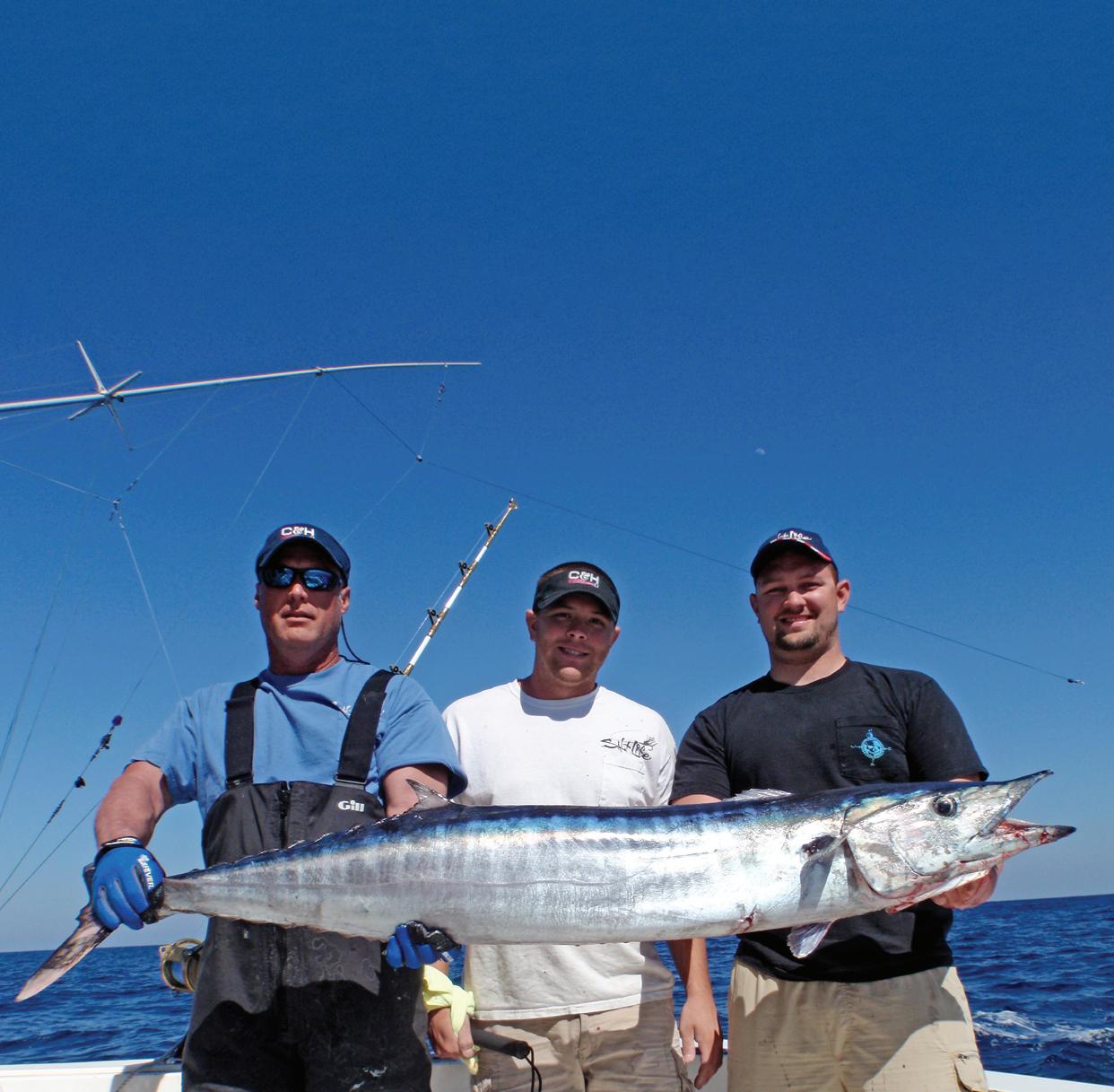
best place on the planet for a shot at a triple-digit wahoo, and the right conditions can yield fast action for 50-pounders, as well.
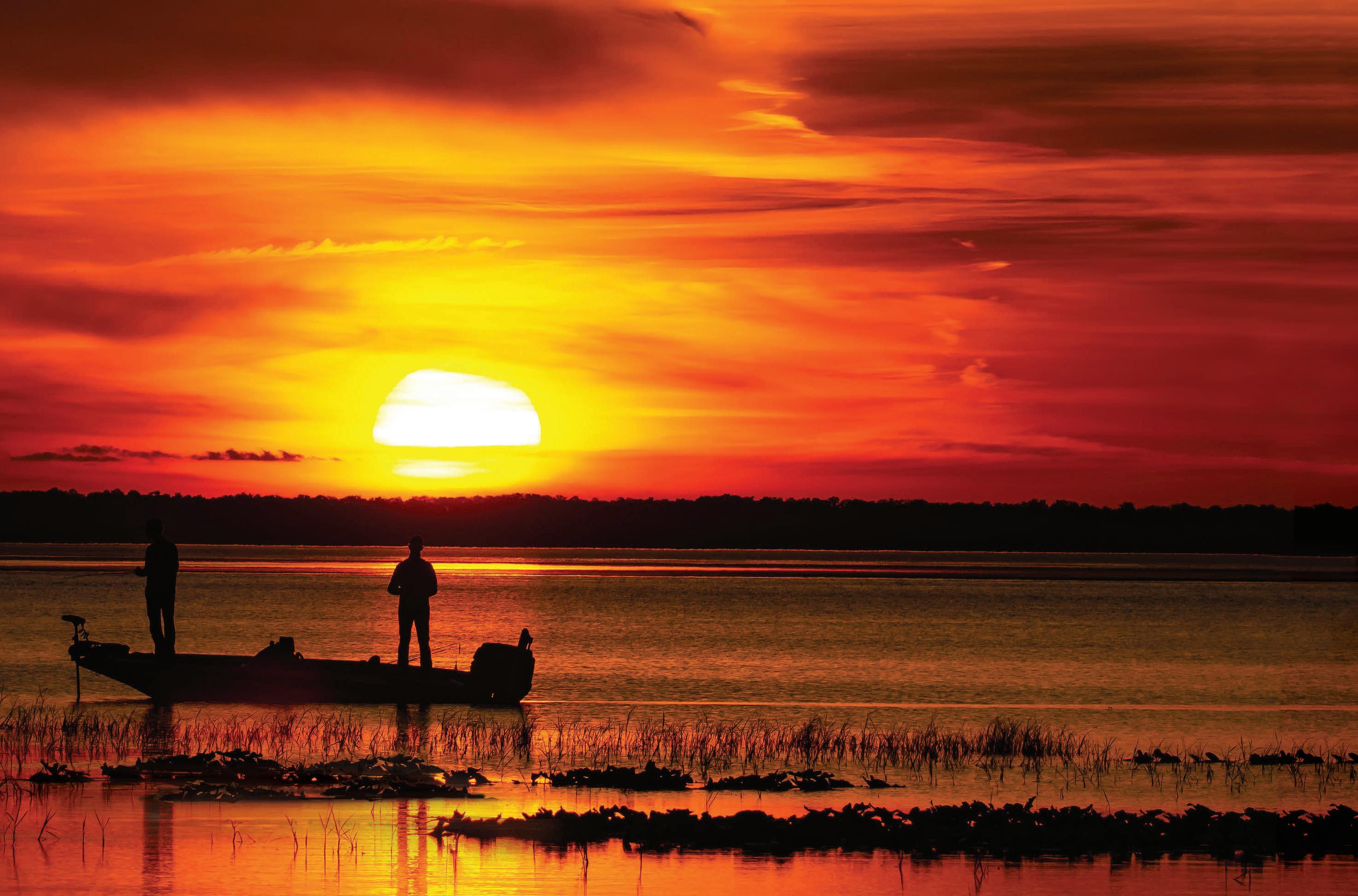
Within a short 10-mile run o the island, a seamount rises to 180 feet from 4,000 feet of water. is hump is a well-known feature, where wahoo congregate to feed on schools of small tuna. e remoteness of San Salvador keeps shing pressure in check, but it also makes this one of those bucketlist trips you plan ahead for.
Galveston, Texas: O shore humps out of Galveston, Texas also lay claim to some of the best wahoo shing in the world, and every winter anglers connect with giants. is shery, however, is reserved for anglers with the gumption to make 100-mile overnight runs to features like East and West Flower Gardens to catch the morning bite.
Windows of good weather and big, fast boats are a requirement to reach the shing grounds at the edge of the Continental shelf, where wahoo pile up with bait sh on steep depth changes of rock structure.
Murrell’s Inlet, South Carolina: O the South Carolina coast, cooling water temperatures con ne wahoo to the warm water at the edge of the Gulf Stream. is makes them much easier to target than when they are spread out in summer.
Depth changes and structure at the edge of the Continental Shelf, combined with warm 70 to 80 degree waters of the Gulf Stream can be found 50 or 60 miles o the coast. ese structures hold bait sh in the temperature range where wahoo are comfortable. Covering lots of water with high-speed spreads trolls up the best wahoo of the year, every year.
Venice, Lousiana: It seems everything o shore of Louisiana is about the oil rigs, and in wintertime the oil rigs are all about wahoo. e key to nding wahoo on the rigs is nding the right temperature range, and the magic number is 60 degrees. Wahoo congregate and feed around the rigs where there is bait and water temperatures of at least 60 degrees.
One of the great things about Venice is there are deep-water rigs relatively close to shore at just 15 or 20 miles, which means it’s possible to nd a good weather window and go. e Louisiana coast also boasts some of the best catch rates for wahoo in the world, and 50- to 60-pound sh are the norm.
The very best hunting knives possess a perfect balance of form and function. They’re carefully constructed from fine materials, but also have that little something extra to connect the owner with nature.
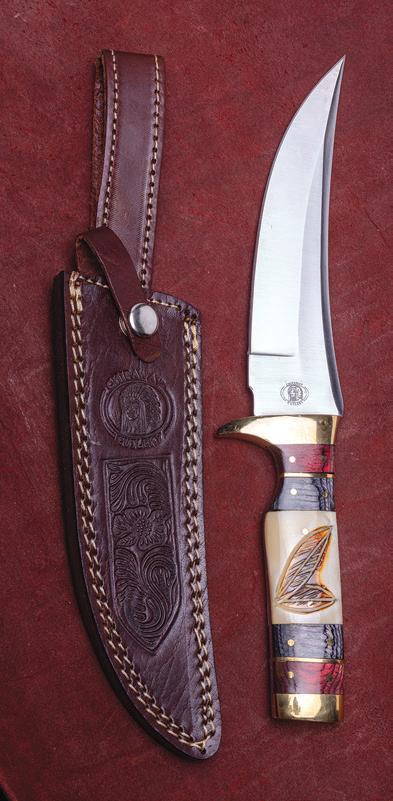
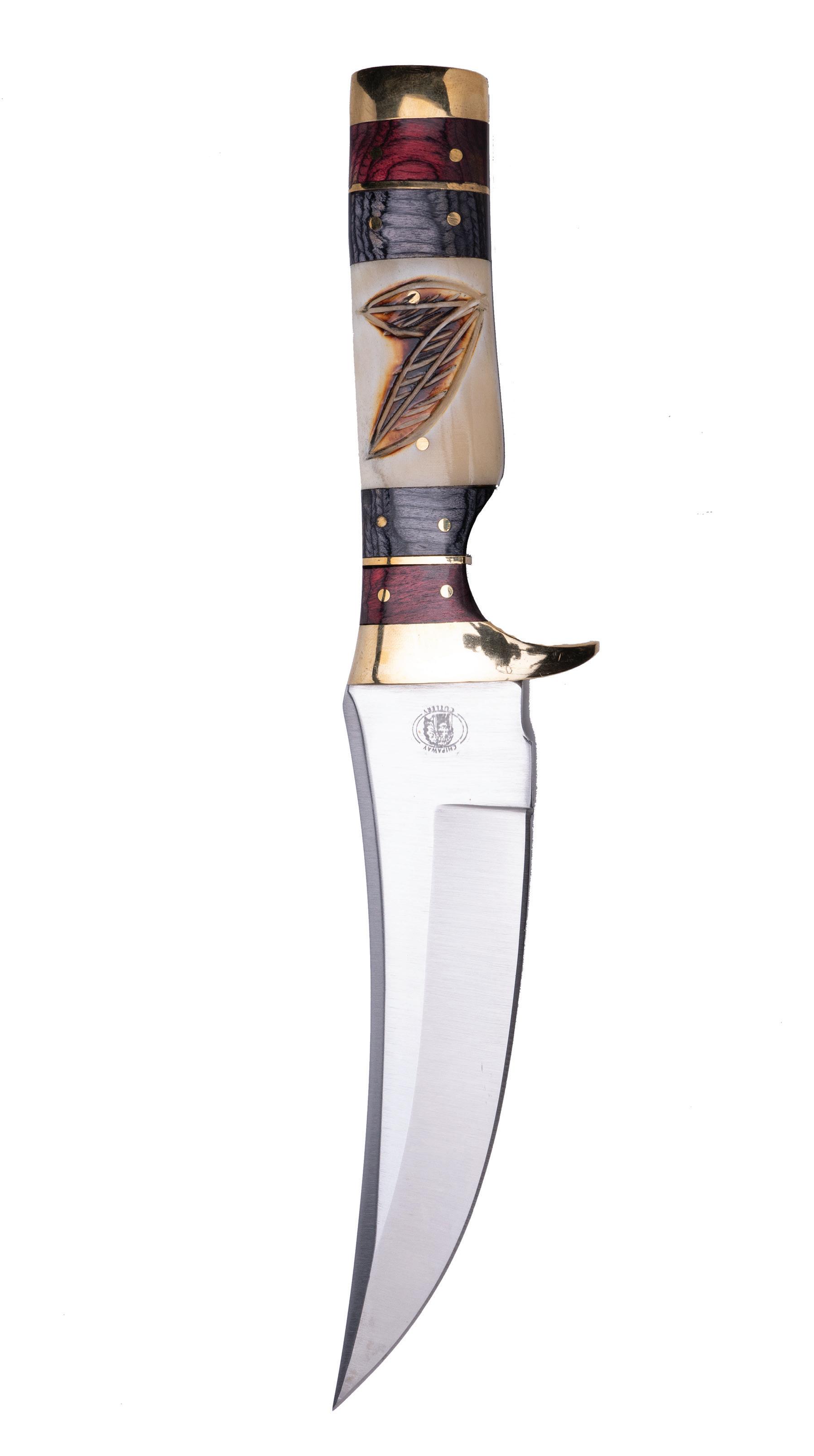
If you’re on the hunt for a knife that combines impeccable craftsmanship with a sense of wonder, the $79 Huntsman Blade is the trophy you’re looking for.
The blade is full tang, meaning it doesn’t stop at the handle but extends to the length of the grip for the ultimate in strength. The blade is made from 420 surgical steel, famed for its sharpness and its resistance to corrosion.


The handle is made from genuine natural bone, and features decorative wood spacers and a hand-carved motif of two overlapping feathers— a reminder for you to respect and connect with the natural world.
This fusion of substance and style can garner a high price tag out in the marketplace. In fact, we found full tang, stainless steel blades with bone handles in excess of $2,000. Well, that won’t cut it around here. We have mastered the hunt for the best deal, and in turn pass the spoils on to our customers.
But we don’t stop there. While supplies last, we’ll include a pair of $99 8x21 power compact binoculars and a genuine leather sheath FREE when you purchase the Huntsman Blade.
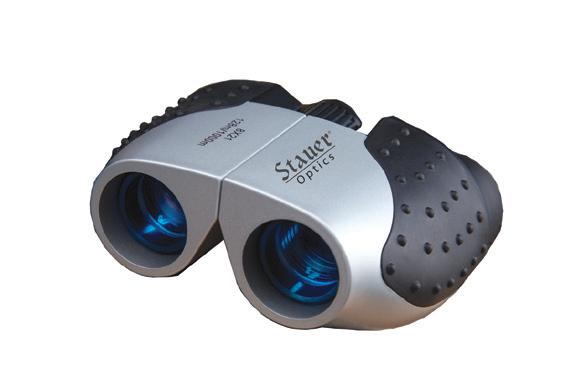
Your satisfaction is 100% guaranteed. Feel the knife in your hands, wear it on your hip, inspect the impeccable craftsmanship. If you don’t feel like we cut you a fair deal, send it back within 30 days for a complete refund of the item price.

Limited Reserves. A deal like this won’t last long. We have only 1120 Huntsman Blades for this ad only. Don’t let this beauty slip through your fingers. Call today!
“This knife is beautiful!” — J., La Crescent, MN
“The feel of this knife is unbelievable...this is an incredibly fine instrument.” — H., Arvada, CO

With grouper season over, it’s time to switch gears and concentrate on other species. is is the time of year to size down and go for the snappers. Depending on water temps, it’s also a good idea to keep a light line out for any pelagics that swim by.
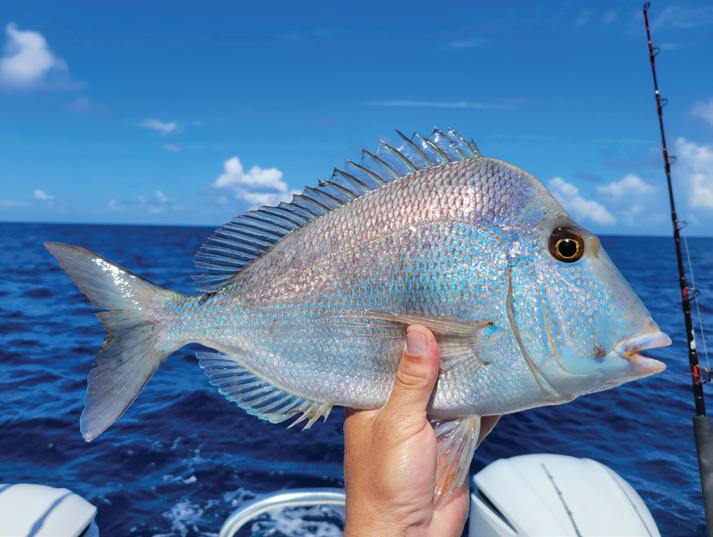

I love yellowtail and a mangrove snappers, but I really like jolt heads, trigger sh, pinkies, black seabass and hog snapper. I treat bottom shing like I’m going (organic) grocery shopping. First and foremost, I don’t shop on every aisle of the grocery store. I go down the aisles that contain the items I really want. e best groceries come from di erent places on the bottom and from di erent depths.
Farther north up the Atlantic coast there are a lot of beeliners (vermilion snapper) taking the place of yellowtails. In this mix will be trigger sh, which I absolutely love! Beeliners and trigger sh have one thing in common: the largest ones of the school stay higher in the water column. is is why I like to sh a level-wind reel versus a spinning reel with small circle hooks for this style of snapper shing. I start dropping one “strip” of the reel
at a time until I get down to the sh. A “strip” is the distance of raising the rod up with your thumb o the spool, and putting your thumb back on the spool. Simply let your thumb o the spool and let it fall in 10-foot “strips” while raising the rod tip upwards. Count the strips it takes to get down to the bites. Four strips will be approximately 40 feet deep. Note where you feel the rst bite. is will usually be the largest triggers and beeliners in the school. If you stop getting bites or you’re only catching smaller sh, let this same tackle go deeper or all the way to the bottom. is is where you’ll catch the jolt heads, black sea bass, mangroves and hogs.
I use a two-hook “chicken rig” made of 50-pound uoro with small circle hooks and a 3-ounce bank sinker. I bait it with small pieces of squid. A small 2- or 3-ounce jig works with the same tackle as the weight instead of a bank sinker. is is especially e ective on large triggers. Just replace the treble hooks or single
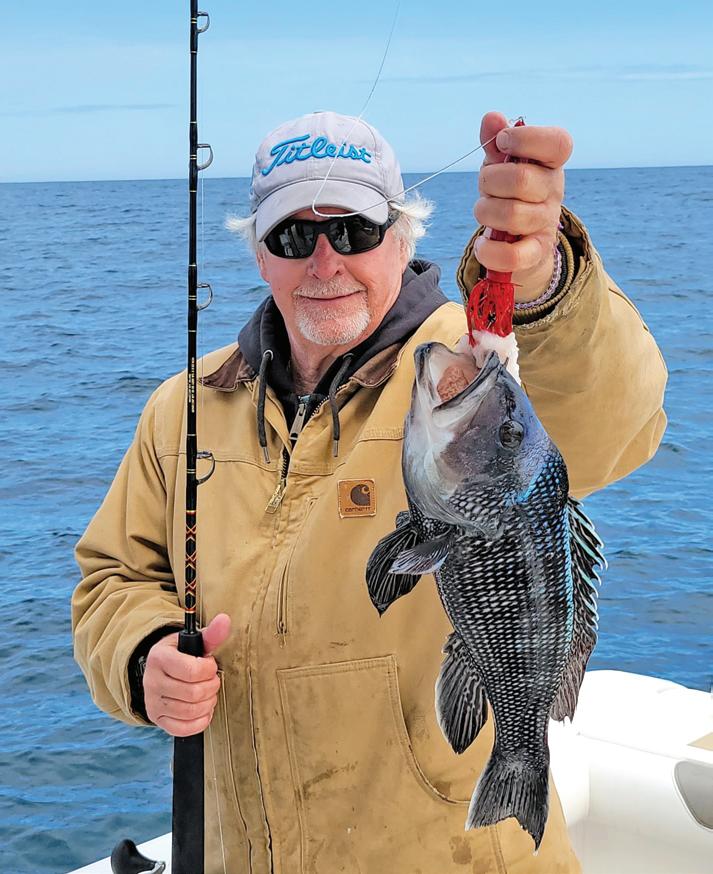

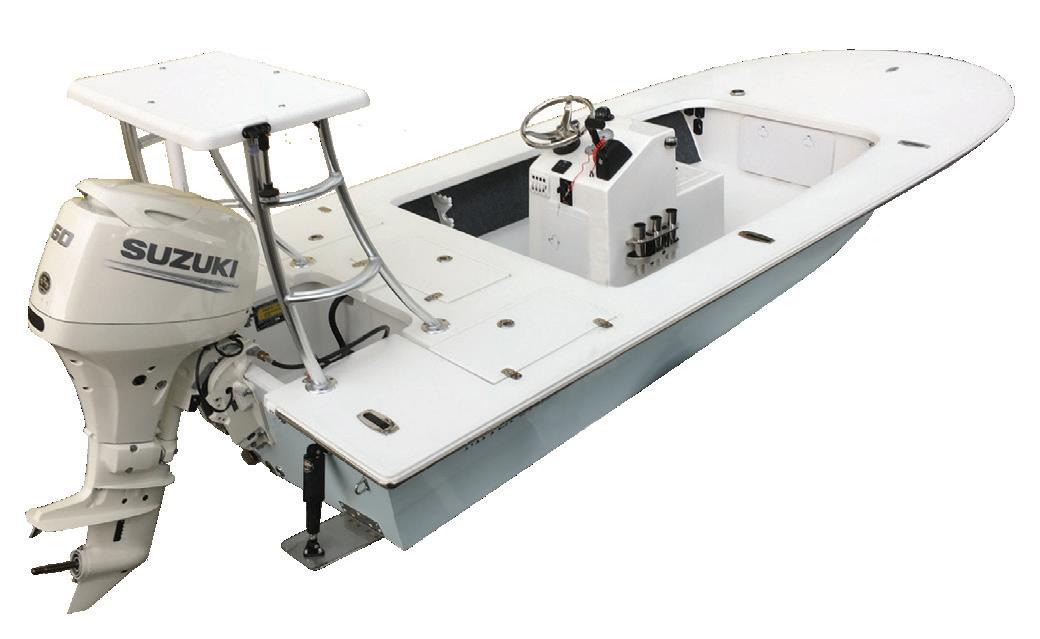
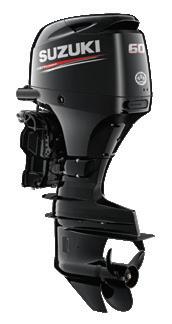
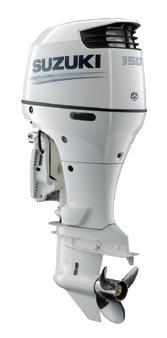
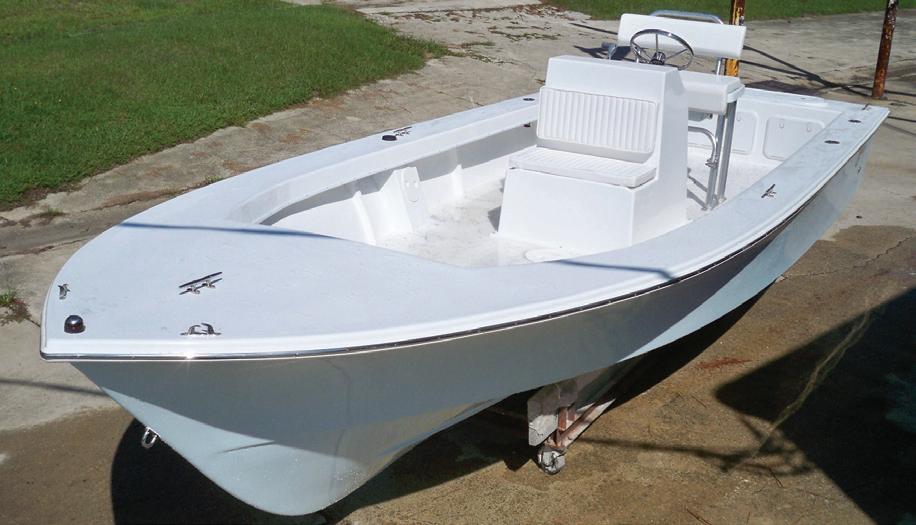
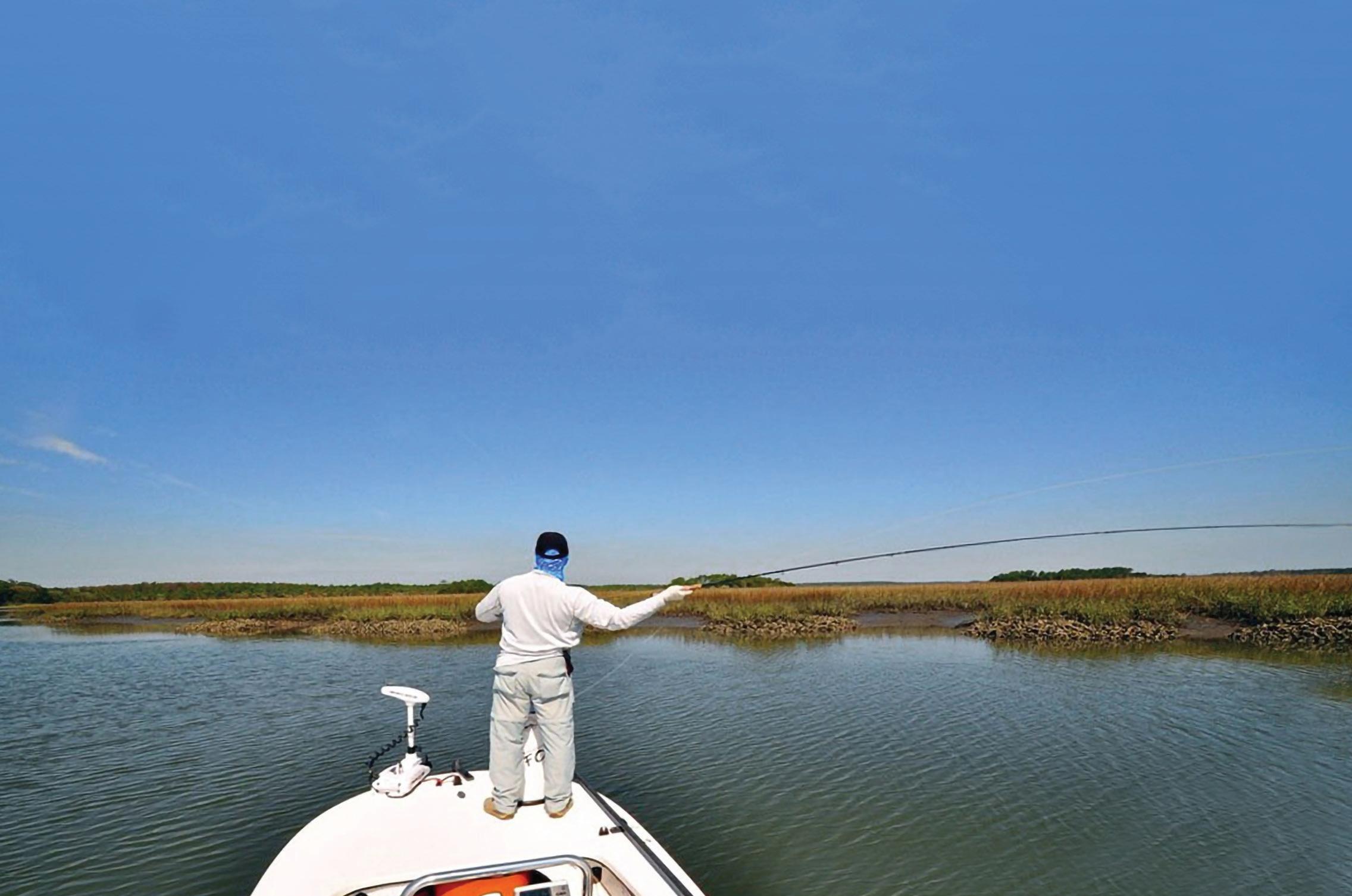
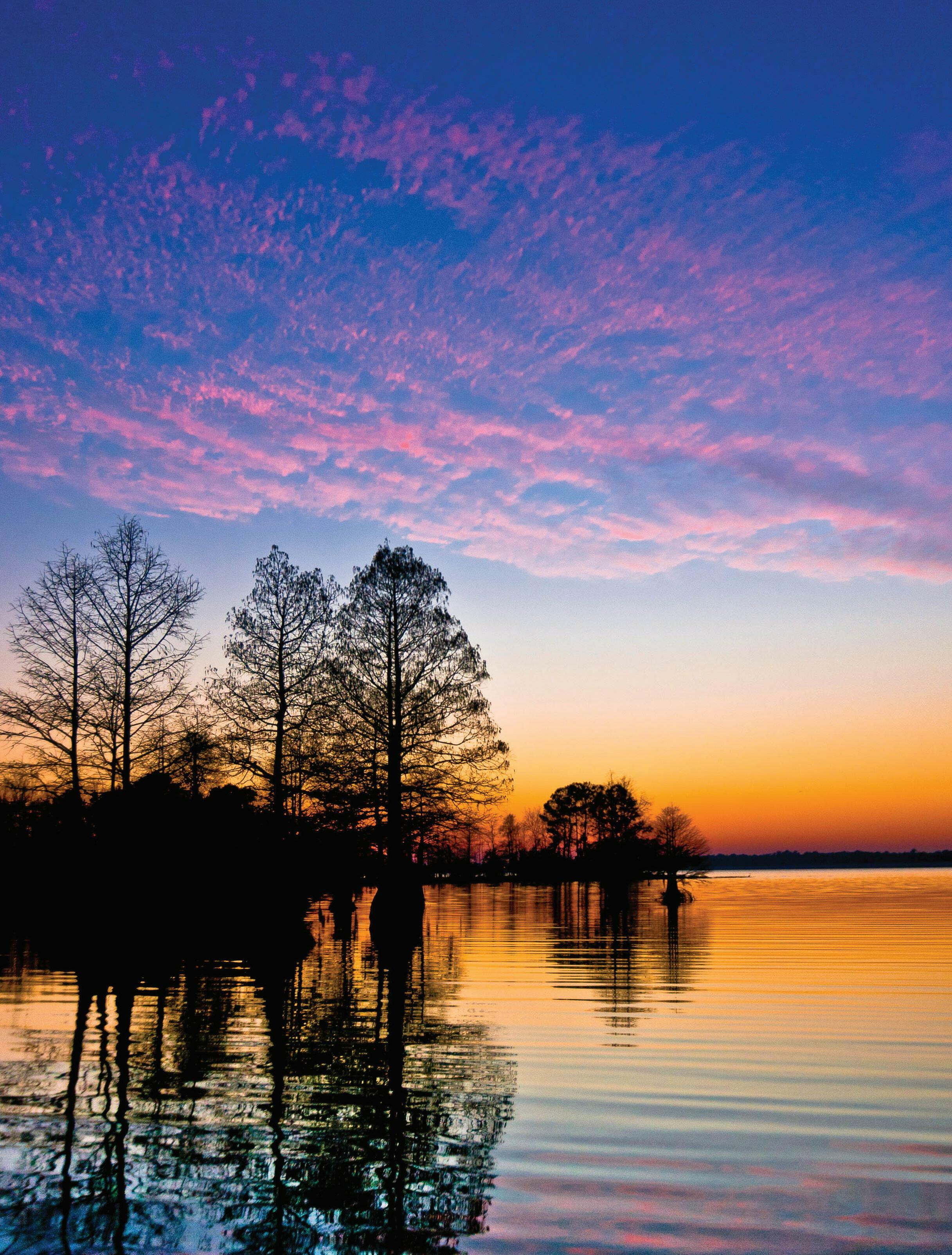
J hooks on the back of the jig with small circle hooks and tip with a small piece of squid.
I could go on and on about this style of shing. e limits are pretty good and the reward comes at the table. It is a good time of year to take youngsters out, because this style of shing produces lots of action, and it’s not heavy-duty grouper shing. Little ones love a trip to the “organic grocery store.”
See more from Tim Barefoot at www.barefootcatsandtackle.com and check out a video explaining this style of shing at https://bit.ly/3YcVzV1.

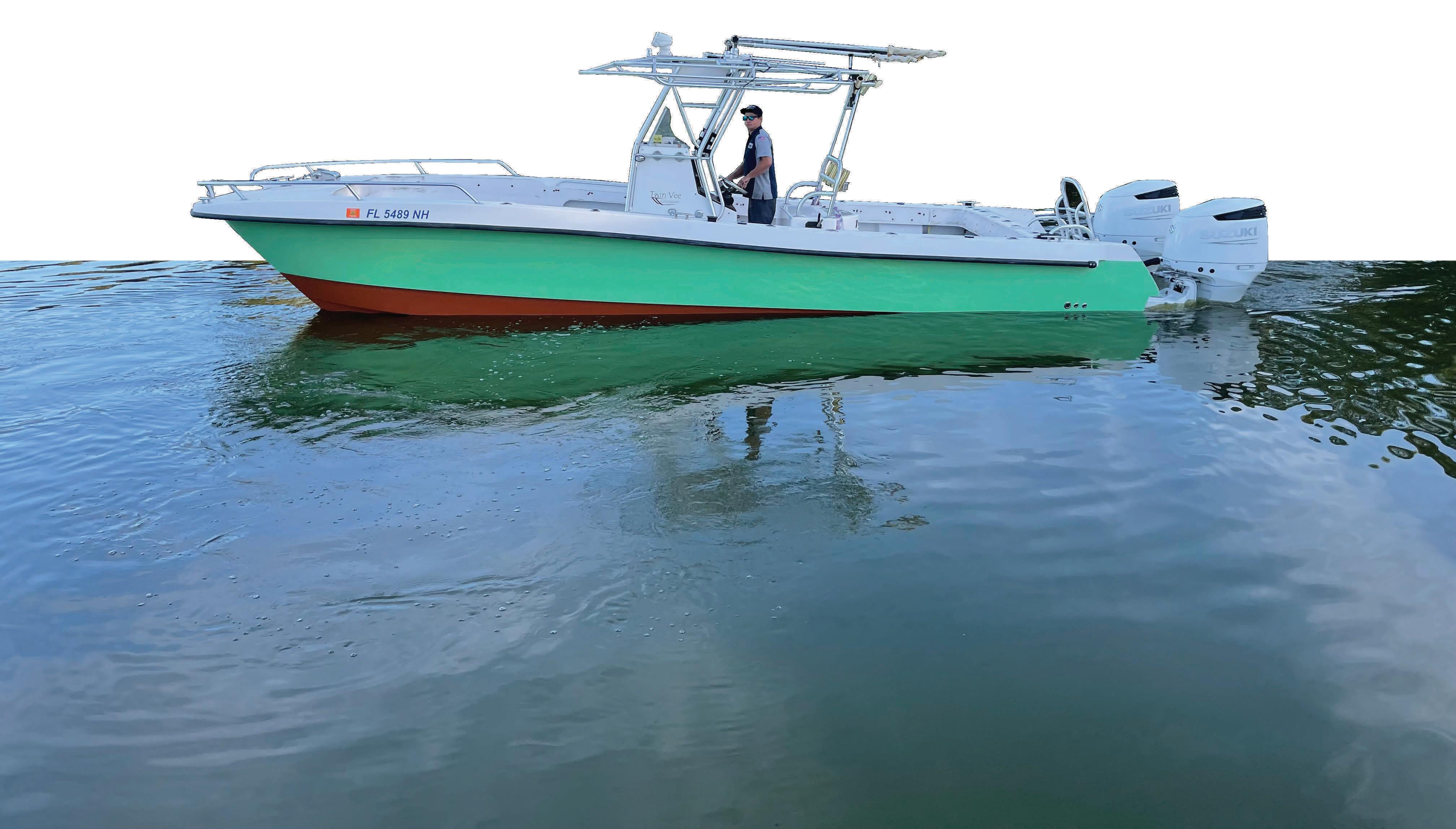







Wprivileged to guide clients there. We have broken many personal bests, and I get goosebumps every morning I launch the boat because I know the quality of sh.
Headwaters Lake is a 10,000-acre manmade lake in Indian River County adjacent to the well-known Stick Marsh and Farm 13. Prior to ooding the land, the FWC and the St. Johns River Management District created habitat with numerous underwater structures, ooded timber, vegetation and 30-foot-deep pits. ere were already existing ponds and pits on the property that contained resident bass, and nearly a million Florida strain bass were stocked along with bluegill, redear sun sh and crappie. ere are thousands of acres of submerged vegetation, mostly hydrilla, along with acres of cattails, spatterdock pads and hyacinth mats that are super fun to sh.
In central Florida, January and February are primetime, when bass are in full prespawn mode and waves of females move up to the ats to spawn. Air and water temperatures drop considerably a er cold fronts. Severe cold fronts a ect the ckle Florida strain bass, but not for long. Usually two days post front, conditions warm up and sh eat well again. ese weather changes transition bass and bait sh from summer patterns into fall and winter staging areas. ey feed heavily on shad and other forage and stage near the spawning ats.

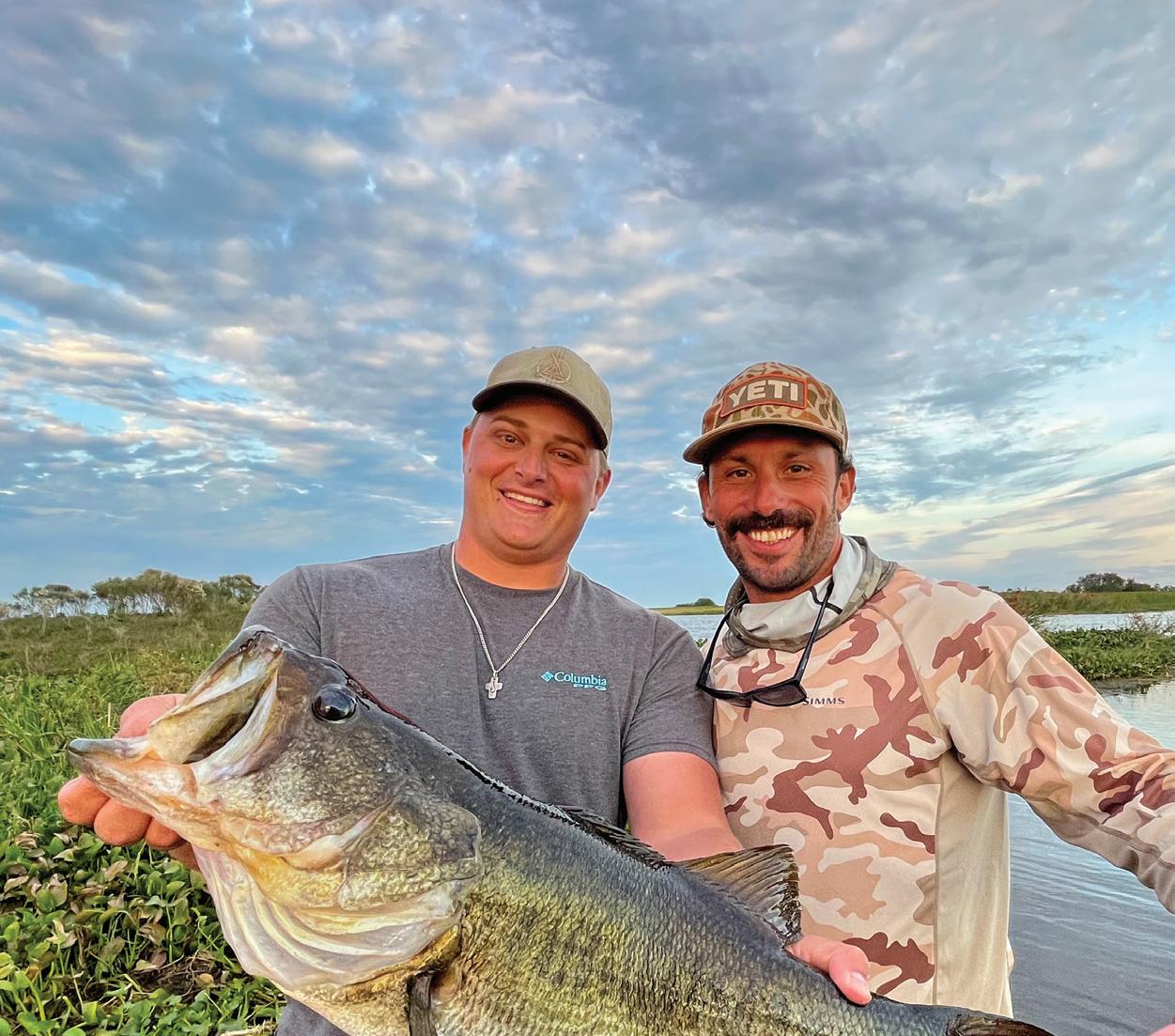
When full moons and 60-degree water temps coincide, bass move onto the ats. ey spawn in waves. Spawning sh select isolated hydrilla clumps, reeds and the bases of pad stems to fan out beds. Hard sand bottom is key. Use sonar to locate hard bottom or stick your rod tip into the water to feel the bottom. If your rod tip pushes into mud, keep moving until you nd sand and then search for isolated cover.
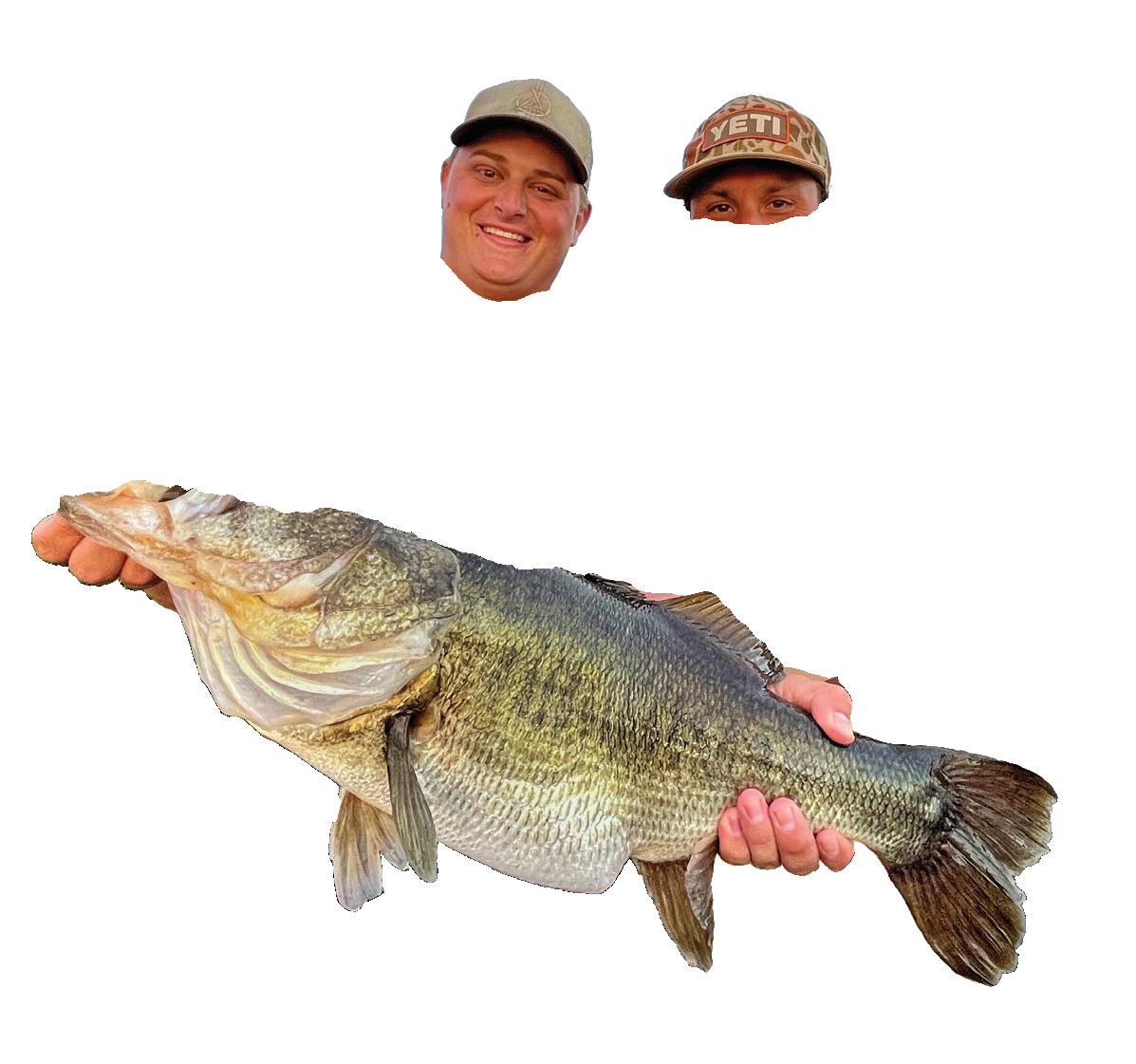
My other primary focus is staging areas. Staging sh eat well and are plump as they congregate to wait for prime conditions to move up and spawn. New sh constantly come and go using the same areas, so they are extremely productive this time of year.
Ditches and canals on Headwaters are highways that bass and bait sh utilize to stage. e intersections and mouths of these canals are high percentage areas to locate schools of sh. Find a canal with nearby ats as well as pits or deeper water for bass to retreat to, and you will nd sh. ey stage on tapering drop o s, mouths of intersections, deep ditches and on main-lake points to ambush bait. I target staging sh with 6- to 8-inch paddletails, glidebaits, Rat-L-Traps, jerkbaits, chatterbaits, prop baits, Whopper Ploppers, spinnerbaits, stick worms and speed worms.
Contact Capt. Ricky Congero through his website at www.blackcloud shing.com or call him at (407) 693-6153.

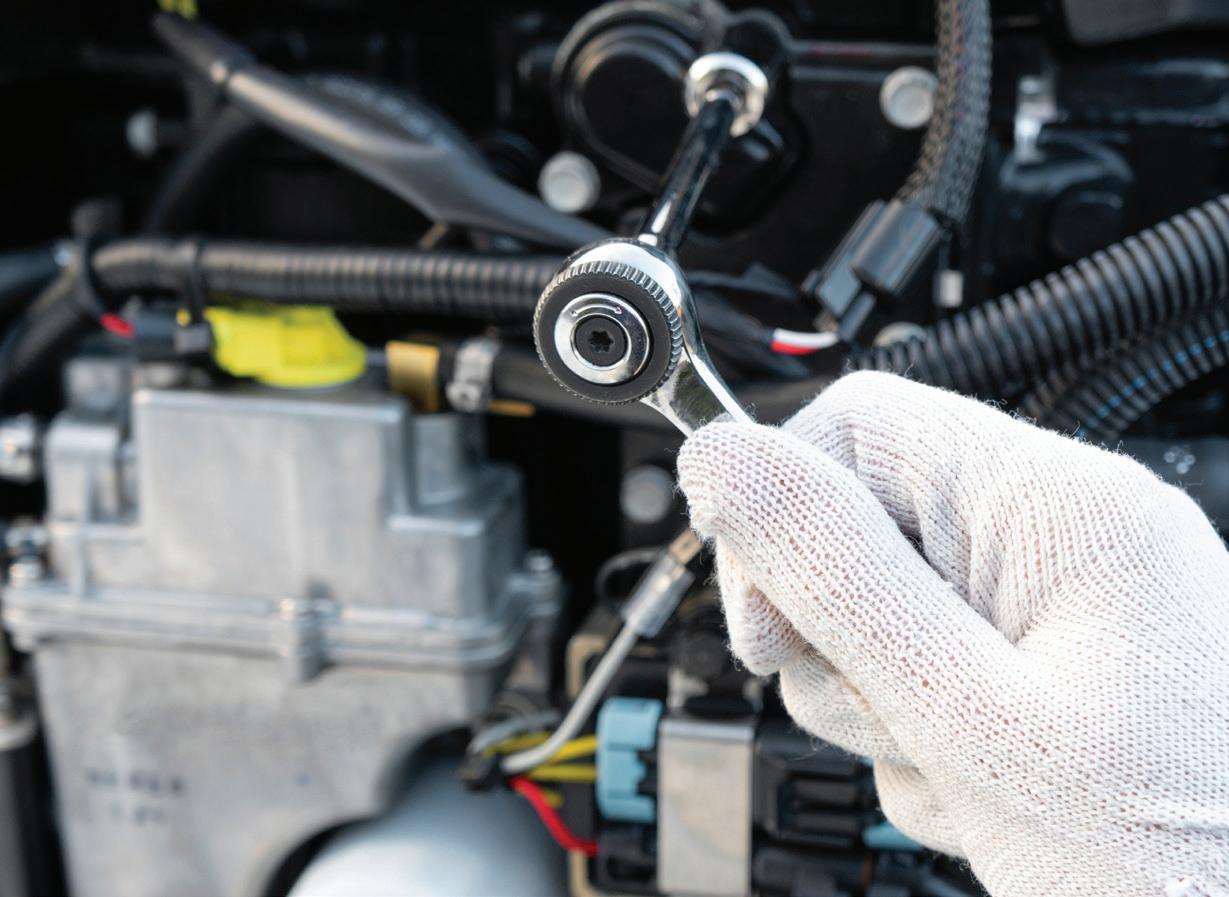







Technical schools charge tens-of-thousands in tuition. With the Mastry Suzuki RePower TTP (Technician Training Program), you will work with and learn from factory certified technicians and participating in the Suzuki on-line training course all while earning an hourly wage. After completing the Suzuki on-line training course and earning your Suzuki Certification you will be eligible for the Mastry Suzuki RePower Tenured Technicians Bonus Program.



Suzuki RePower Tenured Technicians

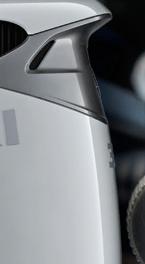



After joining a Mastry Suzuki RePower Center as a certified technician, every month you will accrue $1,000 in bonus opportunity. After one full year of service you will be tenured and eligible to receive all 12 months of accrued bonuses, or $12,000.


As a Mastry Suzuki RePower Tenured Technician along with your regular pay, each month you will be eligible for a $1,000 additional bonus.


At every Mastry Suzuki RePower Center, Certified Technicians are held in the highest regard. Join a passionate team of professionals with the common goal of excellence through constant improvement. With 12 locations across Florida there is a Mastry Suzuki RePower Center near you that wants to appreciate you and your abilities.

Mastry Engine Center
Clearwater, Florida 800-545-4574
Twin Screws Marine Fort Myers, Florida 239-330-3387
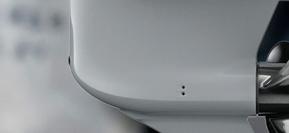

Innovation Marine Corp. Sarasota, Florida 941-355-7852
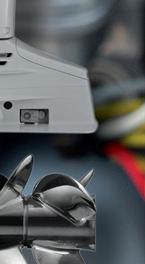

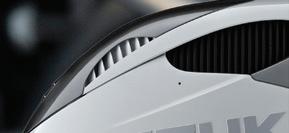


Marina One Deerfield Beach, Florida 954-421-2500
Bayfront Yacht Works Sarasota, Florida 941-349-9449
On Site Marine Ruskin, Florida 813-727-5403
Boat Services Group Key West, Florida 305-320-0555
McKenzie Marine St. Augustine, FL 32084 904-770-2488

Lou’s Marine, Inc. Gulf Breeze, Florida 850-932-0701
Atlantic Marine Store Hialeah, Florida 305-826-2202
Custom Marine Service Panama City, FL 850-872-9191



Oyster City Suzuki Apalachicola, Florida 850-653-8030

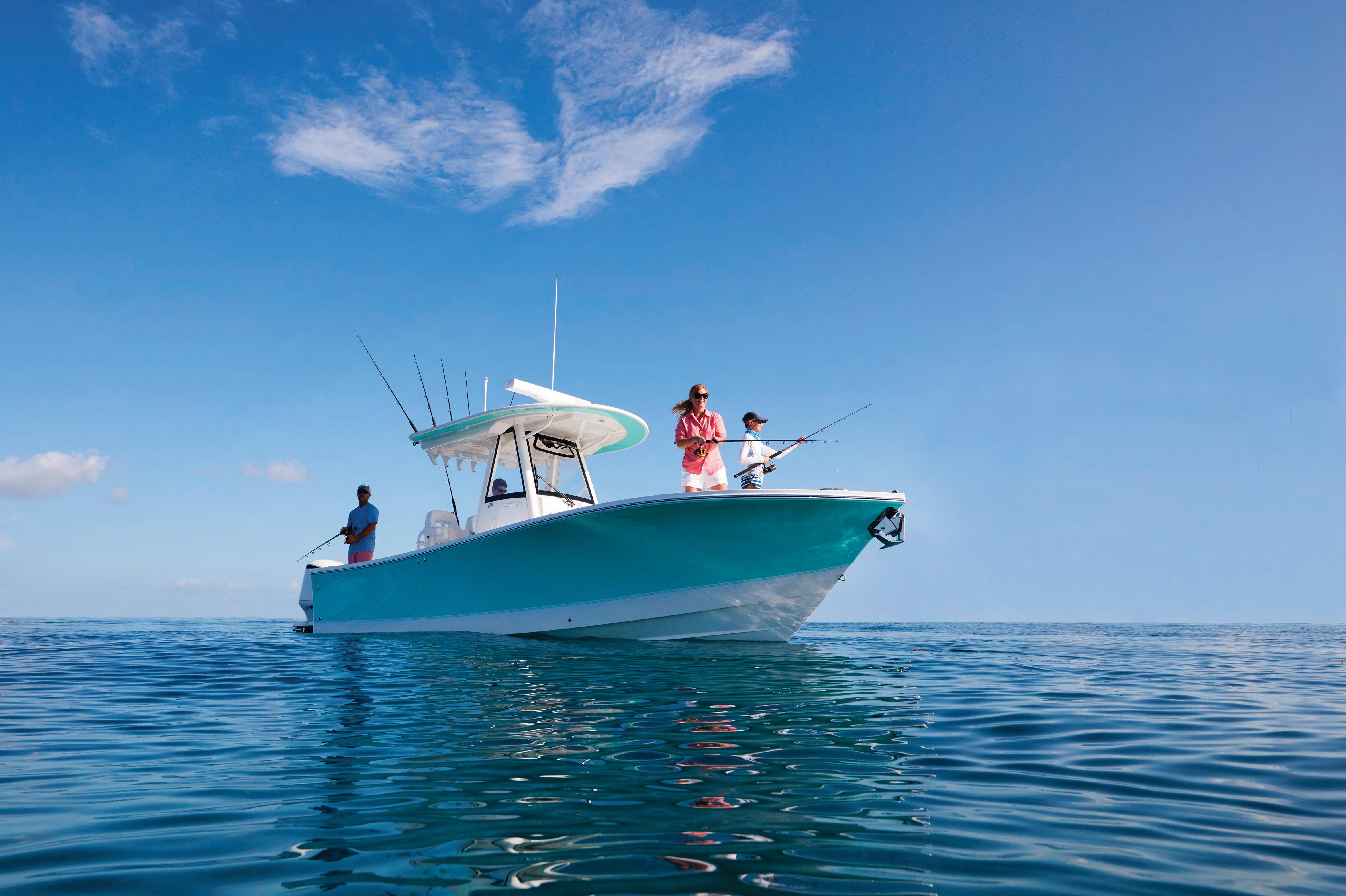


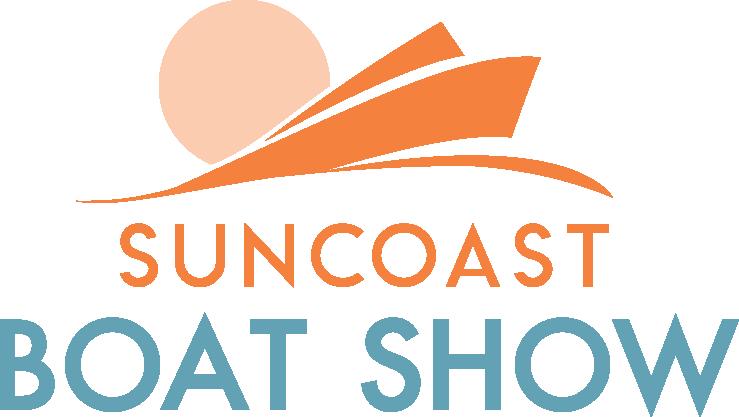






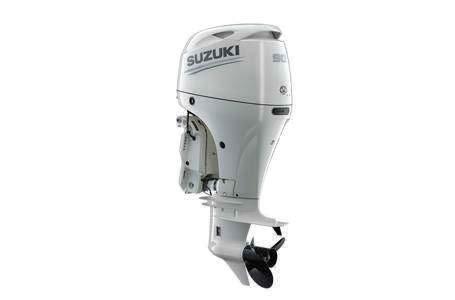


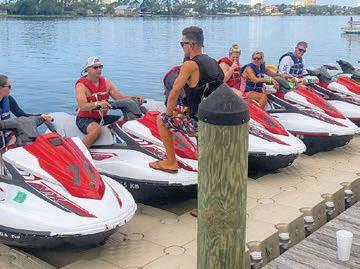


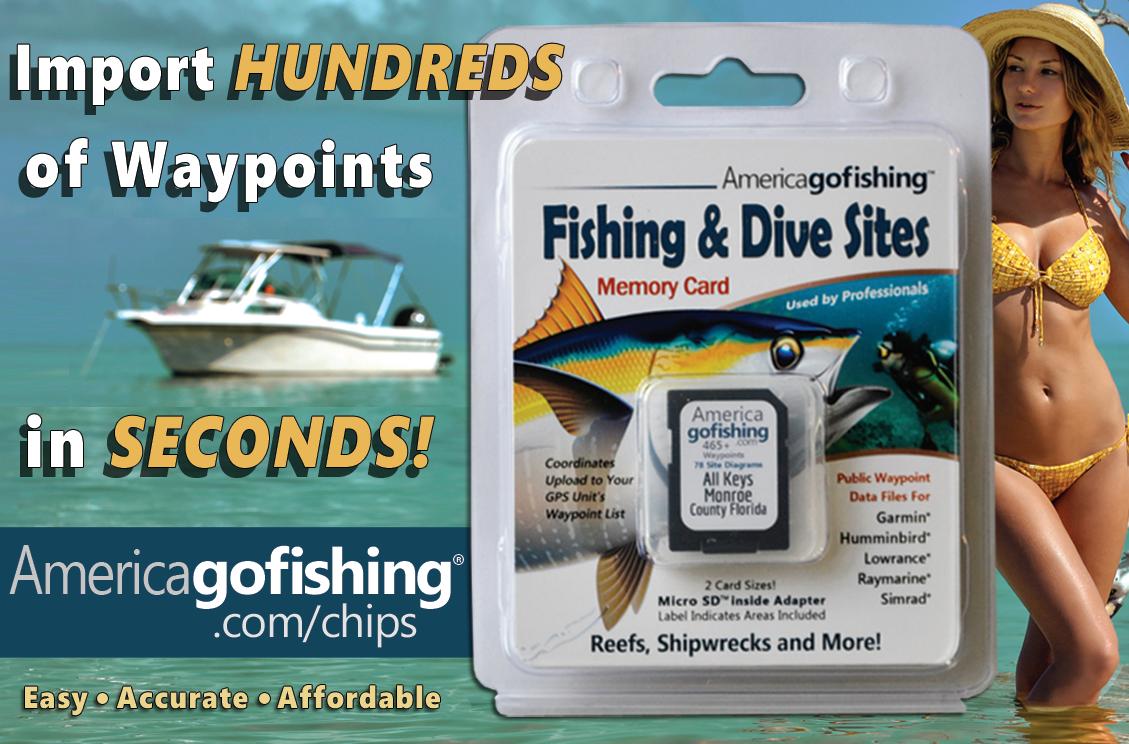
The FWC banned recreational harvest of Atlantic short n mako sharks by setting the recreational bag limit at zero during its Nov. 30-Dec. 1 commission meeting. e previous bag limit for recreational anglers was one mako per angler per day, with a limit of two sharks per boat. In a press release, FWC indicated the rule would make regulations in Florida waters consistent with federal regulations and address over shing of short n makos in support of U.S. and international e orts to manage the species. Commercial harvest of short n mako is already prohibited in state and federal waters.

For more information, visit MyFWC.com.

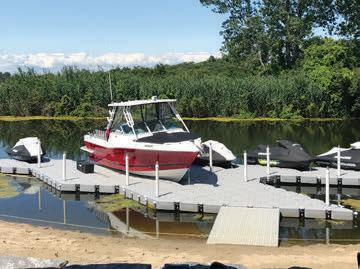

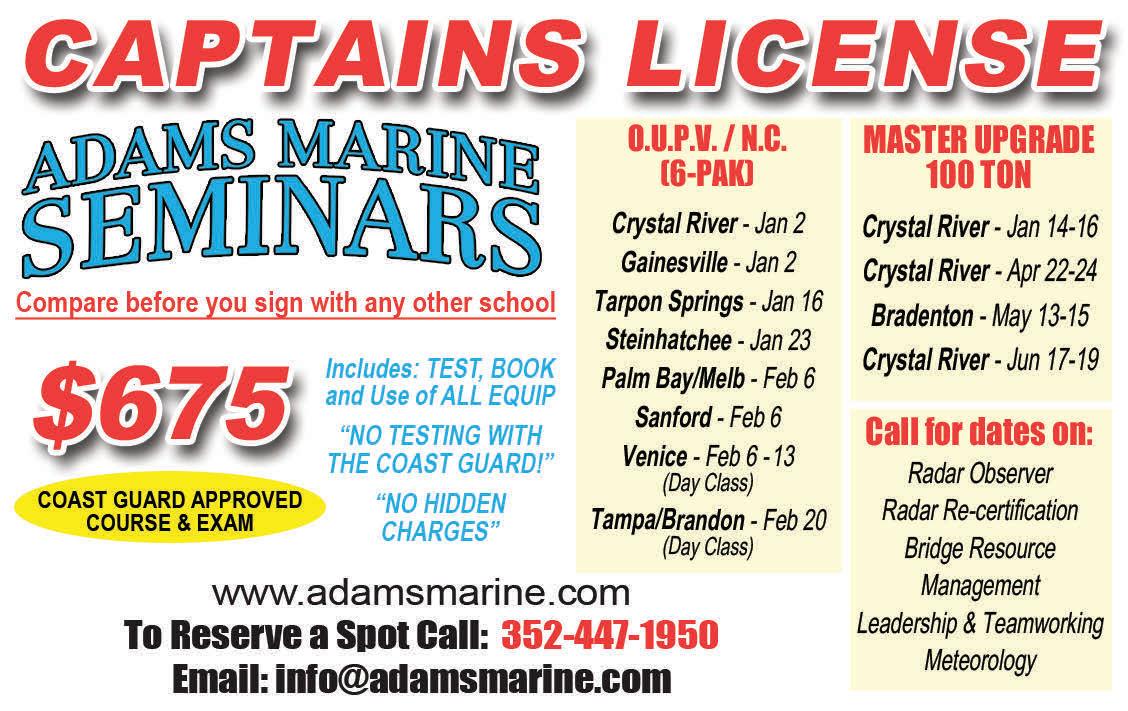
The Marine Industries Association of Palm Beach County (MIAPBC) illuminated the waterways at the 28th Annual Palm Beach Holiday Boat Parade. Presented by Compass, the free, familyfriendly event was led by a traveling firework display and featured 60 holiday-themed boats. Decked out with thousands of twinkling holiday lights, decorated small boats, sailboats, and mega yachts navigated up the Intracoastal Waterway from North Palm Beach to the Jupiter Inlet Lighthouse, and competed for cash and prizes in several categories. Thousands of toys were collected via the waterway along the parade route, filling five large box trucks. Nearly $10,000 in cash donations will be used to purchase more toys for Little Smiles and Toys for Tots to support children in the local community.

This year’s parade themes featured Elf on the Shelf, Pirates, the Griswolds, Polar Express, and Santa Claus. Sponsors and local dignitaries judged the friendly competition, with more than $10,000 in cash and prizes up for grabs.
The awards ceremony was held at Farmer’s Table in North Palm Beach on Tuesday, December 6. The



2022 “Best of Parade” and “Fan Favorite,” voted by the public through Facebook, was Nauti Kitty from Jupiter. The 53-foot power catamaran brought a “white” Christmas to Florida without the frozen fingers and toes. The boat was decked out with thousands of white lights, snowflakes, spheres, icicles, snowfall, and a beautiful, white, animated tree. Guests on the boat were dressed in all-white attire dancing to music from a live DJ, while enjoying their Floridastyle snowfall. The owners of Nauti Kitty generously donated their cash prize of $1,500 to Little Smiles and Toys for Toys.
“This year’s boat parade was one of the best yet! Not only did we have about a dozen more boats than last year, but many of the entries this year were new to the parade. They certainly got the message and did a great job decorating and bringing the energy,” said Executive Director Alyssa Freeman.

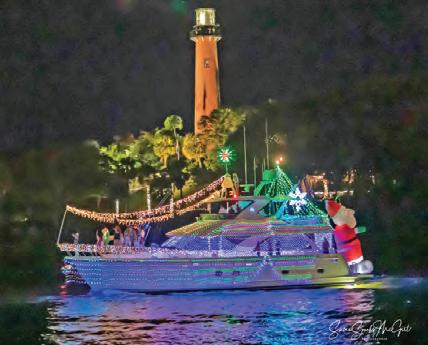
For more parade details, visit palmbeachboatparade.com or call (561) 863-0012.


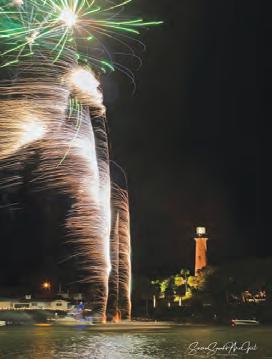 1st Place Over 35', Madame Blue #55. Traveling
1st Place Over 35', Madame Blue #55. Traveling
firework display.
Happy New Year Anglers! I can’t believe it’s 2023! Start off the New Year right and take advantage of the fantastic fishing we are blessed with off Palm Beach County! The sailfish sector aka ‘Sailfish Alley’ of the Gulfstream is at its prime this month. The sailfish bite best when a chilly north wind starts howling, kicking up the seas as it plows head-on into the Gulf Stream and stacking up the bait. A general rule of thumb to remember, the sailfish bite improves the first few days following a cold front. Anglers should look for pods of bait on their depth finder, water change, a clean water edge or a temperature break that will lead you to the fish. Anglers fishing offshore or fishing sailfish tournaments this month should be deploying kites for kite fishing. This allows anglers to have the best bait presentation possible.
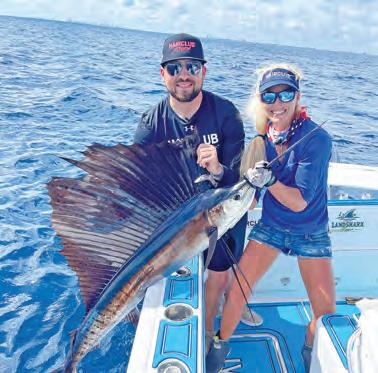
TIP: You should consider purchasing a drift anchor if you have a center console. A drift anchor will help you stay in the depth you are fishing longer, especially when the winds are howling and pushing your vessel out of the strike zone. Historically, productive areas for sailfish range from the Jupiter ledge to the waters in front of the Breakers and The Ritz Carlton, down to


Boynton’s water tower, the ‘Martini Glass’. Depth is key when kite fishing; you should target your efforts between 80-250 feet of water for sailfish until you determine the best depth for that day. If the seas are fairly calm this month, try to explore further offshore to find the occasional dolphin or wahoo. While traveling to and from your fishing grounds you should be on the lookout for cobia swimming in the shallows close to the beach. Also, along the beaches; delicious pompano, bluefish, and Spanish mackerel will
be plentiful. Spanish mackerel put up a hard fight on light tackle and are great table fare, with fish 5-7 lbs. not uncommon. You can target Spanish mackerels from a boat by trolling depths 10-25 feet and casting colorful jigs, spoons, or swimming plugs along the beach. For land-based anglers, the Juno and Lake Worth Piers, and rock piles off Boynton Inlet, should produce a good bite.
For those anglers that love to bottom fish, set up your drifts in depths of 60-120 feet near wrecks and reefs. Drift your baits using a triple hook rig with a dead sardine or a chicken rig with a sinker; both should yield muttons, yellowtail, mangrove snapper, and kingfish. Until next time, keep on catchin’!
7:05 5:42
Mon 6:20 2.4 6:21 2.2 12:35 -0.1 1:07 0.4 7:06 5:42
Tue 7:12 2.4 7:11 2.2 1:25 -0.2 1:56 0.3 7:06 5:43
Wed 7:59 2.4 7:57 2.2 2:12 -0.2 2:41 0.3 7:06 5:44 5 Thu 8:41 2.4 8:39 2.2 2:55 -0.2 3:24 0.3 7:06 5:45 6 Fri 9:21 2.4 9:20 2.2 3:37 -0.2 4:05 0.3 7:06 5:45 7 Sat 9:59 2.4 9:59 2.2 4:16 -0.2 4:44 0.2 7:07 5:46 8 Sun 10:36 2.4 10:38 2.2 4:54 -0.2 5:22 0.2 7:07 5:47 9 Mon 11:12 2.4 11:18 2.2 5:31 -0.1 5:59 0.2 7:07 5:47 10 Tue 11:48 2.3 11:58 2.1 6:07 0.0 6:35 0.2 7:07 5:48 11 Wed 12:24 2.3 6:44 0.1 7:13 0.2 7:07 5:49 12 Thu 12:40 2.1 1:01 2.2 7:23 0.2 7:53 0.2 7:07 5:50 13 Fri 1:26 2.0 1:40 2.1 8:07 0.2 8:38 0.1 7:07 5:50 14 Sat 2:16 2.0 2:23 2.0 8:59 0.3 9:30 0.1 7:07 5:51
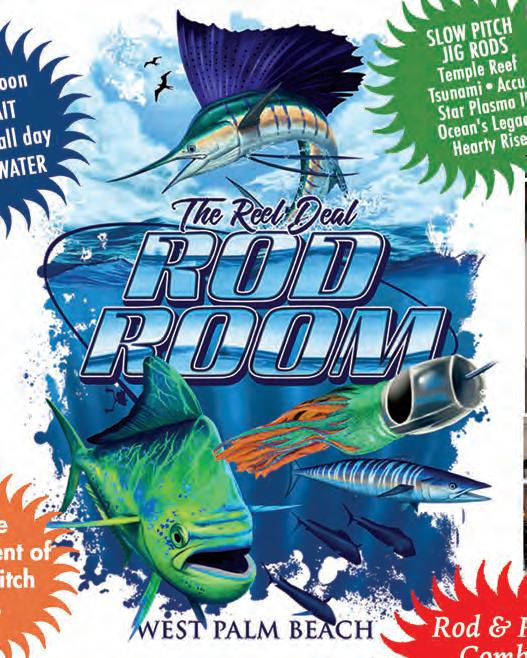

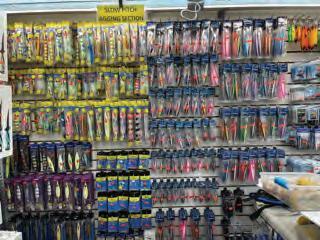

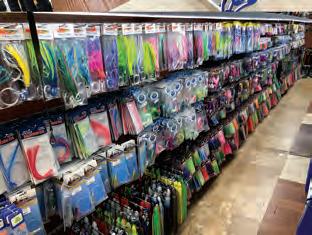
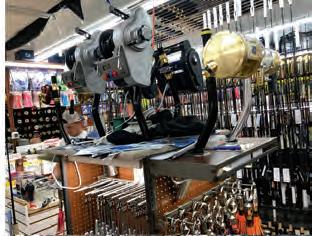
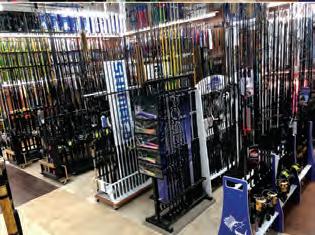
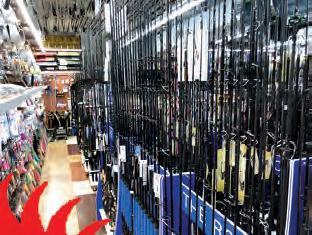
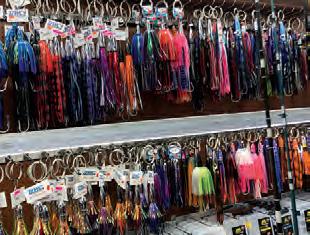





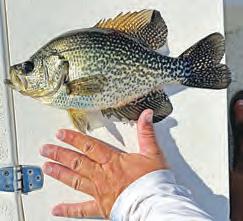
Ihope everybody had a great holiday season and is ready to get the new year started off right. January can be one of those months that I can go a few different directions, but on average it’s going to be cold, and most of my fishing is going to be deep. Unless I get lucky and stumble upon a school of snook, my main targets in the inshore saltwater will be big sheepshead and jacks. I do find quite a bit of by-catch while targeting those two species, such as African pompano, groupers, permit, and snook. The turning basin inlet and a couple deep spots in the channels are where I will spend most of my time. Big, heavy bucktails tipped with fresh shrimp drifted or bounced along the bottom are my main choice when it comes to what to offer them. If you’re not able to find fresh shrimp, which does happen this time of the year, fish bites are a great alternative.
The freshwater side of things will really depend on cold fronts. Sometimes the fishing is great all the way through the winter, not much different from the saltwater. Around structure, deep bridges, humps, and
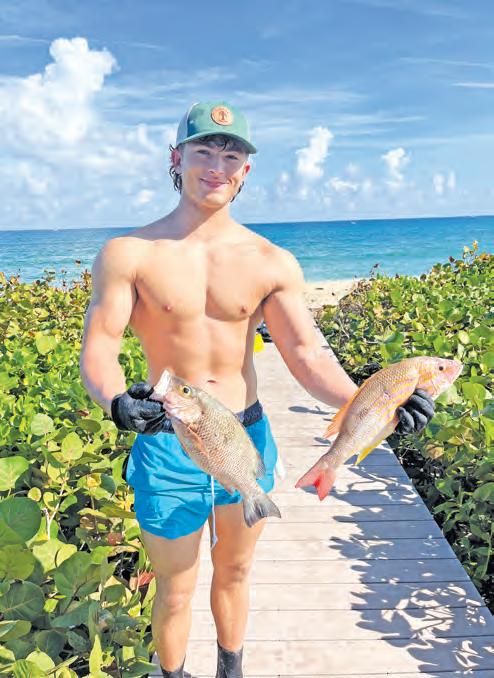
 By Christopher Sprague
By Christopher Sprague
deep holes will be where you will find all the species schooled up together. Sometimes I recommend if you are going to use live bait, try adding a split shot to your line to see if it gets through the school of stripers a little faster. Remember, the big fish are sitting under the smaller fish, watching the action and waiting for something to make it to them. Extralarge crank baits that run almost as deep as you’re fishing are a great choice for artificial. For fly anglers, I like to use a sinking line full length six weight. A bright colored Clouser bounced along the bottom will most likely produce a grand slam of bass, peacock, hybrid, striper, etc. Good luck out there!
I hope you all have been out on the water a lot and catchin’ those fish up! Lately, my friends and I have been doing shore dives, and one trip in particular went extremely well. We went off the beach and headed out to the reef where we were met with a beautiful sight- the entire reef was uncovered by the last big storm, and all the structures were so much more prominent. When we saw this, we knew it was a good day. As we drifted, we saw lots of fish, however none of them were anything worth spearing. Then we started seeing some good fish; the first fish I shot was the biggest mangrove I had ever shot. I was so excited to get this fish and see the size of it. It barely fit in the bag that I use to hold the fish. As we kept drifting, we got an assortment of fish such as yellow jack, mangrove snapper, a monster lane snapper, and two nice serro mackerel. By far my favorite moment of the day was when I saw a huge mangrove snapper and I followed him into a rock where I saw a big lobster. I was then left with a choice, if I grab the lobster, the snapper would shoot out the rock, if I shot the snapper, by the time I got it out the lobster would be gone. I chose the second option; the snapper was so deep that I could only see a slight outline of it. Once I shot it, I then had to try to get it out of the hole which took around 15 minutes. It was extremely difficult, but what matters is I got both the shaft and the fish out and it was one of the most exciting and action-packed moments full of adrenaline. This ended up being a bigger mangrove than the one that I had previously shot. It was an absolute monster and we got two nice filets from it. I encourage all of you to get out on the water even though it might be cold, the fish are for sure out there waiting for you!
We will definitely see more of these crappie/specks as cold fronts move through.


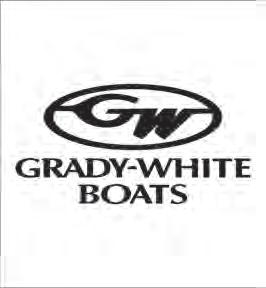
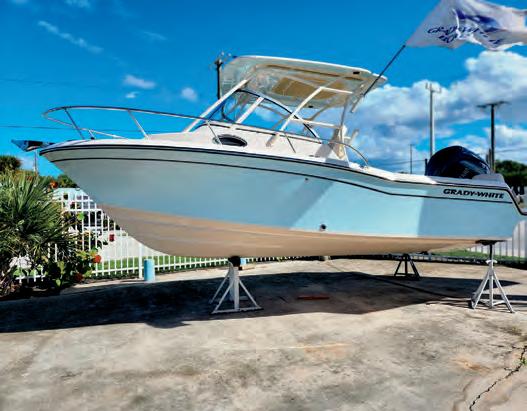
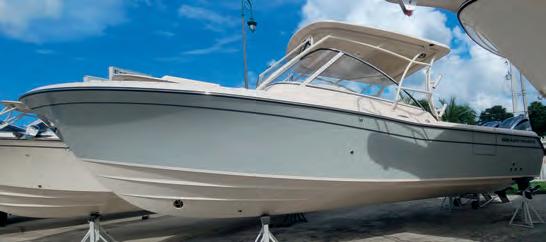




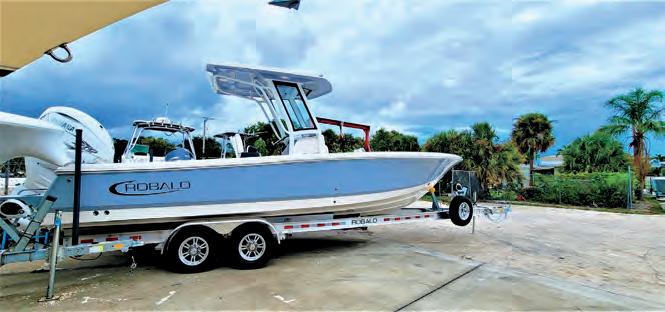


It’s always refreshing to look at the final results of the West Palm Beach Fishing Club’s (WPBFC) Annual Fishing Contest and see just how many incredible fish were caught throughout the angling year (November 1st – October 31st). When you see catches like a 57 lb. 5 oz. Dolphin caught by John Fiorentino, a 7 lb. Spotted Sea Trout caught by Mike Mathias, or a 54 lb. 9 oz. Yellowfin Tuna caught by John Gambino, you know you’re always just one bite away from the fish of a lifetime. All of these fish were caught in Florida waters. Both adult and junior anglers entered a variety of different species in numerous tackle categories.

Junior Angler of the Year, Charlie DeBay, with a 10 lb. 5 oz. snook caught on fly 20 tackle at the St Lucie Inlet.
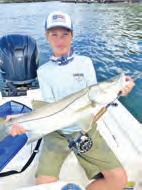
Adult Angler, Amanda Thaw, with a 4 lb. yellowtail snapper caught on spin 8 tackle off the Juno Ledge.
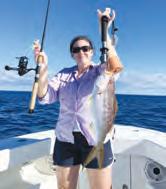
Fifteen-year-old Charlie DeBay of Palm Springs earned the title of Junior Angler of the Year in 2022, demonstrating true angling skill and dedication to fishing. Between school and other extracurricular activities, it requires a true effort for these young anglers to make the time to target the appropriate species needed to qualify for this award. When kids are passionate about fishing and the outdoors, it’s a sacrifice they’re more than willing to make. Charlie proved this to be true as it was his 2nd consecutive year winning this competition. Impressive fish like a 15 lb. 10 oz. Bonito and a 10 lb. 5 oz. Snook both caught on fly 20 tackle were included in his resume. A tip of the cap to this young man on his back-to-back Junior Angler of the Year accomplishment.
The Grand Champion Adult Angler award is arguably the WPBFC’s highest angling honor recognizing the best fisherman, or woman, in the club. For just the second time in the history of the Club’s angling programs, a lady angler took top honors. A special congratulations goes out to Amanda Thaw of Palm Beach Gardens for posting a truly impressive resume of catches to earn this title. Amanda was
Junior Angler of the Year, Charlie DeBay, with a 15 lb. 10 oz. bonito on fly 20 off Jensen Beach.
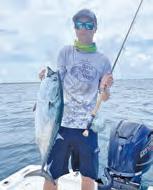
John Fiorentino’s 57 lb. 5 oz. dolphin caught on 30 pound tackle off Palm Beach on an artificial lure.
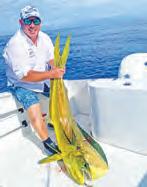
BBQ & Auction.
strategic and persistent in her approach to posting winning fish that would beat out other angler’s catches. She put a strong emphasis on landing fish with spin, plug and fly tackle in the Club’s “casting categories” on artificial lures. A 19 lb. 8 oz. Jack Crevalle and a 4 lb. Yellowtail Snapper on spin are two great examples of how she was able to entice the bite while manipulating lures throughout the angling year. All skill aside, it also doesn’t hurt to have a little stroke of luck come your way as well. Amanda was fortunate enough to have a hungry 12 lb. grouper eat her flatline bait one early afternoon off Jupiter. This fish was landed on 12-pound test line, lighter than most bring offshore. Great things happen when you’re spending a lot of time on the water. It’s a good sign to see anglers going after this prestigious award each year, and all the bragging rights that come with it.
Lastly, over 30 trophies and new PENN Fishing rod & reel combos were awarded to WPBFC’s Pee Wee Champions, kids age 10 and under who entered a fish in the Annual Contest. The Club has a long history of keeping kids excited about fishing. The prizes are a way to acknowledge their efforts and help cultivate the next generation of anglers who are sure to catch many more impressive fish in the future.

John Gambino (left) with a 54 lb. 9 oz. yellowfin tuna caught off Palm Beach on 20 pound tackle while kite fishing.
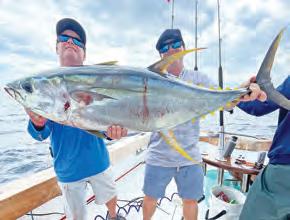
There’s always opportunity to get involved at the WPBFC. If you’re out catching great fish, be sure to join the club and enter your catch in the Annual Fishing Contest.
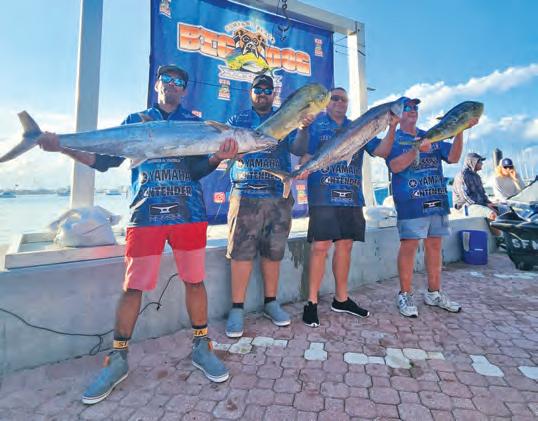
Team Spiced Rum III set out early in the morning and around 6:30am we noticed a board floating, so stopped to check it out. It had a lot of bait under it, so we went a few hundred yards south of the board and started fishing at 7am. Our GPS numbers were marking bait in 80 feet of water, where we immediately caught a nice kingfish on our Cannon Downrigger at around 80 feet down. Next, we started trolling towards the board in 130 feet of water off Juno Beach and hooked up on a double-header dolphin. Three more dolphin were caught during the day in about 20 feet of water in front of Jupiter Inlet; up to 13lbs. A half hour before lines out, the team caught our other big kingfish in 80 feet of water off Juno Beach on our Optimum Downrigger with our SOLIX Gen 3 that put us right on the fish. We won Big Fish Overall with a 32.3lb king and the two biggest fish of the tournament. We also won Three Fish Aggregate, 5 Fish Aggregate, and High Roller. Team Spiced Rum III also came in 2nd place SKA and Sherri Beswick won Top Lady for the year in the Southern Kingfish and Angler Armory series. I could not do this without my crew and sponsors:
tuppen’s marine, Yamaha Outboards, loadmaster aluminum Boat trailers, contender Boats inc., humminbird, cannon, canvas Designers, caddycan, Gill media, Dead end ink, Native Boyz, t V apparel, admiral Nelson’s rum, Deep eddy Vodka, airmar technology corporation, canvas and towers, Juno Bait, XGeneration rods, connley Fishing, kluch apparel, american Fishing Wire, Jl audio, atlastrax, aFtcO, maxel Fishing, how Ya reelin Fishing Sales & tackle, Searcy Denney, Scarola, Barnhart & Shipley, pa, pearl kites, Sailfish marina, reel Battery Ocean-tamer, marine Bean Bags, Salt life, marine elec tronic Solutions inc., and latham marine.





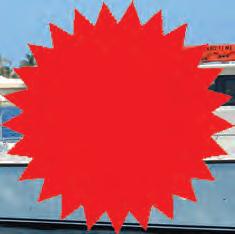


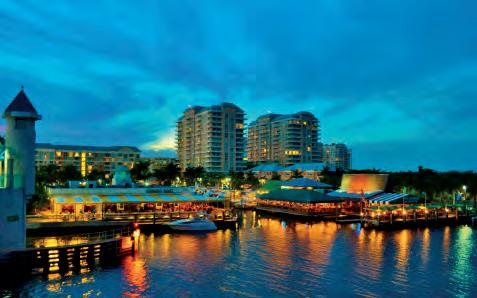



2.4 5:56 2.2 11:40 0.5 11:56 -0.2 7:08 5:40
6:44 2.5 6:42 2.3 12:25 0.4 7:08 5:41
7:26 2.5 7:24 2.3 12:39 -0.3 1:08 0.4 7:09 5:42
8:06 2.5 8:05 2.3 1:21 -0.3 1:49 0.4 7:09 5:43
8:44 2.5 8:44 2.3 2:00 -0.3 2:28 0.3 7:09 5:43
9:21 2.5 9:23 2.2 2:38 -0.2 3:06 0.3 7:09 5:44
9:57 2.4 10:03 2.2 3:15 -0.1 3:43 0.3 7:09 5:45
10:33 2.4 10:43 2.2 3:51 0.0 4:19 0.3 7:09 5:46
11:09 2.3 11:25 2.1 4:28 0.1 4:57 0.3 7:09 5:46



11:46 2.2 5:07 0.2 5:37 0.2 7:09 5:47
12:11 2.1 12:25 2.1 5:51 0.3 6:22 0.2 7:09 5:48
1:01 2.1 1:08 2.1 6:43 0.4 7:14 0.1 7:09 5:49



1:57 2.1 1:59 2.0 7:42 0.5 8:11 -0.1 7:09 5:49
2:59 2.1 2:58 2.0 8:46 0.5 9:13 -0.2 7:09 5:50
4:05 2.2 4:03 2.1 9:50 0.4 10:14 -0.4 7:09 5:51
5:09 2.4 5:09 2.2 10:51 0.3 11:13 -0.7 7:09 5:52
6:09 2.5 6:11 2.4 11:48 0.1 7:08 5:53
7:05 2.7 7:09 2.6 12:10 -0.9 12:43 -0.1 7:08 5:53
7:57 2.8 8:05 2.7 1:05 -1.1 1:36 -0.4 7:08 5:54
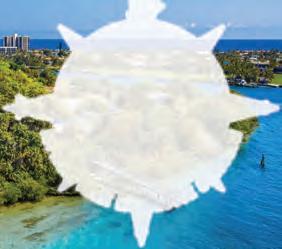
8:47 2.9 8:59 2.8 1:58 -1.1 2:29 -0.5 7:08 5:55
9:35 2.9 9:52 2.8 2:50 -1.1 3:20 -0.7 7:07 5:56
10:22 2.9 10:44 2.8 3:42 -1.0 4:12 -0.7 7:07 5:57
11:09 2.8 11:38 2.6 4:35 -0.7 5:05 -0.7 7:07 5:57
11:57 2.6 5:29 -0.4 5:59 -0.6 7:07 5:58
12:32 2.5 12:46 2.4 6:25 -0.1 6:54 -0.5 7:06 5:59
1:29 2.3 1:38 2.2 7:23 0.1 7:52 -0.3 7:06 6:00
2:30 2.2 2:35 2.1 8:24 0.3 8:51 -0.2 7:05 6:00
3:33 2.1 3:35 2.0 9:25 0.5 9:49 -0.1 7:05 6:01
4:35 2.1 4:35 1.9 10:23 0.5 10:44 -0.1 7:04 6:02
Happy New Year from the Coastal Angler Magazine, it’s going to be a good year! Fishing was epic in the month of December and I’m sure it’s going to continue into January. This is the time to live bait. Pelagic fish will be migrating from the north and hitting our funnel which is right at Jupiter Inlet. You can catch everything, such as sailfish, tuna, wahoo, and kingfish all in the same depth. My suggestion is to head out of Palm Beach Inlet and head north to the 45 line. That’s your top number on your longitude latitude and that’s what most of our guides use as reference points. Position yourself out deep in the 300-foot range when the wind is from the northeast. If the wind is from the northwest, position yourself in the 80-foot depth. On a regular day, we set the kite up on the starboard side of the vessel and fly 2 or 3 baits, then on the port side, we put 2 flat lines out with live bait and 2 deeper baits with breakaway sinkers. If we were really going after the prize, we also send somebody down with a knocker rig for snappers. This system has proven effective time after time and is used by most of the professional guides. Going to the north this time of the year is always the best, but there could be fish to the south as well, so call around the evening before you go fishing and try to figure out what’s best. Information is only good for about a day, so if you hear people are crushing dolphin on Saturday and you are going out on Wednesday don’t expect the same results. Another way of getting some good information is putting the VHF radio on channel 19 and calling out to vessels and see what they’re catching. Generally, people will talk back to you and let you know what’s going on. For some reason
people just love to talk on that VHF and they will definitely spill the beans.
For the nearshore anglers, the beaches and inlets will be holding jacks, permit, and sheepshead. Expect the best bites on the coldest days. It’s awesome to see the steam come off the water first thing in the morning while watching tarpon rolling and jacks tearing baits up on the surface. Lighter tackle is the way to go and makes it the most fun. When fishing in the inlet, remember that it is a waterway for large ships and some of these container boats cannot stop. Please get out of the way when you see them and give them plenty of room so they can maneuver straight through. Tight lines my friends!
Logan with a tarpon.
Happy New Year! Hope your new year is full of drag screaming action. Enjoy the waters with friends and family targeting a plethora of species.
January is a great month to target snook in the shallows and near dock pilings during mid-day. Sight fishing for snook using top water Rapala Skitter Walks and D.O.A. C.A.L. 3” Shad Tail baits. Live baits will entice the snook to strike near sea walls and channel edges. The bigger snook can be found around bridges or deep holes ranging from 5 to 20 feet. When targeting snook, look for structure or a ledge were snook might be holding. D.O.A. TerrorEyz and D.O.A. C.A.L. 3” Shad Tail in stark naked and pearl colors work great along with live baits dropped to the bottom.
Tarpon fishing in the back country is always fun for anglers using light tackle and fly. Tarpon from 5 to 40 pounds can be targeted using D.O.A. TerrorEyz and live bait. Even bigger tarpon can be
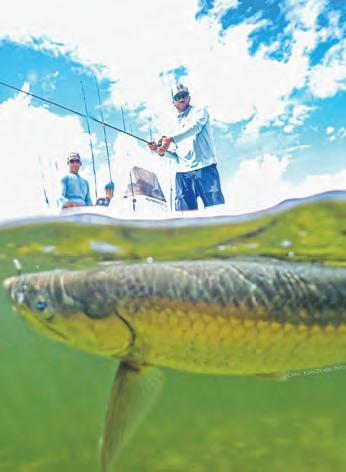
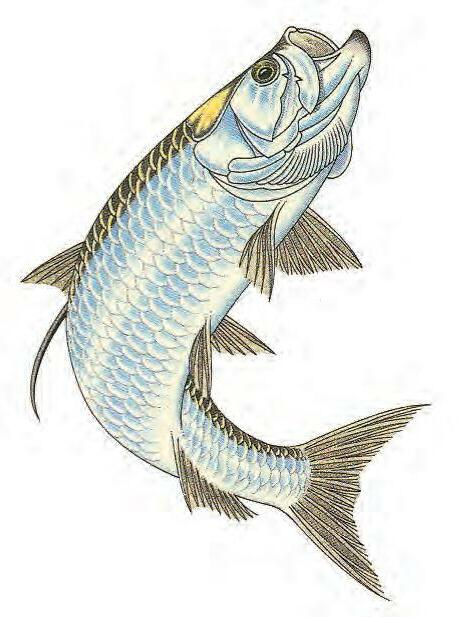

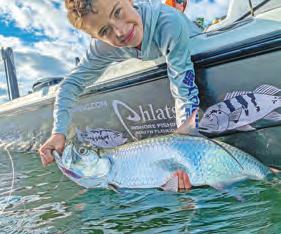

found near inlets and channel edges. Again, D.O.A. TerrorEyz and live baits worked near the bottom entice strikes.
The grass flats are full of life this month. Fishing the flats is fun for the whole family, due to the wide variety of species that can be caught. Bucktail jigs tipped with shrimp is an excellent bait of choice for most anglers in this area, but nothing beats a popping cork with a D.O.A. Shrimp, it catches everything. When fishing the grass flats look for any bait in the area and work the water column from depths of 2 to 7 feet. Pompano, jacks, ladyfish, trout, and sheepshead are just a few of the species anglers will encounter while jigging. Once you find the fish try and mark that spot and work it hard, doing this will keep your rods bent all day long.
Well, that is the fishing report for the Palm Beach and Jupiter area, hope you all enjoyed. Just remember, you can’t catch them from the couch, fishing is all about the experience. Tight Lines!
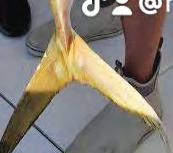
Hello everyone, hope you enjoyed the holidays and you’re ready for 2023!
I always look forward to the start of a new year and the mix of new year resolutions that people make for themselves. While traditionalists seem drawn to plans to lose weight, exercise more, or give up bad habits, there’s a huge variety of resolutions floating around out there this time of year.
More trendy types seem to gravitate toward dramatic lifestyle changes that rhyme with the new year, like “Gluten Free in ’23!” or “Mindful Me in 23!”.
Personally, I like a little bit of irony in my goals, as in “I’ll stop procrastinating...just not right now”.
But what if none of the usual resolutions are appealing this year? Well, if you’re into wildlife, nature and ecology, maybe it’s time to try something different and resolve to learn more about Florida’s unique ecosystems?
As a newcomer to Florida way back in 2001, I embarked on a similar path. And I have to say, discovering the richness and the diversity of Florida’s ecology was pretty eye-opening for me. So much so that it helped motivate me to craft an entirely different career path for myself!
There are a lot of different ways to learn about Florida’s ecology and

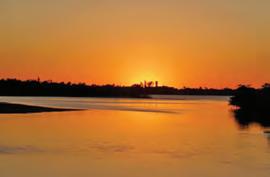
environments. Some people really enjoy individual study and research, while others get more out of classroom settings. Some learn best by doing, or by taking part in experiences like field trips, while others prefer working within a small group.
Regardless of your learning style, I can wholeheartedly recommend the Florida Master Naturalist Program (FMNP) to help guide and focus your eco-learning. It’s a module-based program offered through the University of Florida, and it has three core courses...coastal, wetland and upland systems.

Each course module focuses on one of those three habitat systems, and each helps explain how the various parts and pieces of work together within each system. Crucially, the courses also explore what happens when those parts and pieces stop working together, and what we can do about it.
Courses are offered statewide throughout the year and are meant for adults, which means that there’s a mix of days and times available. Some classes are offered in-person during evenings and weekends, some are online, and some are a mix of both.
FMNP also offers specialist courses that focus on more detailed areas of interest. These advanced courses include habitat monitoring and management, conservation, interpretation and habitat restoration.
Visit www.masternaturalist.ifas.ufl.edu for more info and details on how to register for courses near you. Both the Palm Beach and Broward County FMNP teams are active and often have a waiting list for participants, so be sure to check out their course offerings early if interested!

Hope to see you outdoors and on the water!
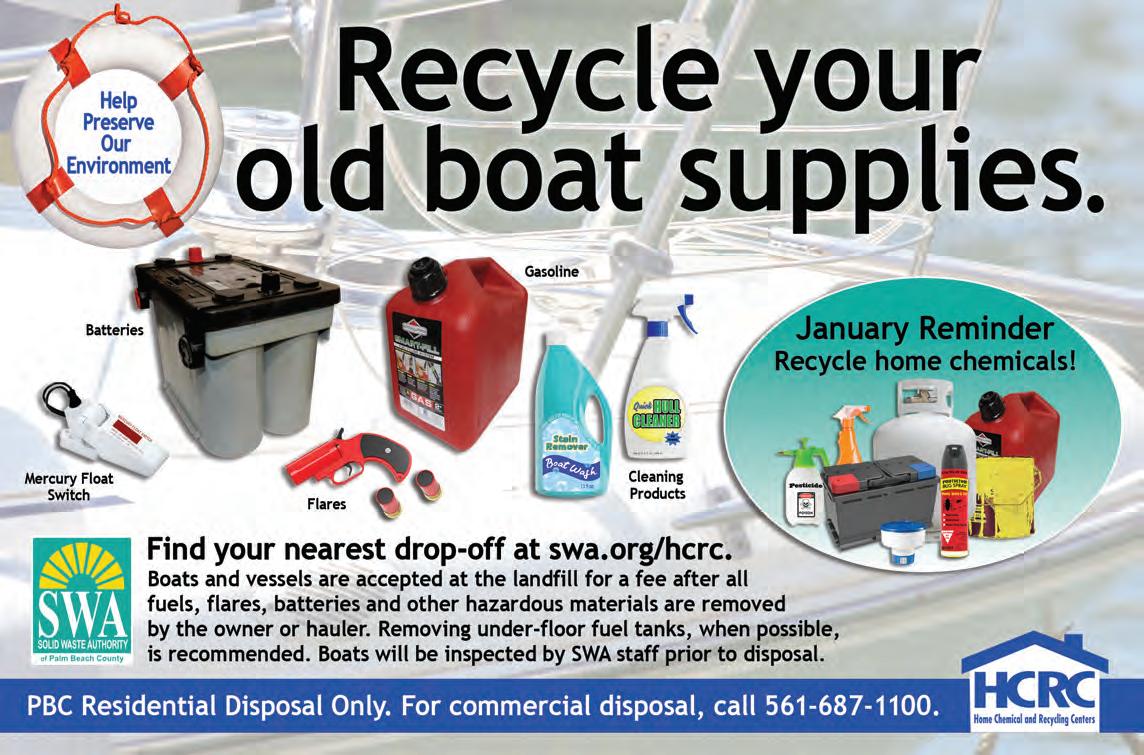
They say, “every picture tells a story”. This is the story of life on or near the reef systems that make up much of our local waters. As the year progresses, we can see the migratory patterns of species that live on or pass thru our magnificent coastal resources. This vibrant ecosystem is just a stone’s throw away from local inlets, harbors, and bays making them easily accessible to the boater. Yes, here on the east coast of Florida, anglers are truly blessed. Looking back on the year in pictures and the array of fishing opportunities as they unfolded was both a fantastic collection of memories and a learning experience.
Every photograph taken with an iPhone contains vital information like latitude / longitude numbers, time and date along with the picture, providing a logbook of information about each fish. This along with getting out on the reefs regularly can provide a treasure trove of useful information for the year ahead.
Fishing success directly correlates to time spent on the water. “You gotta be in it to win it” and there’s no substitute for the long hours actually spent fishing. Put your time in and you will be rewarded. I always correlate this to the rule of threes. It usually takes three days to fully understand and crack the code for what is unfolding on the water. All successful captains know there is no substitute for time on the water and the good ones are on the water every day. Recreational anglers don’t often have the opportunity to do this. So, we must take our best shot combining fishing when we can with some semblance of intel and forecasting. There is no better way of recording actual migratory patterns and events than these types of photographs and yearly reviews.
In combination with having the time to fish, one must also have a safe way of getting there. Offshore fishing success begins and ends with the right fishing platform. At the start of the year, I took delivery of my Renaissance Prowler 301 – a catamaran styled center console and I couldn’t be happier with my choice. This vessel has been a game changer for me. With a soft, safe, and dry ride it has allowed me the freedom of running offshore again after multiple back surgeries had me on the sidelines. It also has a place for everything, trolls well and drifts perfectly –what’s not to love! This boat and local Florida builder have a legendary reputation among hardcore anglers and divers.
The beginning of 2022 also saw the launch of my successful collaboration with Coastal Fishing Company to bring to market a series of rods designed from countless hours on the water. This combined with the use of select Rapala lures and jigs, have opened up new fishing opportunities for me and my crew.
With everything lined up for a successful run at the various seasons, I set aside the time to get out a bit more consistently and it definitely paid off with some “best of” catches. Having the right tools for the job contributes mightily to your overall success.
January, February, and March saw me fishing hard on the reef as the winter winds kept me from getting further offshore with any consistency. I focused primarily on live bait fishing either right on or just off the reef and for my favorite winter target — the acrobatic sailfish. This led to some additional catches such as blackfin and skipjack tuna, the occasional mahi, and giant amberjack off the local wrecks.
Pro TiP - Amberjacks fight like no other fish and are absolutely delicious when smoked.
Persistence and the “rule of threes” led to my first “Jupiter wahoo”, served sashimi or sushi style, there’s no better tasting fish.
Next up was a personal best mutton snapper caught fishing the Jupiter reef during the winter spawn. These are one of my absolute favorite bottom fish to both catch and eat! Caught on a live goggle eye and on a spinning rod it was quite an accomplishment. Especially getting it to the boat and not having it eaten by sharks which have become a real nuisance here on the reef.
Pro TiP - When bottom fishing the local reef system, I always put out free swimming unweighted baits below the surface. That big mutton came up to eat a free-swimming goggle eye!
We also experienced some additional catches consisting of African pompano, rainbow runners, kingfish, and a few big barracuda which can put on an amazing arial display. Rounding out the winter fare were the migratory blackfin tuna and assorted edible bottom fish.
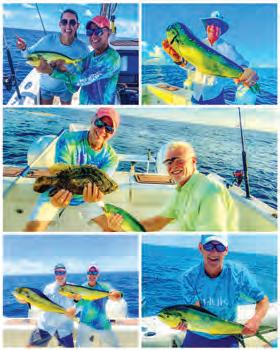
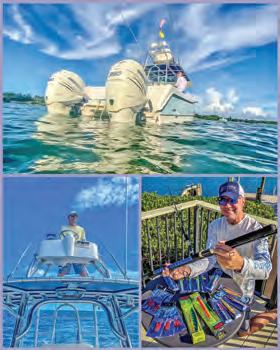
Early spring saw the migration of larger mahi to our area and led to some really nice fish right off the drop-off and out to about 300 feet. As the water temperature warmed and the abundance of weeds formed defined weed-lines, June and July brought some excellent offshore “run and gun” style fishing with plenty of school mahi to be had. As an added bonus we put numerous tripletail in the cooler including a personal best fish. If you haven’t eaten one — these fish are delicious and a must try culinary treat!
The fall transition brought Hurricane Ian but also one of my most memorable days on the water this year. We went out post storm and ended the day with a bit of everything — tripletail and mahi offshore and snowy grouper, red snapper inshore rounded out the table fair. Some of my favorite eating fish that are all amazingly prepared any way you like! Post storm fishing at its finest.
So, as I reflect on this year’s success, I also vow to spend more time on the water in the upcoming season and stay focused around consecutive days fishing. That’s what always leads to the best fishing days and maybe your next trophy. Can’t wait to see you all out on the water and in the new year!
mark ambert, marksgonefishing™ author – avid outdoorsman, sports writer, and photographer. contact marksgonefishing25@gmail.com

renaissance prowler renaissanceprowler@gmail.com (305) 602-1965 https://www.renaissanceprowler.com rapala https://www.rapala.com
Gear used – coastal Fishing company made exclusive for the angler by anglers. www.coastalfishing.com www.coastalfishing.com/collections/fishing-rods-1/ products/ 3-in-1-slow-pitch-jigging-rod
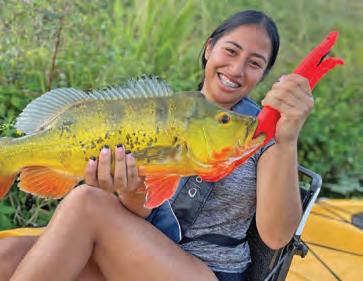
772-201-5899
• Brian@tckayakfishing.com
• tckayakfishing.com
Your guide with a good sail.
Jesse with a stud peacock bass.
Pompano, bluefish, jacks, and Spanish mackerel become more of the focus in January. I like to target areas near the inlets like the mouth of the Loxahatchee River in Jupiter and Palm Beach Inlet area. The deeper channels and sand flats make them ideal locations for the fish to swim in and out with the tides. Try working the edges of these channels with goofy jigs, small bucktails, and D.O.A. Shrimp. This time of year brings cold air and wind which in turn creates wet conditions on the kayak. A pair of Frogg Togg waders will keep you dry and warm in the chop.
January is considered one of the best months to target sailfish. As always, winter months are very weather dependent. There are typically only a handful of days during this month that the weather will allow you to get in the ocean without dumping your kayak in the process. Choose your days wisely and be sure to have all safety equipment on board. Look to have a variety of baits; some big and some small.
Pilchards, goggle eyes, and runners are at the top of the list. Keep them up on the surface and frisky and you should get a few bites.
Peacock and clown knifefish bites should be in full swing unless we get super cold weather. Target concrete structure for bites from both species. Live shad or shiners are at the top of the list for live bait, but bring along a few rattle traps for the artificial bite.
Check us out Pushin’ Water Kayak Charters on Facebook, Instagram, and YouTube for all the latest adventures my clients and I get into.
See you on the water!
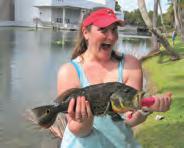
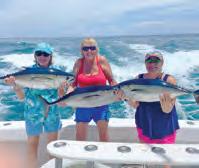

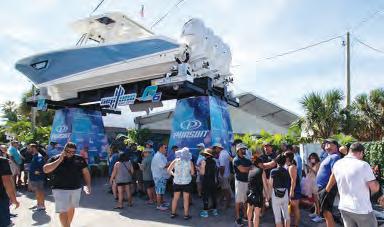

The popular “Ladies, Let’s Go Fishing!” University will kick off 2023 with two events for women and families to learn fishing. New for 2023 is Miami Offshore Fishing on Sunday, February 5 aboard the Reward with Captain Wayne Conn out of Miami Beach Marina. Participants will learn fishing skills on the boat and target sailfish, tuna, and bottom fish for an afternoon half day trip. Registration is $30 and charter fishing is $85. Class is limited to 25.
On Saturday, March 4 LLGF will conduct a freshwater fishing seminar with guided fishing at Bass Pro Shops, Dania Beach, FL from 9 am to 3 pm. The educational event with speaker Capt. Brian Leibowitz offers classroom instruction, conservation, hands-on fishing activities, networking, a guided fishing experience for bass and other species, as well as gifts. The event includes an all-release fishing experience from the shore of a private lake known for its elusive peacock bass; with rods, reels, bait, and fishing tackle supplied. Registration is limited to 25.

The FLIBS (Fort Lauderdale International Boat Show) once again held its status as the largest in-water boat show in the world, achieving an attendance of over 100,000. Owned by the MIASF (Marine Industries Association of South FL) and produced by Informa Markets, this year’s show dates were October 26-30. Next year’s dates have already been announced of October 25-29 so mark your calendars. So far research has reported that this FLIBS has shown a statewide economic impact of $1.79 billion, with more than $800 million in sales happening at the show itself. Of course, on top of all the amazing exhibitors that were both in and out of the water and available content series at the Broward County Convention Center, there was such a great focus to detail to the available upscale food and beverage options for attendees. Luckily for FLIBS, Hurricane Ian didn’t impact the delivery of the show, but the FLIBS team took advantage of their event to provide some relief to the folks who were affected as well as their continued initiative on their overall charitable efforts. Andrew Doole, President of U.S. Boat Shows, stated “Our thoughts and prayers, and support are with our family, friends, and customers on the west coast of Florida. Our support from the U.S. Boat Shows will continue until they are back on their feet”. Also, this year included building awareness for life-saving cancer research led by South Florida’s leading healthcare institution, the Moffitt Cancer Center, and Memorial Foundation. Alongside Informa Markets, MIASF, Intrepid PowerBoats, Reef Runner Boats, and ICON Electric Vehicles, FLIBS raised over $30,000 to help this year’s philanthropic



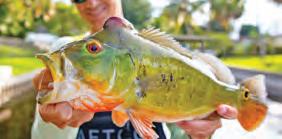
Happy anksgiving to all anglers! Cool fronts start to bring comfortable weather. Water temperatures will start to cool down and predator sh begin to push into back bays, canals, and coves.
South Florida Fishing Charters • (954) 440-5200 • sflfishingcharters.com
Snook shing in Jupiter and Palm Beach will o er anglers steady action along seawalls, mangroves shorelines, and channel edges. Sight shing on the ats is another option for those who enjoy watching the bite. A D.O.A. C.A.L. 3” Shad or D.O.A. 3” Shrimp presented in the right spot gets the drag screaming.
appy New Year! January is the one month historically where we get our South Florida “winter”, some days it will be 90 and others maybe in the 40’s. Fishing can be exceptional if you pick the correct days to fish.
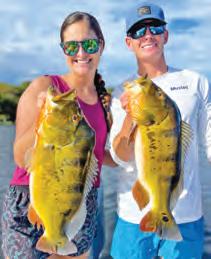

Night shing is a great alternative for snook fanatics; target dock lights with a D.O.A. Shrimp, Deceiver Flies, live shrimp, crank baits, and top water plugs.
Fall weather drives tarpon into back bays and canals o ering excellent shing for the silver king. Tarpon are prevalent inside the ICW, mangrove shorelines, docks, and deep passes. Live shrimp dri ed with the tide is the best bait, other baits like mullet, pin sh, and greenies work as well. Arti cial enthusiasts, the deeper passes o er plenty of shots on D.O.A. Bait Busters or D.O.A. C.A.L. 3” Shad in Arkansas glow or alewife with a jig head. Tarpon this time of year range from 10 to 60 pounds.
Any day you can get out on the water is a good day, however some will prove better than others in January. You want to be fishing those days prior to a cold front arriving, as they will produce the best number of fish. Pre-front fishing has ups and downs as the weather is typically unfavorable while the front pushes through, bringing wind and rain. During this time the fish will be aggressively feeding preparing to lay low for the next couple of days.
November o ers great action for big jack crevalle on the ICW water ways. Jacks will pounce on Rapala Skitter Walks or live bait in the vicinity of seawalls, docks, or open water ats. e jacks are schooling sh averaging 5 to 25 pounds. Battling jacks on light tackle or y is something an angler will never forget, come experience the tussle yourself. Well, that is the shing report for the Palm Beach and Jupiter area. I hope you all enjoyed, so get out there and get hooked up. Tight Lines!
Winter is a great time to target largemouth bass in South Florida using a smaller and maybe slower moving presentation. I prefer power fishing with jerk baits and swimbaits most of the year, but this is the perfect time to break out those finesse setups and throw those Ned rigs and worms. Some of those pre-spawn bass will be all fired up and that’s when you can attempt to catch your PB! My best advice to give to you while fishing this January is to keep a positive attitude and don’t be afraid to change it up. Most days I bring a minimum of 3 rods rigged and ready to go.
Captain Craig Korczynski 561-644-4371 • phlatsinshorefishing.com Facebook, Instagram, Twitter & YouTube

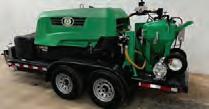

1.Medium heavy casting with 50lb braid (swimbaits).
2.Finesse spinning rod (Ned rig).
3.Medium casting rod with 25lb braid (jerk baits and stick baits).
If you have room for a 4th rod, bring a flipping and punching setup. If you find a mat of hyacinth or lily pads on a sunny day, those plants will help warm the water and fish will stack up under them on those chilly days.

The Everglades water level is still high and hopefully starts dropping soon. When the water level is up it’s a great opportunity to get out on the flats and chase some of those large female bedding bass. Pick a dark colored swim bait like a “Big EZ” and go out there and have a blast!
Peacocks in the Everglades have moved north in large numbers over the last few years since recent efforts of routing Lake Okeechobee’s water south like it had historically. They opened up a lot of waterways allowing great numbers of peacocks to move up and above ‘Alligator Alley’.
When the water level drops its game on! Let’s hope for low water this late Winter/ Spring season.

The exotics during winter on the Lake Ida Chain… we’ve been finding big schools of peacock bass deep in 12 feet of water or greater, and many fish over 5 pounds! When you’re fishing deep it opens opportunities to catch clown knifefish also. My deep-water rig is a very simple #2 BKK Octopus Hook on a 15lb fluorocarbon leader and a medium size split shot about 15” up from the hook. Soak live shiners on the bottom and wait for the bite! Remember this time of the year the fish are slower. I like to fish with the bail open and let the fish eat those live baits for a full second before setting the hook. Tight lines!
To see pictures of tournaments and events email 57LDBryant@gmail.com for link 561.721.5249

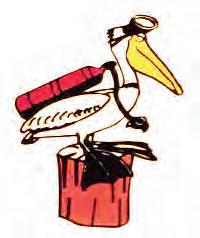

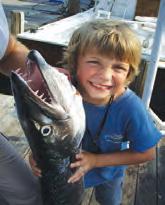
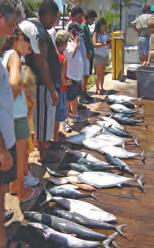
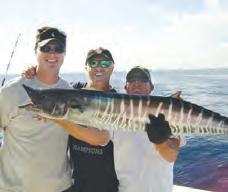
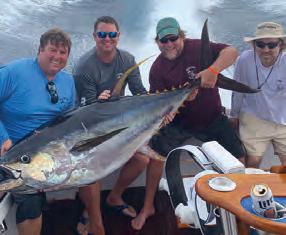

c apt. rOD rOYD h O u S e
New Lattitude Sportfishing • (954) 707-2147 • www.NewLattitude.com

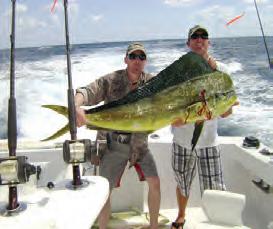
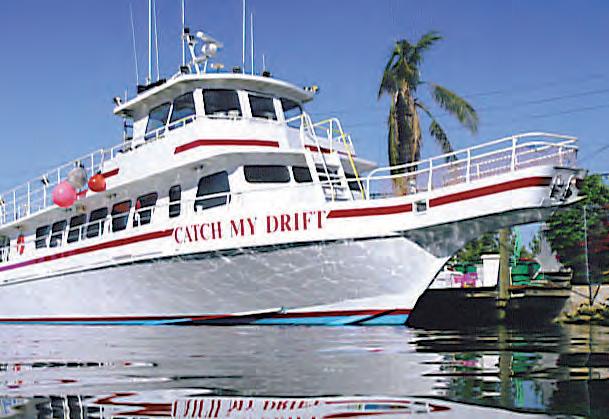
Sailfish, sailfish, sailfish. The sailfish bite is on! Big game anglers wait the entire year for the explosive sailfish action we have off our coast this month. With prime sailfish territory just a mile off our coastline, you won’t find a more convenient place to go sailfishing with such a concentration of sailfish than Fort Lauderdale. The area a mile off our coast, just outside the reef and on the edge of the Gulfstream in about 120-180 feet of water, is known as Sailfish Alley. This is one of the most productive sailfishing grounds in the world and it’s right in our backyard. There’s a funny saying that Fort Lauderdale is the only place in the world where you can snap a picture of a sailfish jumping, with a condominium in the background. The cooler weather gets the sailfish even more active, making this month one of the best times of the year to come catch these highly prized gamefish. One of the best things about sailfish is the technique we use to catch them. Kite fishing is the best technique to catch sails. Using kites, we suspend our live baits out on the surface of the water so that they are splashing and making fish-in-distress vibrations. Sailfish and other surface feeding gamefish pick up on these signals from a good distance away. When the sailfish comes up to eat the bait, you get to watch the whole bite sequence, where the sailfish chases the bait around and tries to get it into his mouth. It’s a spectacle and worth experiencing at least once in your lifetime.
Mahi mahi will also be biting great this month. Five-to-ten-pound mahi are scattered on and outside our reefs in 100-500 feet of water. Trolling is the best method to target mahi because it allows us to cover a lot of territory out there, giving us excellent chances at also hitting tuna, wahoo, kingfish, and other species. Mahi mahi tend to travel in groups, or schools, so if you hook one, keep a watchful eye out for his friends to follow him in as you fight him to the boat. Be ready with a pitch bait to throw out there if you see any trailing dolphin. When trolling, we like to fish over the reef, around shipwrecks, along seaweed lines that form from a wind or current edge, floating debris or underneath birds, which are all great indicators of fish below. Monster wahoo usually bite this month, especially around the full and new moons. Schools of tuna begin forming up this month. Usually they are small blackfin tunas, but occasionally a big yellowfin gets caught. This is a great season to come fishing with all the most desirable fish biting. To all those fishing in Fort Lauderdale this month, tight lines!
9:08 2.5 9:10 2.3 2:47 -0.2 3:15 0.3 7:08 5:45
9:44 2.5 9:50 2.3 3:24 -0.1 3:52 0.2 7:08 5:46

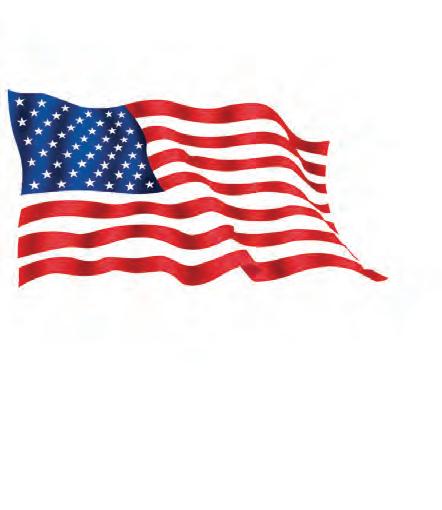
10:20 2.5 10:30 2.2 4:00 0.0 4:28 0.2 7:08 5:47








10:56 2.4 11:12 2.2 4:37 0.1 5:06 0.2 7:08 5:48

























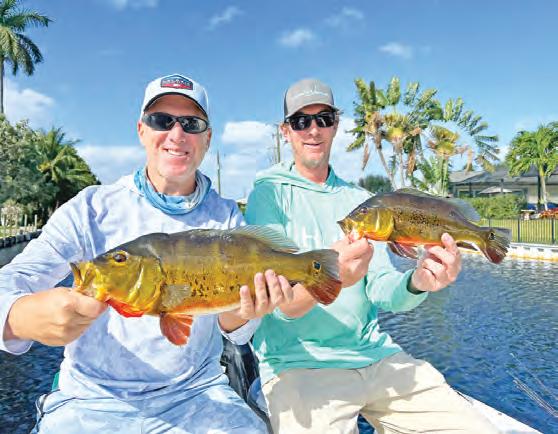
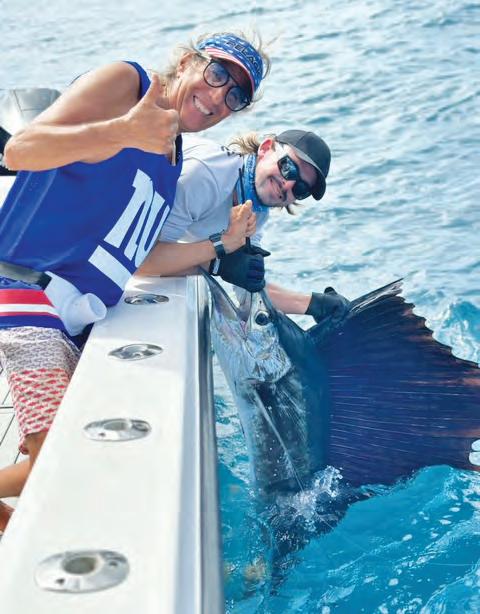
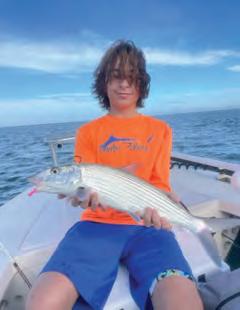

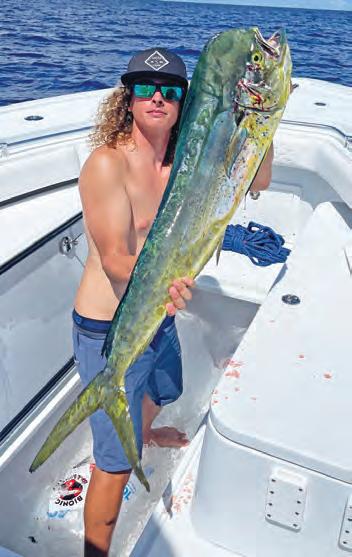
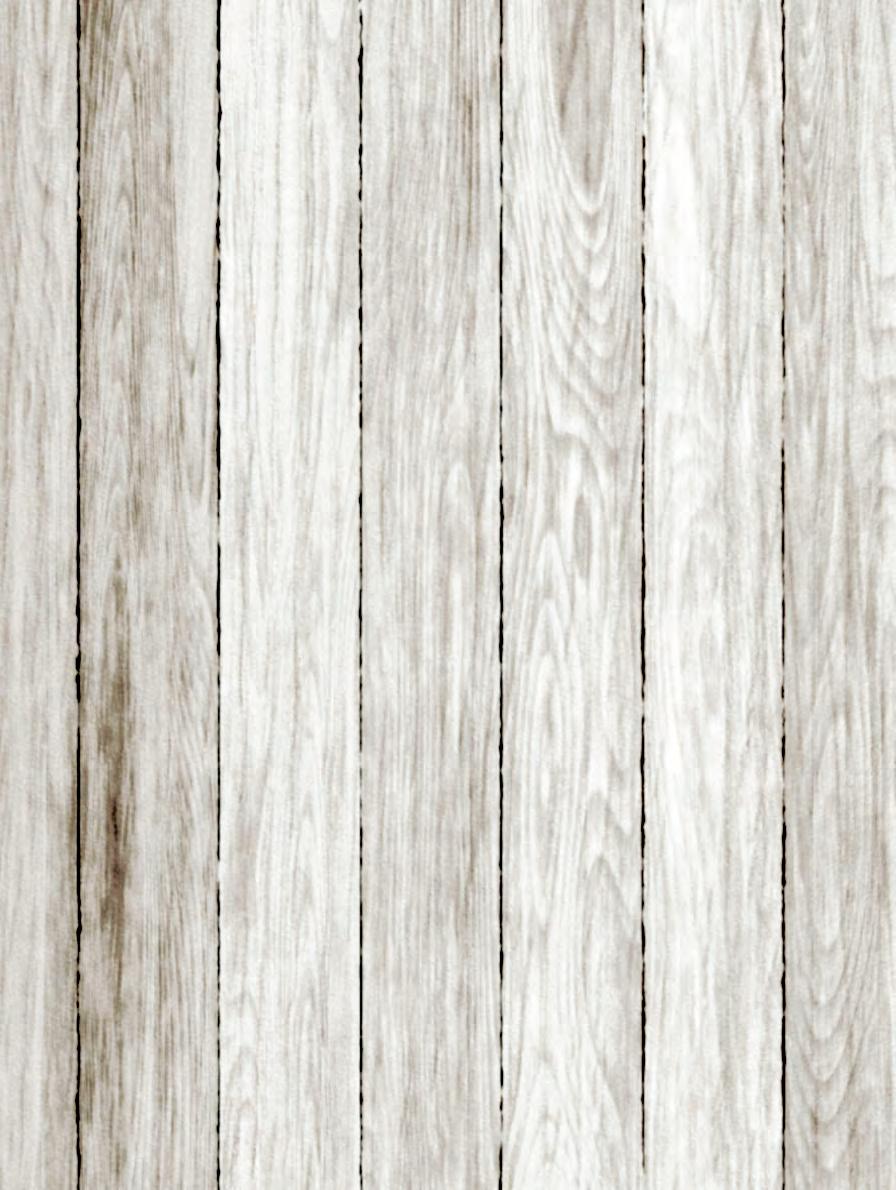


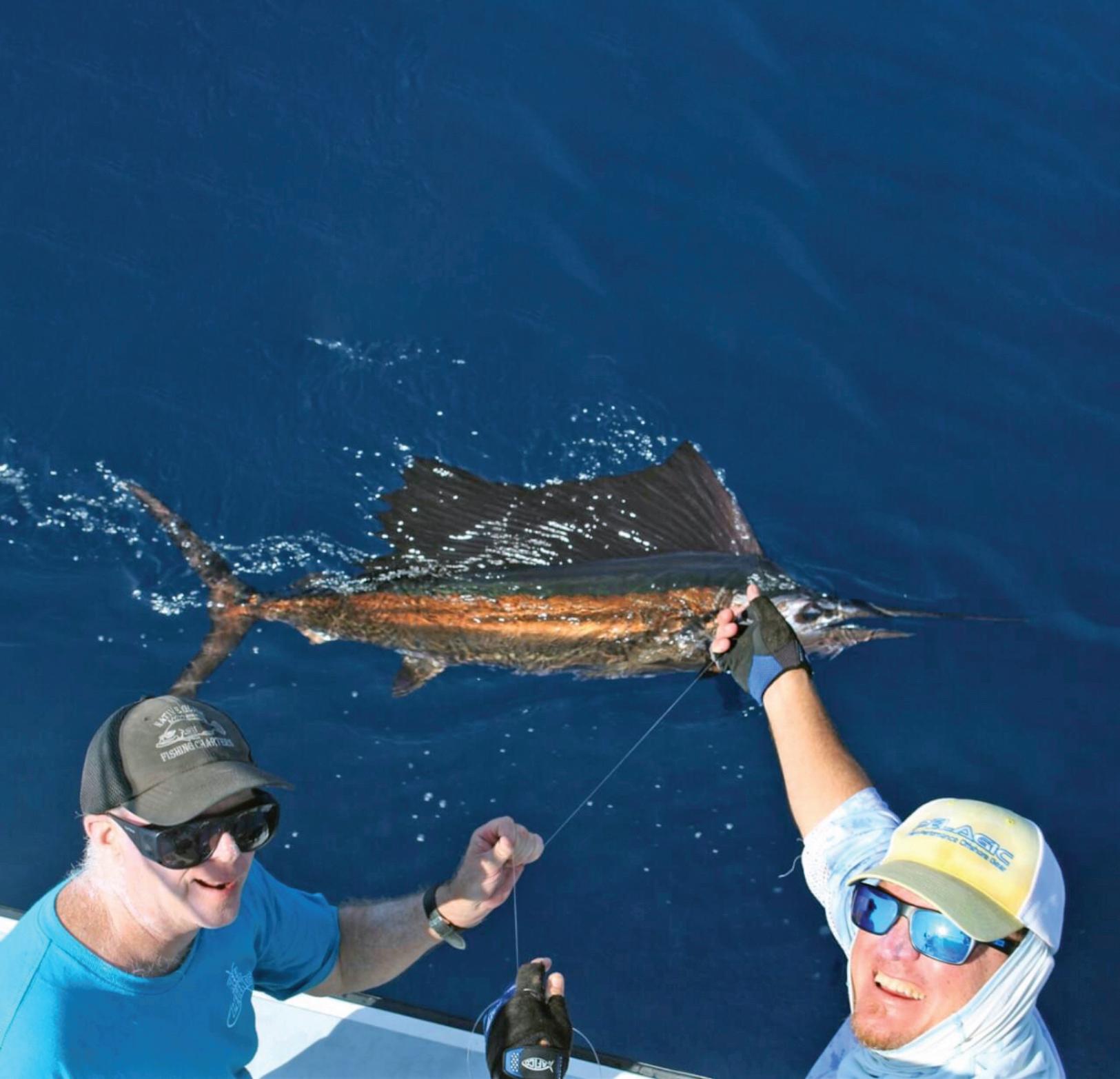








their anal n. ese long skinny sh are built for speed and can reach max speeds of about 70 mph.

Atlantic sail sh participate in seasonal migrations along the coast of America. Some sh will stay where they are, but most move northward in spring and south during the winter. is is due to the bait schools following the cold cycles. As soon as it gets hotter up north, they migrate. Once winter sets in, they return to Florida. Sail sh spend most of their time in warm surface waters of the epipelagic zone of the ocean. ey make frequent nearshore forays and congregate where water temperatures are in the 70 to 80 degree range.
ey begin spawning in spring, and this can occur as early as May or all the way into the fall. Like many other pelagic sh, sail sh use a process called external fertilization, or broadcast spawning. Males release sperm and females release eggs into the water current. Each female can produce about 4.5 million eggs. Once the sail sh hatch at around an eighth of an inch, they grow rapidly to about 6 pounds within a month. eir growth slows once they reach about 4 feet in length.
Capt. Charlie Stuve put me on my rst sail sh. He runs Native Guide Fishing Charters out of Jupiter, Fla., and sail sh are a favorite winter target for his clients.
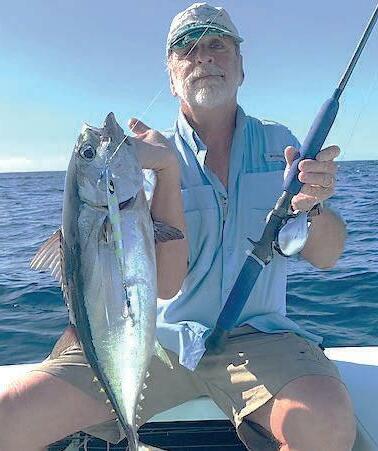


“I suggest live baiting,” said Capt. Charlie. “Goggle eyes are the most popular bait, but other baits work, as well. Kite shing is preferable with goggle eyes, but I also do well slow bump-trolling edges. Live thread n herring, Spanish sardines and pilchards are my favorites while dri ing on a color change.

Now that the cold has set in and will be here for a bit, we once again change focus on what we are catching. Most larger sh tend to slow down during winter months since it takes more energy out of them; however, this is not the case for sail sh. As long as you are brave enough to venture into the rough winter seas, you’ll be sure to get on the bite.
Sail sh are the sleek and slender member of the bill sh family. eir name comes from the extremely large dorsal n that extends over almost their entire back. ey also have long pelvic ns, which stretch almost to
“Depths can vary, so don’t use yesterdays information because conditions constantly change. Sometimes when the bite is slow, I like to bottom sh and y a kite downwind. at way you stay busy with the bottom action and when you least expect it you have a sail sh on your kite.”
e IGFA world record for Atlantic sail sh weighed 142 pounds, 6 ounces and was caught in Lobito Angola in 2014.
Emily Rose Hanzlik holds 56 IGFA world records in various categories. She hails from West Palm Beach, where she has a part time Bow n Guide Service as well as shing classes for Jr. Anglers. Find her on Social Media @emilyhanzlikoutdoors.


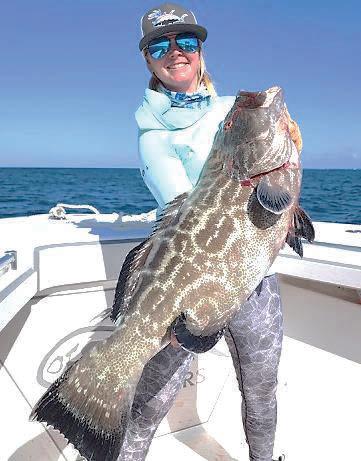
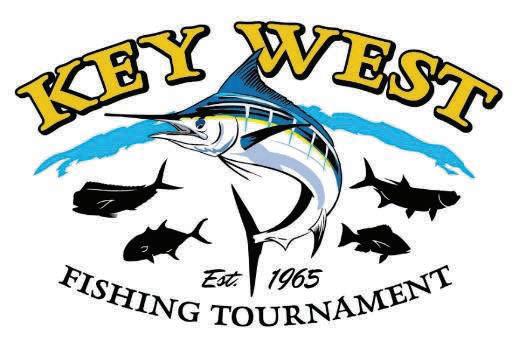








The FWC approved rules to help conserve Gulf striped bass in Wakulla County’s lower Ochlockonee River at the Nov. 30-Dec. 1 commission meeting.

FWC research has identi ed high rates of recreational harvest of brood sh (breeding sized) Gulf striped bass, and sta proposed rule language to change the harvest length limit. e bag limit of three sh per day for striped bass will remain in e ect. e proposed change to the length limit would change from 18 inches minimum size to no minimum size with only one sh allowed over 24 inches. Gulf striped bass populations are dependent on stock enhancement via hatchery production and protection of these larger-sized striped bass is necessary for the continued survival of the species.
“ is rule change is a positive step for Gulf striped bass, an important sport sh in Florida,” said FWC Commissioner Gary Lester. “We appreciate sta working with stakeholders on these ongoing conservation e orts for the future of this shery.”

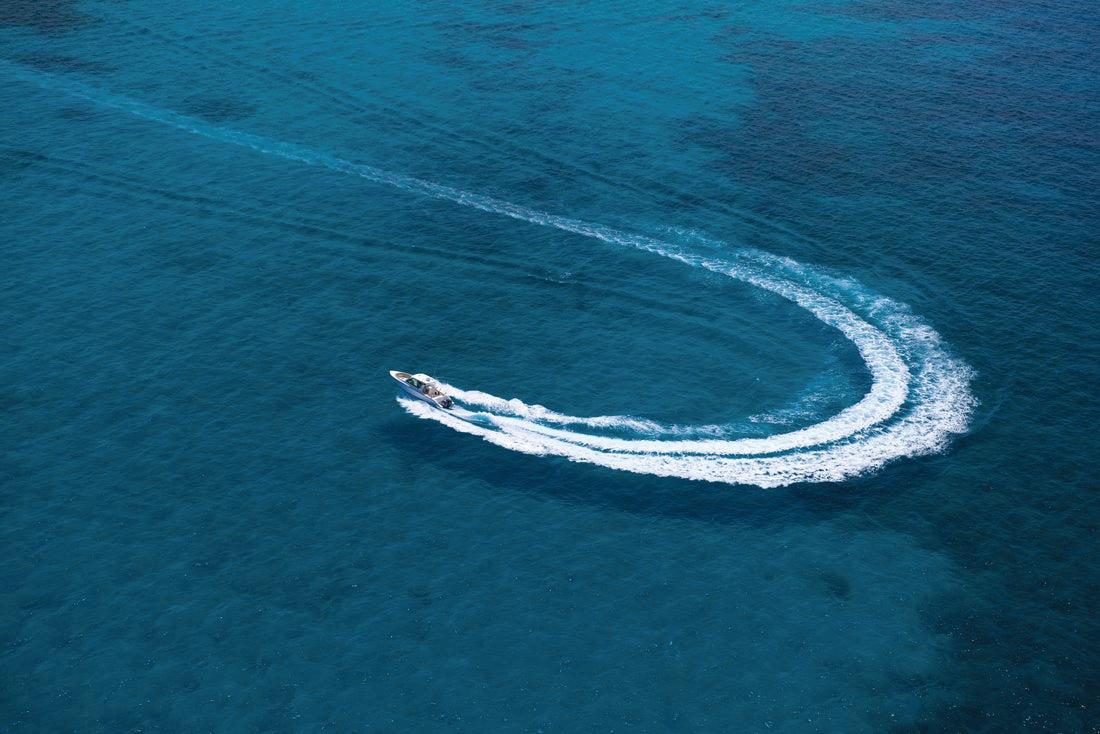
Sta held public meetings with local anglers to discuss research and management options for this shery at Lake Talquin in May 2022 and an additional meeting in November to discuss the rule language. Anglers were supportive of using regulation changes as a management tool. Further stakeholder engagement will occur on this rule.
Email Christopher.Paxton@MyFWC.com with questions, or visit the striped bass pro le on MyFWC.com.
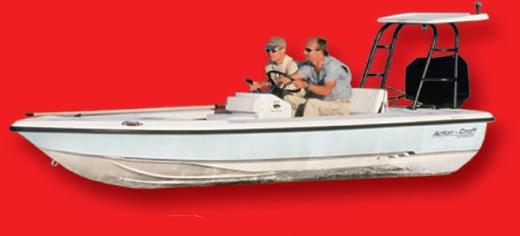
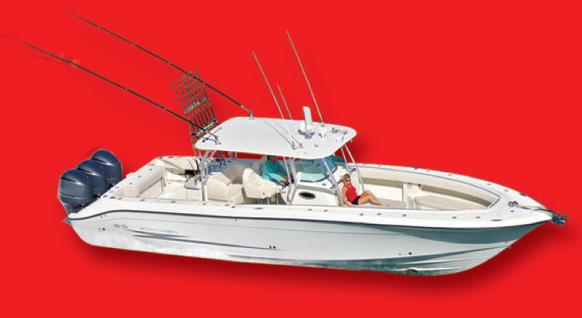


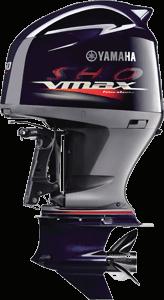
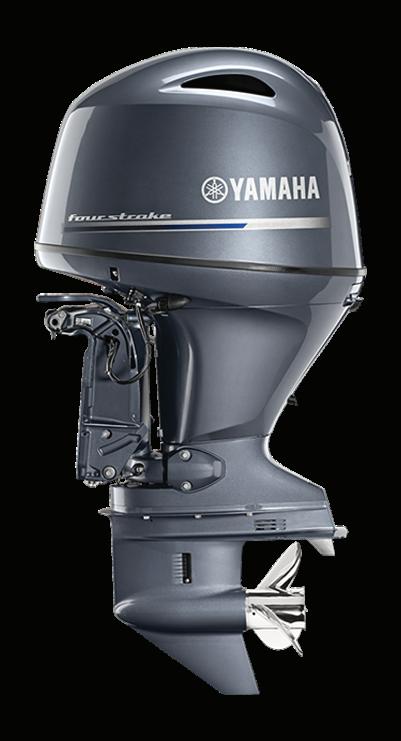











Let’s grow with Florida together.
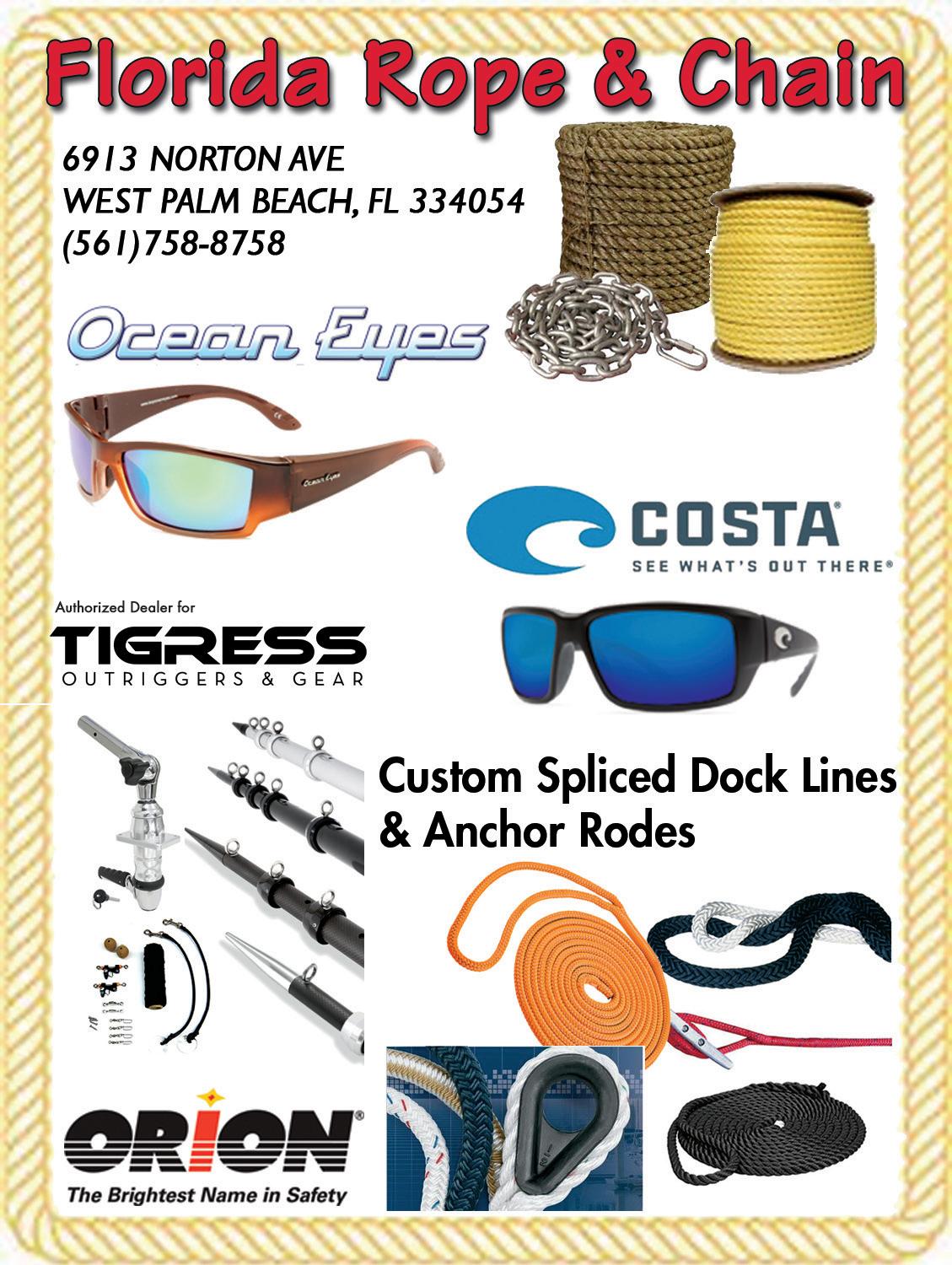
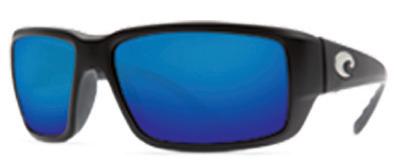


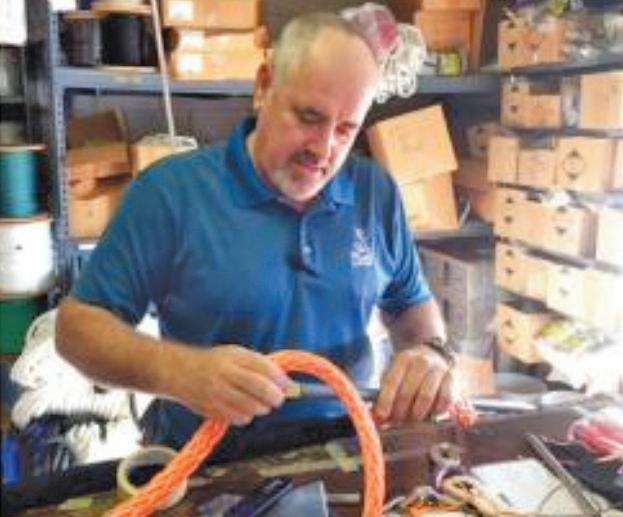
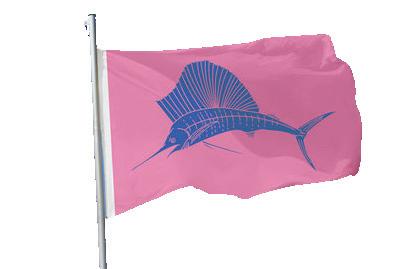

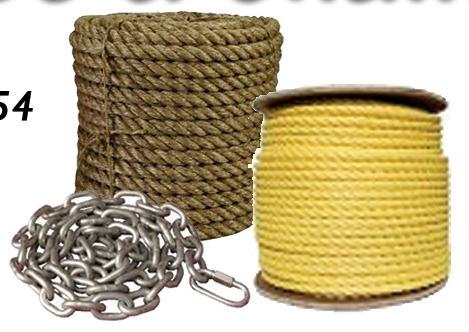


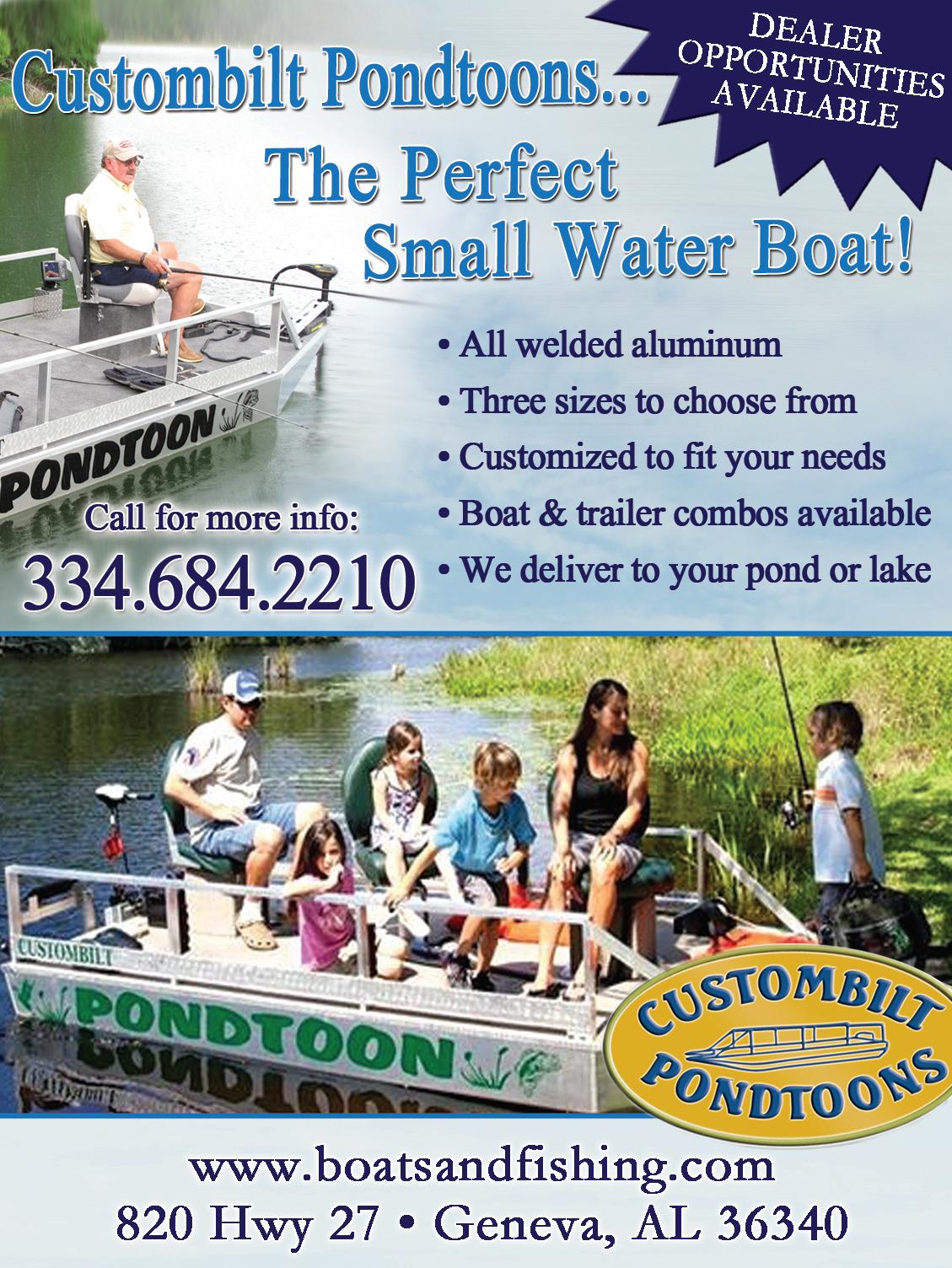
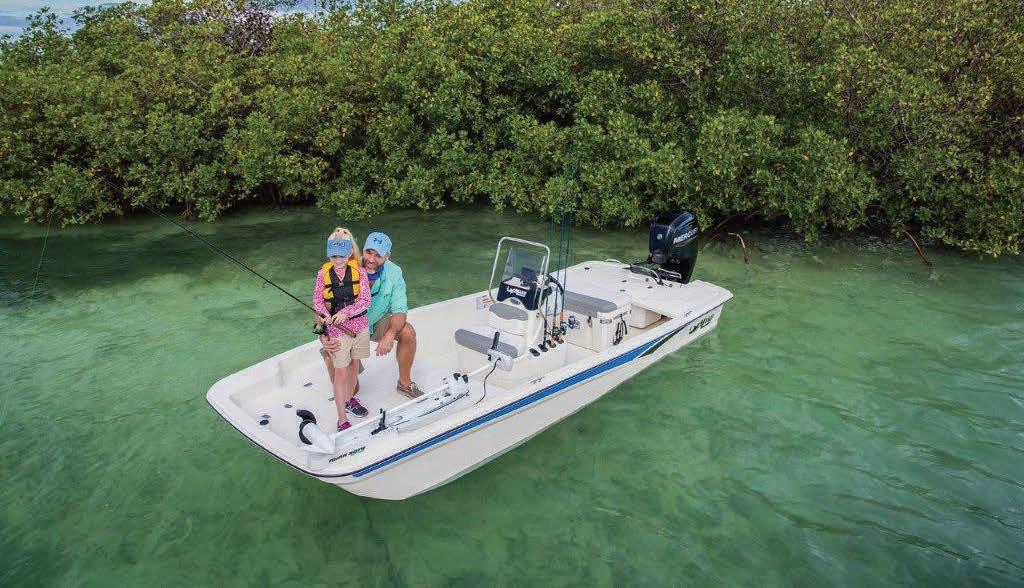
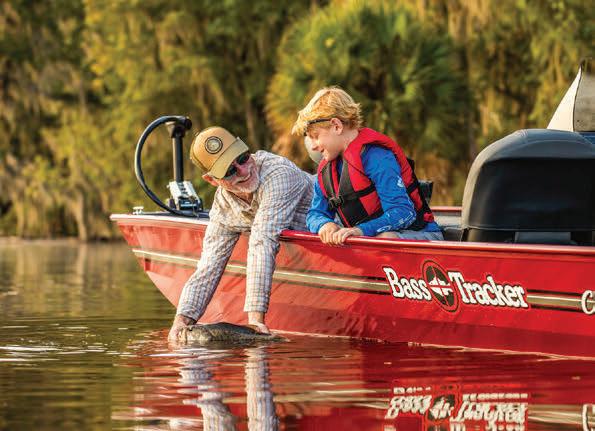










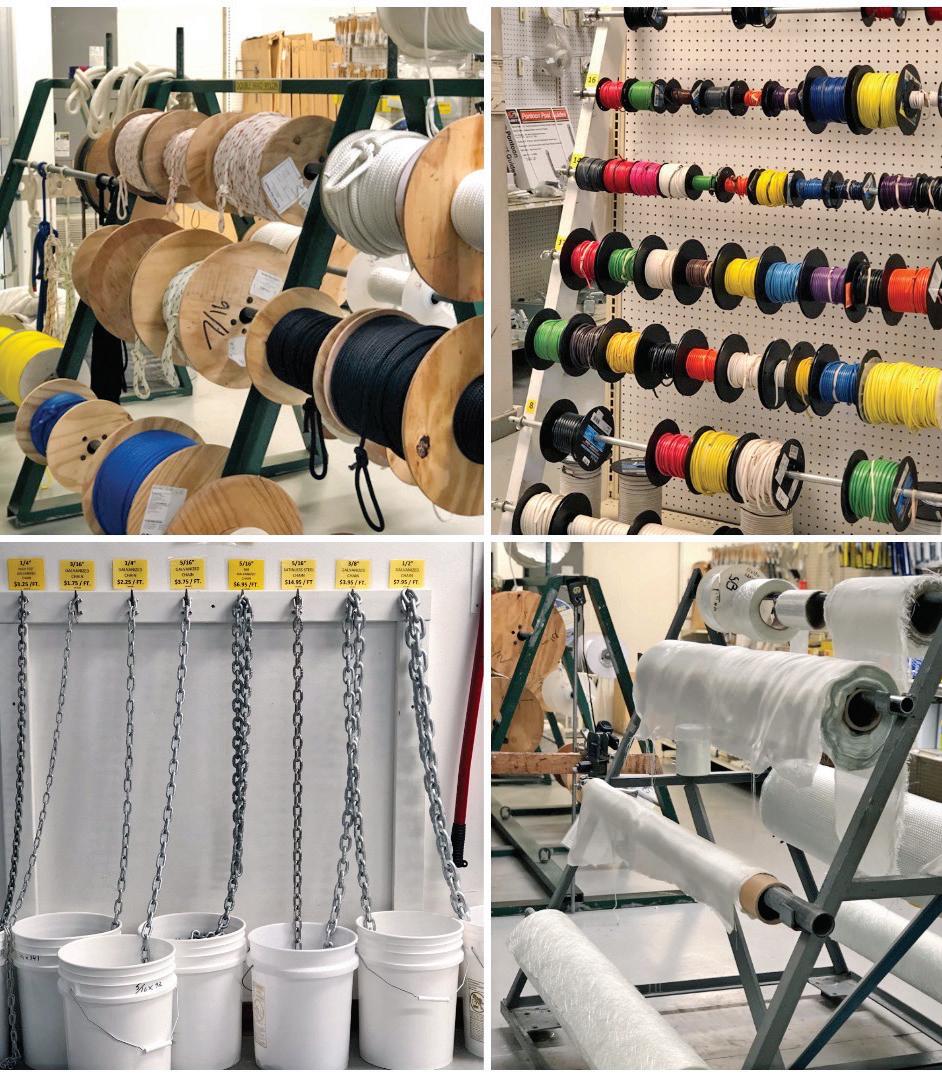
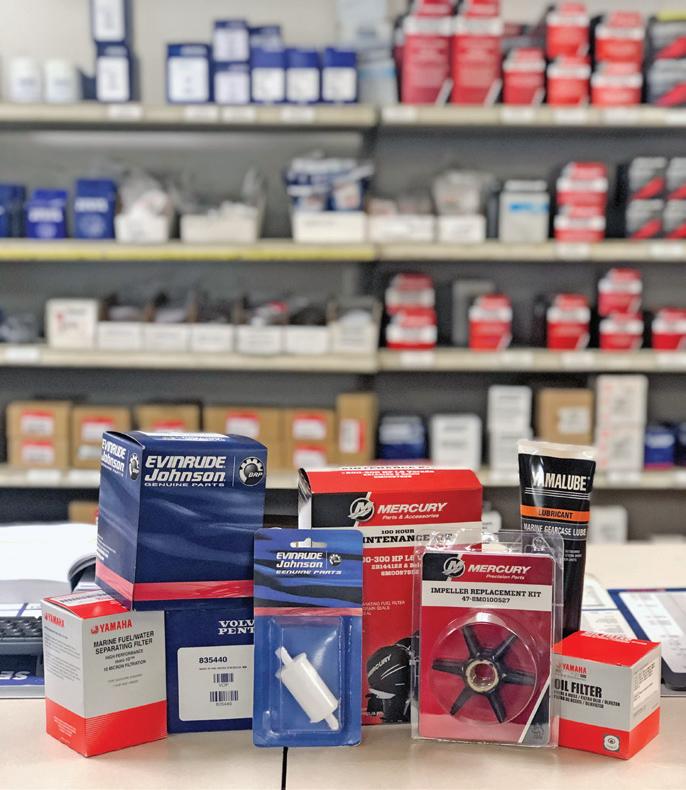















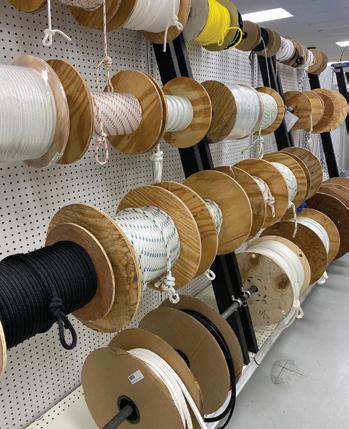

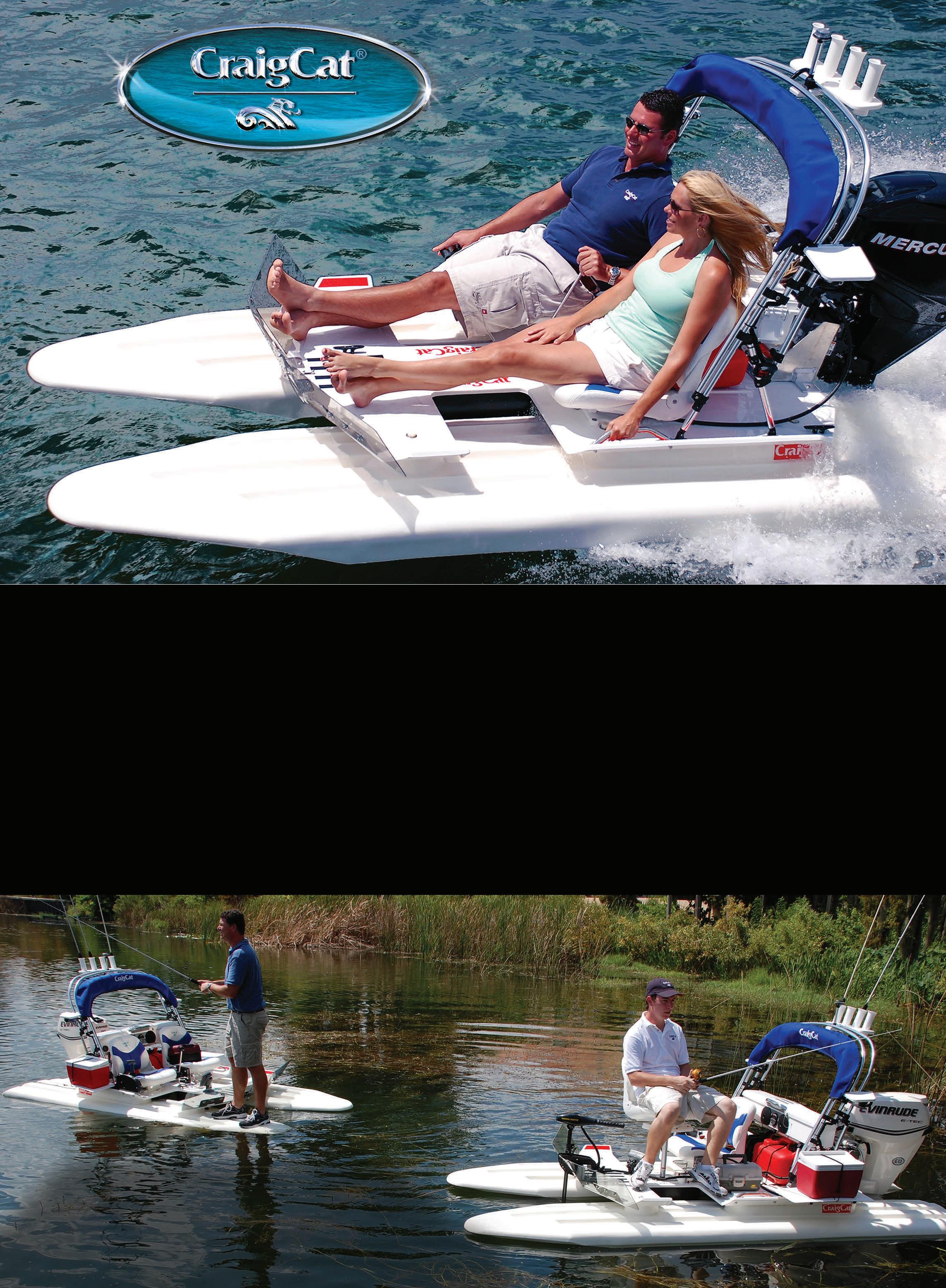



Berkeley County is a wonderland for outdoor enthusiasts, sports bu s, adventure seekers, and water lovers. From exemplary fishing for striped bass, or a trophy largemouth bass, to our hiking trails and water activities, along with scenic outdoors where you can catch a glimpse of white tail deer and gators, Berkeley County has activities to fit all visitors and families.
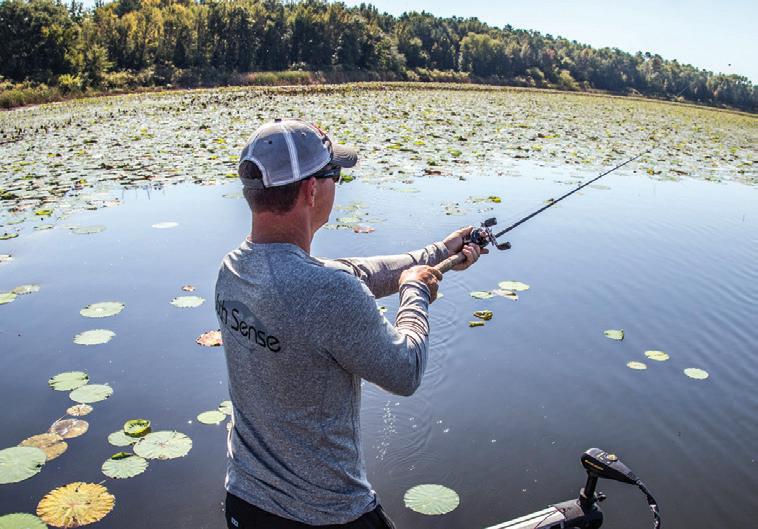
Learn more about Berkeley County at: exploreberkeleycounty.com
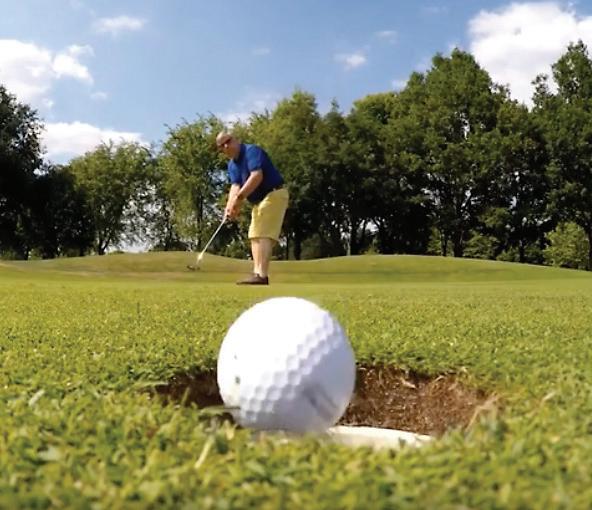

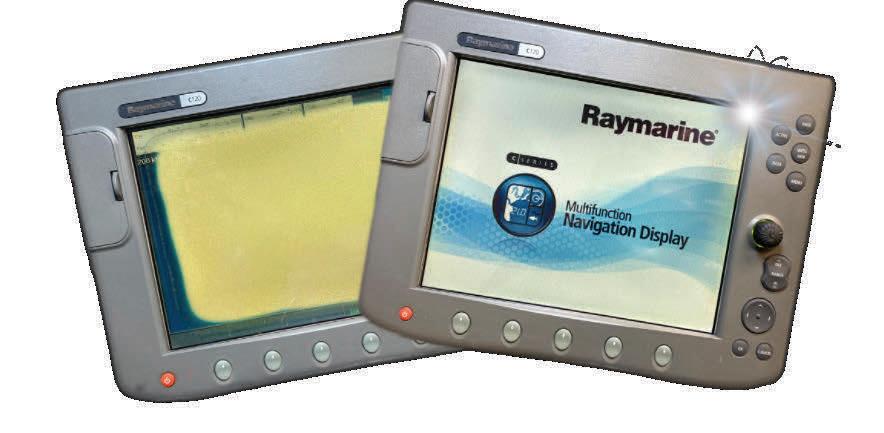
Researchers have designed and tested a new style of hook that takes catch-and-release to a whole new level. ese “bite-shortened” hooks are intended to allow sh to “release themselves” without being handled by the angler.

Dr. Holden Harris, a postdoctoral researcher at the University of Florida’s Nature Coast Biological Station, was the mastermind behind the study. In his write up on Hook Line & Science, a North Carolina Sea Grant blog, he promoted the bene ts of e cient de-hooking and minimal handling of caught sh to considerably improve chances of survival for released sh. e hook he tested is a modi ed jig, which researchers clipped at the point, so that this “bite” portion of the hook—the business end— was reduced in length from 15 mm to 10 mm. e simple modi cation just clipped the barb and vertical length beyond the bend of the hook before it was re-sharpened. Harris tested it against a standard jighead as well as a jighead with the barb led down on 150 spotted seatrout. ey went shing with all three jigheads, reeled in the sh and then allowed the sh to op around boat-side until they either did or did not come unhooked.
“We found promising results for the bite-
 HARRIS
HARRIS

shortened modi ed hook, which enabled anglers to land 91 percent of hooked spotted seatrout and then release 87 percent of those sh without direct handling,” Harris wrote. “In comparison, the self-release success rates were 47 percent using barbless hooks and 20 percent using standard, unmodi ed hooks.”
Additionally, Harris found that smaller seatrout were able to “self-release” at higher rates than larger ones.
Coastal Angler contributor and seatrout-on-










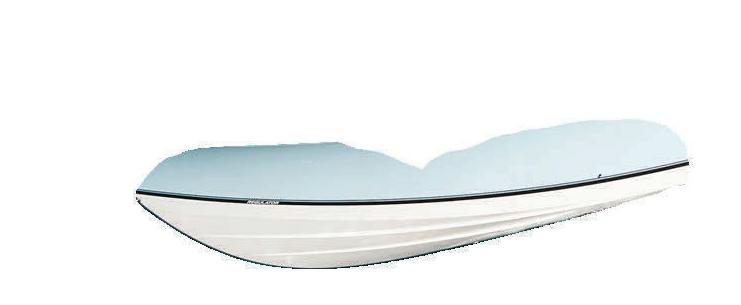
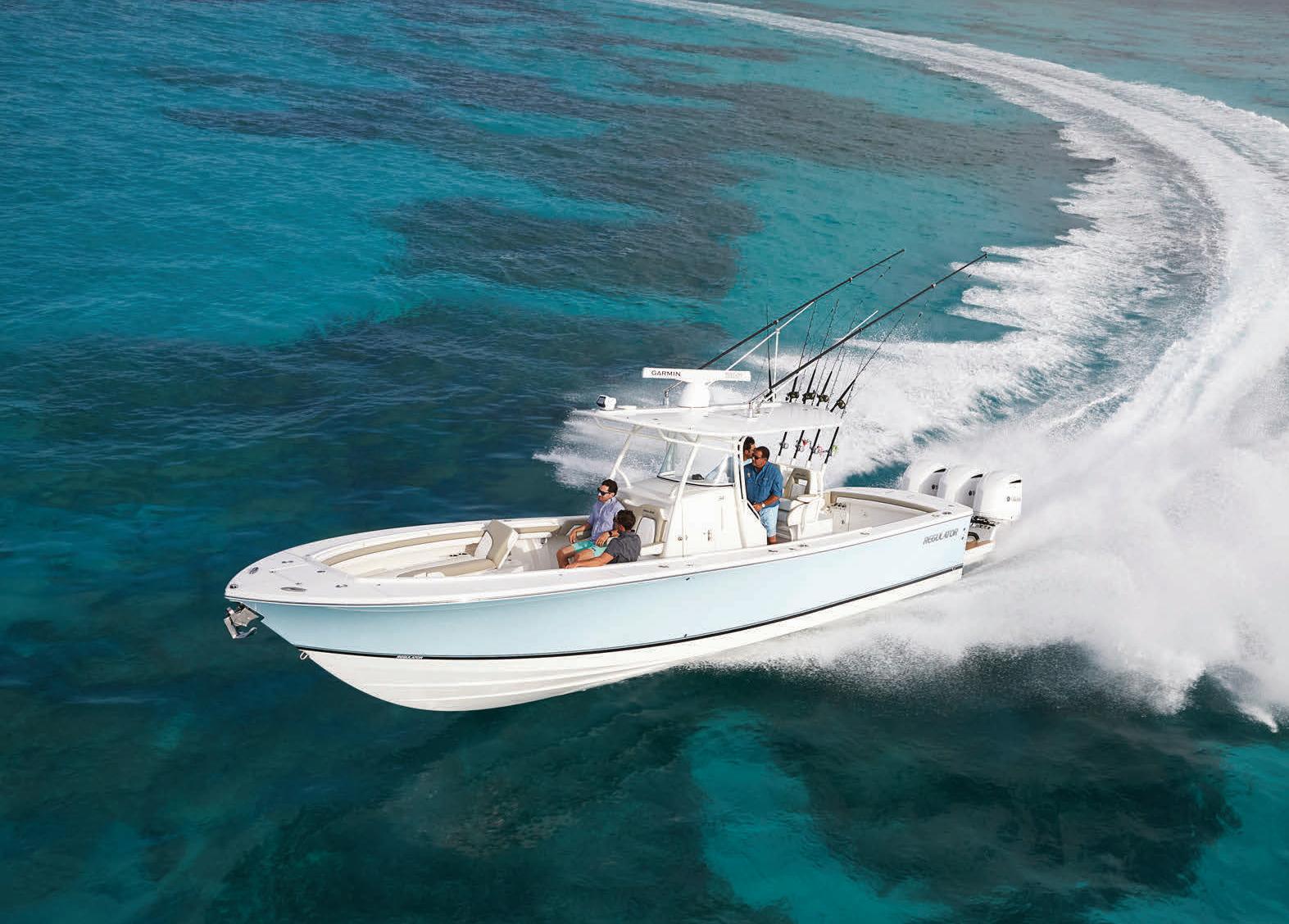
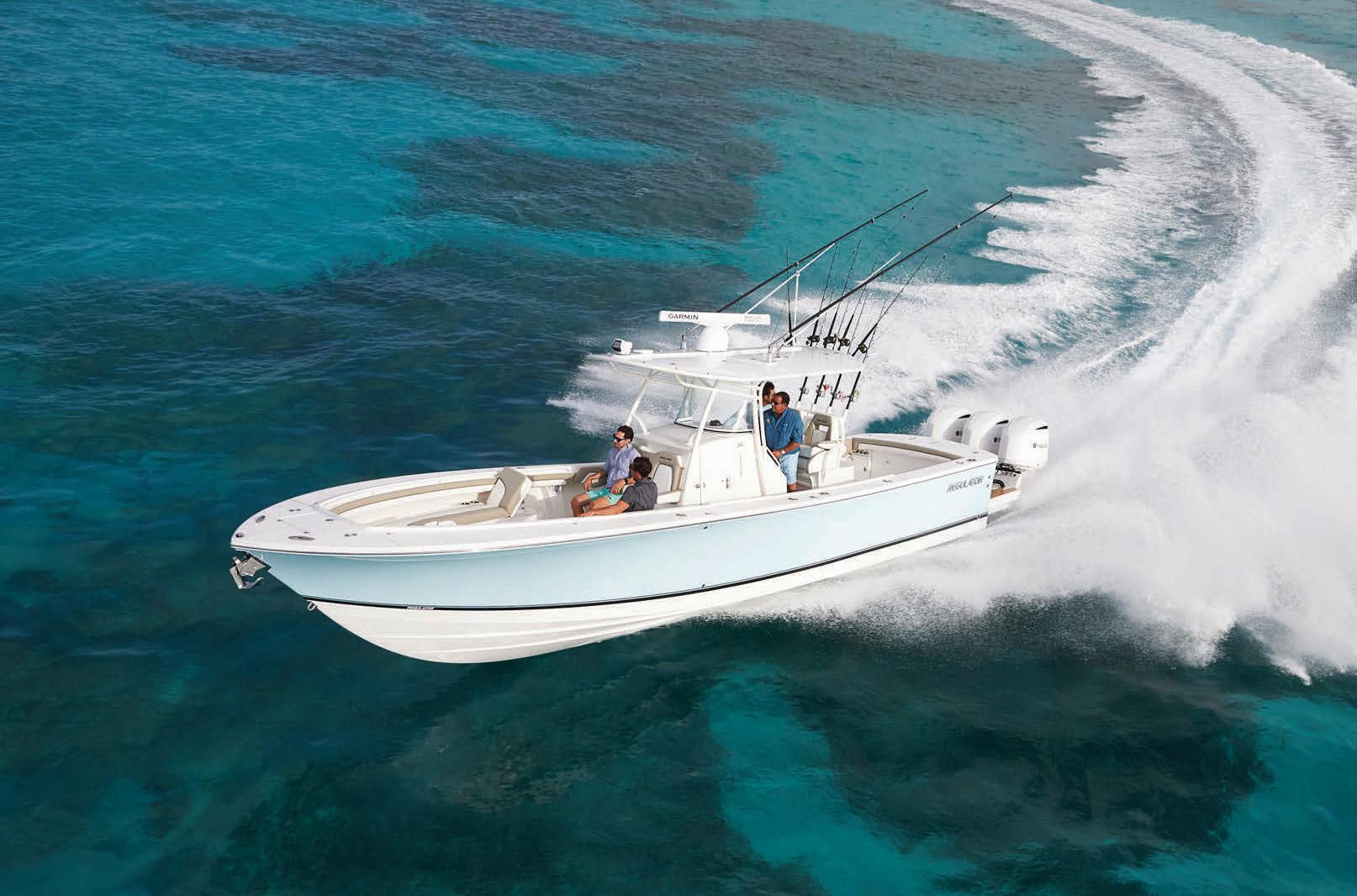

arti cials guru Michael Okruhlik has written on his use of barbless hooks when targeting pods of trout crashing bait. He said the ability to quickly and safely release sh without taking them out of the water allows him to get back in the action faster.
Maybe anglers would use a hook designed to let sh come unbuttoned?
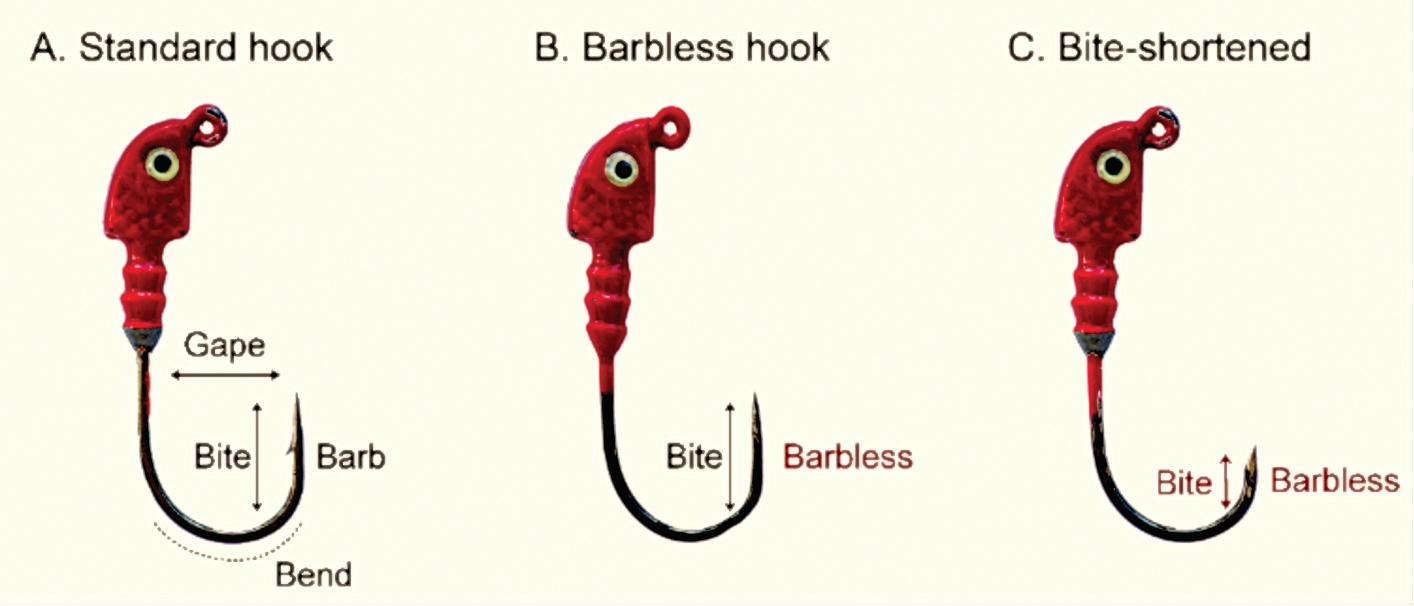


For a video of this hook modi cation, see https://youtu.be/VC23oNikyc8


Every year in Basel, Switzerland, the world’s best-known luxury watchmakers gather to display their new timepieces. It’s a great event for spotting timepieces that standout–– in performance and in personality. We saw one impossible to ignore: a precision dive watch with an arresting green dial. But we also saw the five-figure price tag and knew we could bring our customers that exact same precision and stand out appeal for a whole lot less. The Stauer Evergreen Diver is that timepiece.
Built like a submersible battleship with a stainless steel case, caseback, and band, the Evergreen Diver is water-resistant down to 660 feet or 20 atmospheres, a feat facilitated by a hardened crystal and screw-down crown.
Green On Your Wrist AND In Your Pocket. You could pay an awful lot elsewhere for this verdant virtuoso, but the majority of the cost is in the big designer name upcharge. We think those guys are all wet. This is how you own a top-of-the-line dive watch without helping pay for some marketing guy’s yacht.
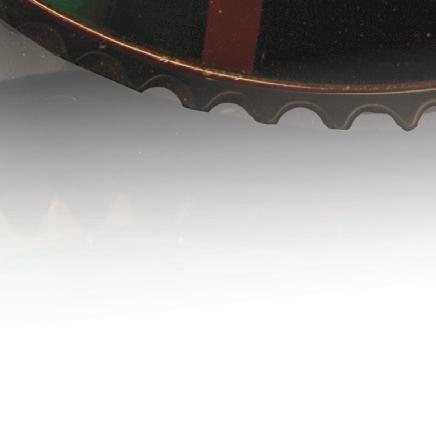

Satisfaction Guaranteed or Your Money Back. Wear the Evergreen Diver for 30 days. If you’re not completely happy, send it back for





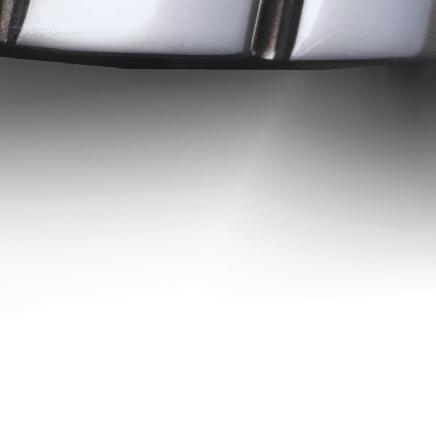
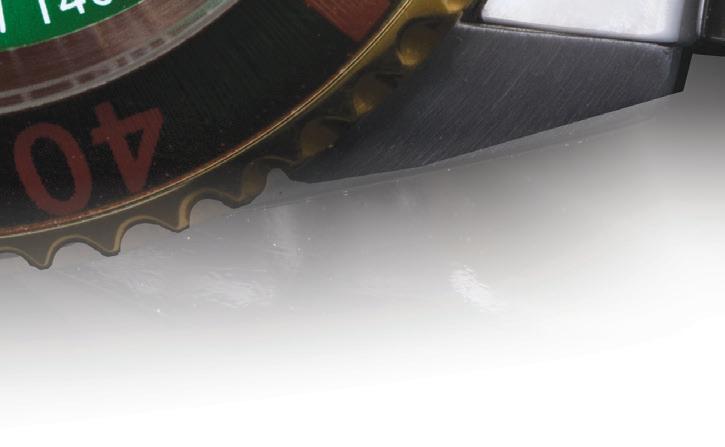
Amonster gold sh aptly named “Carrot” has been making the rounds on social media recently a er the sh was caught from a trophy carp lake in Champagne, France. UK angler Andy Hackett caught the nearly 70-pound bright orange sh from Bluewater Lakes, a heavily managed, privately owned pay-to-play shery that boasts of carp weighing heavier than 90 pounds.
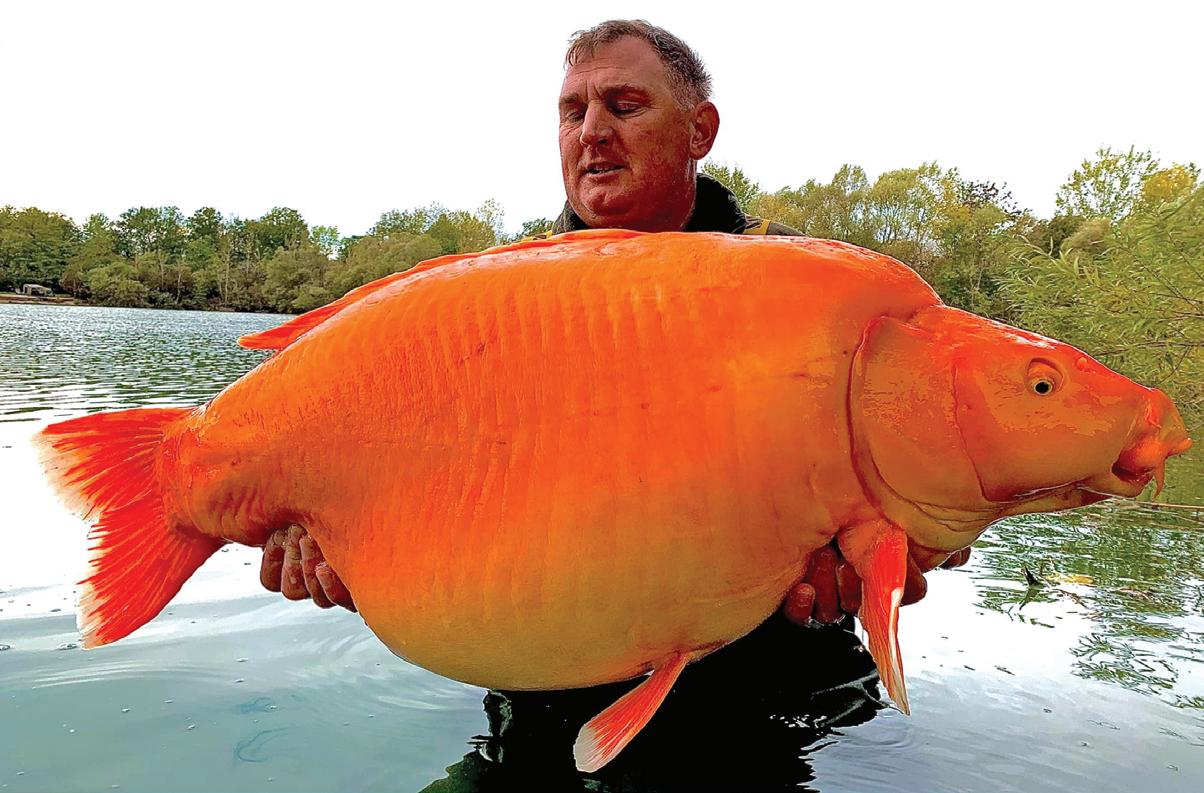
Carrot seems to be somewhat of pet, but not the type you’d keep in a sh bowl. She is a crossbreed between leather carp and koi, and was stocked in the lake 15 years ago to give anglers an interesting sh to pursue.
“I always knew e Carrot was in there but never thought I would catch it,” said Hackett. It took him 25 minutes to reel in pot-bellied carp, which o cially weighed an astounding 67.4 pounds.
Carp caught at Bluewater Lakes are handled very carefully with a strict catch-and-release policy.
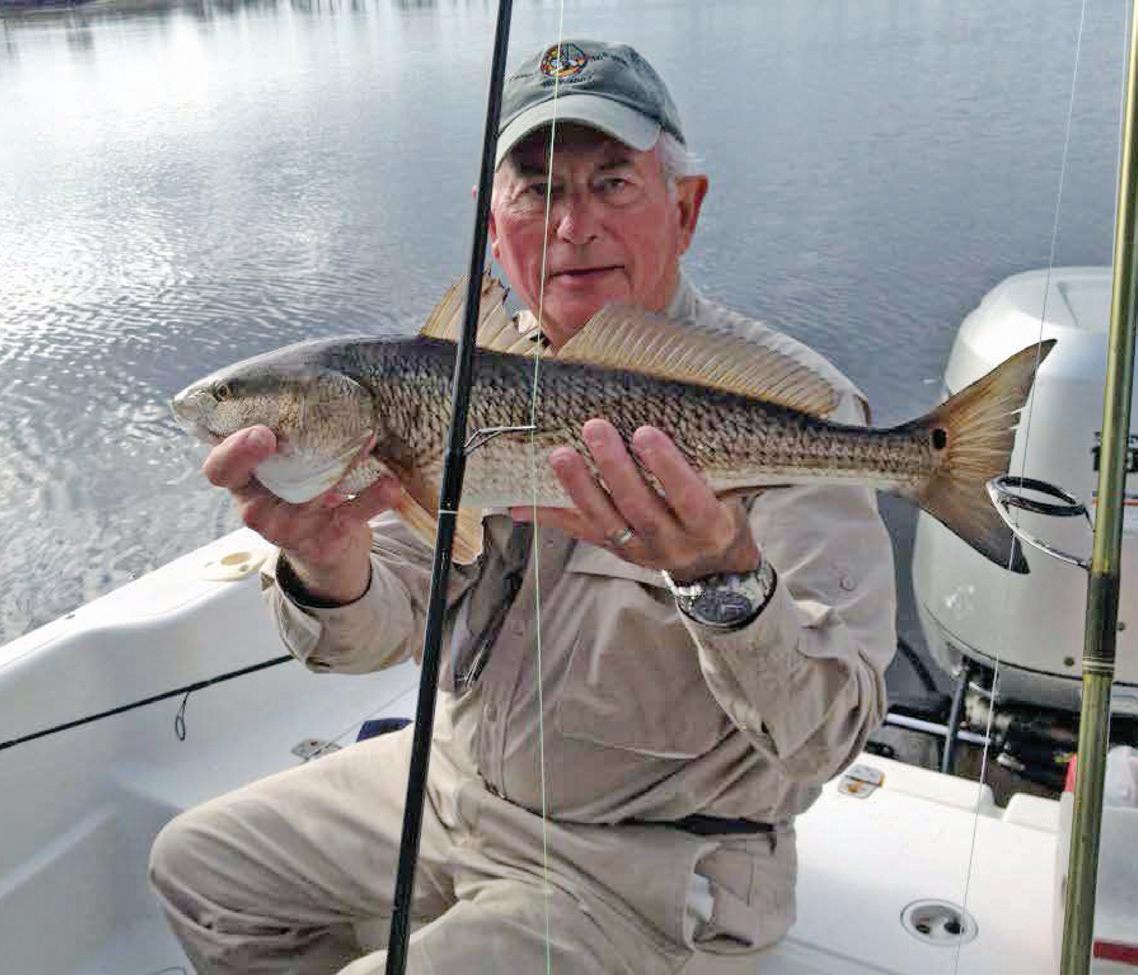
For more record sh, visit coastalanglermag.com.


Some cold but very fun shing days are ahead, and a Trapstyle bait is my absolute favorite way to sh this time of year. Typically sh group up in winter, and whether that be bait sh or bass, there are opportunities that make lipless crankbaits absolutely deadly!
rowing a lipless crank around areas where sh are chasing bait or where they are grouped up has caught lots of bass and some big ones. Even casting this bait as a search bait can work wonders. ere are so many options for lipless cranks that it can get confusing. I’ve experimented plenty, so I hope this article helps.
Traps range from ¼ oz. up to 1 oz. in weight, and every size can be used di erently. I pick sizes depending on the depth I’m shing or the depth of the structure, and I also consider the natural bait that is prevalent in the area. If you’re shing shallow or around tiny bait sh, a ¼-oz. size will be the best bet. A ½-oz. is usually my goto. It’s great for the mid-range depths of 5 to 10 feet, and it imitates a range of bait sh sizes.
A ¾-oz. is a bit bigger, and I don’t throw it as much, but it certainly has its place in 10 to 20-foot depths.


Remember, you can always vary your retrieve to get these baits higher or lower in the water column.
Color is another key factor. Ninety percent of the time, I sh a bait sh color. Whether it’s a shad, shiner or bluegill pattern, natural colors always work for me. I also throw orange or red a lot in winter. ese colors imitate craw sh, and they work where craw sh are prevalent. Match your bait color to the forage in the lake.
e last factor for lipless baits is sound related. ey come in silent, multi-rattle or single-knocker versions. I go silent for very clear water and heavily pressured sh, when appearing natural is important. e multi-rattle baits make a lot of noise, and the commotion draws strikes. My go-to, though, is the one-knocker style. is sound is unique and a little deeper pitched. I feel like sh, over the years, have become accustomed to the loud versions. I nd the single-knocker gets a few more bites in most situations.
With treble hooks, rod selection is important. You just reel into the sh when you get a bite, and this means your rod needs a solid backbone to drive those hooks and also a good amount of tip for keeping sh on during the ght. My go-to rod is a 13 Fishing Omen Black 7’4 Medium Heavy Moderate. e 13 Fishing Concept A 7:5:1 is a perfect reel for this application. I sh 15- to 20-lb. Seaguar Invizx line, depending on the structure I’m shing.
I hope these Trap tips help you put a few more sh in your boat this winter!
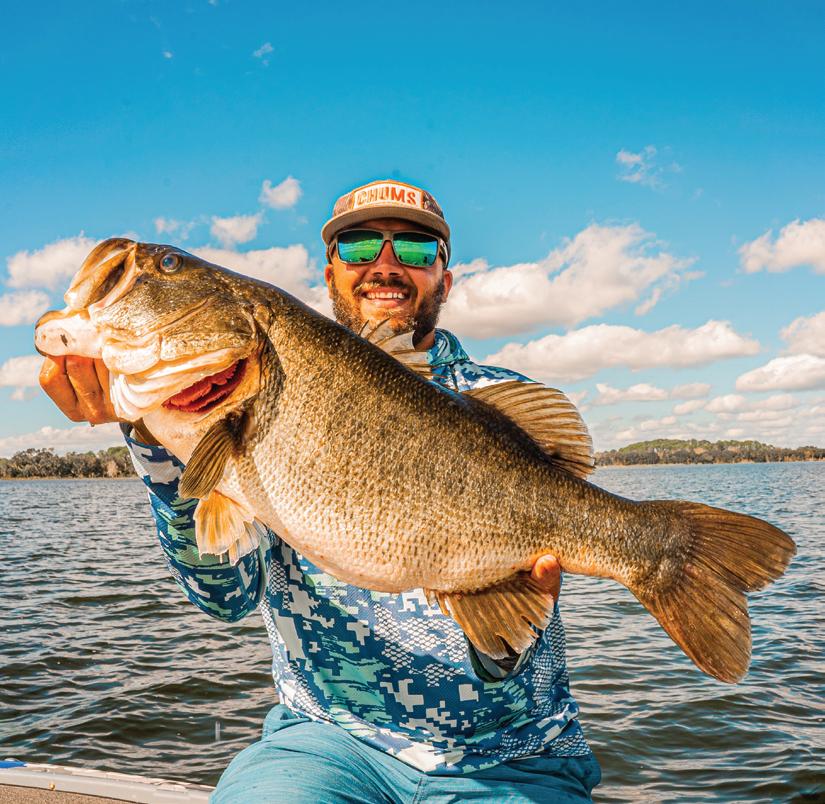
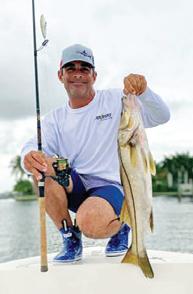

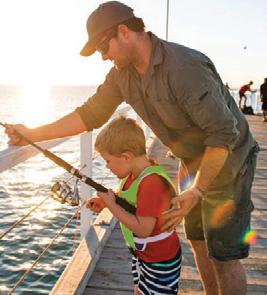
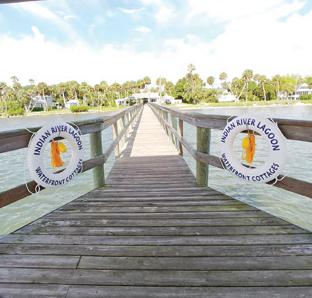
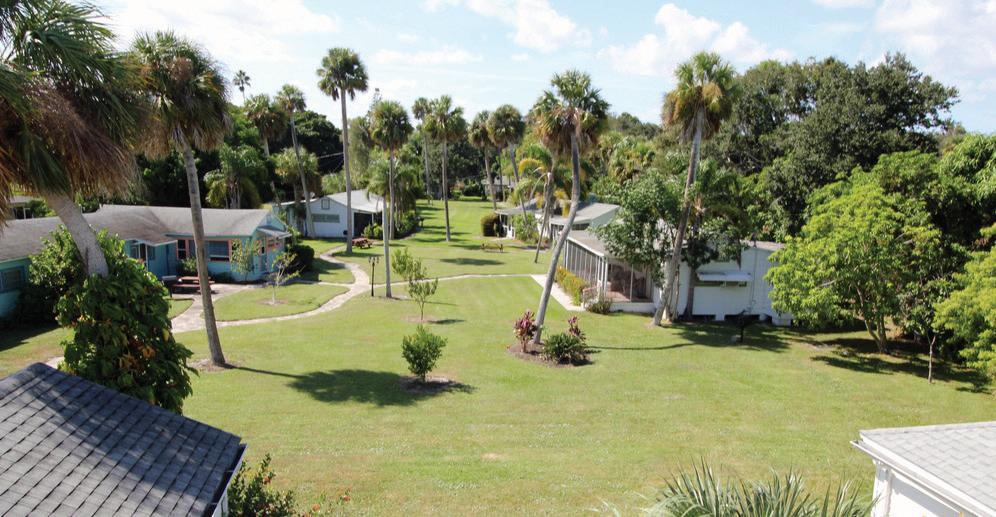
Tyler Woolcott is a professional tournament angler and guide. Check out his website at www.tylerwoolcott shing.com.




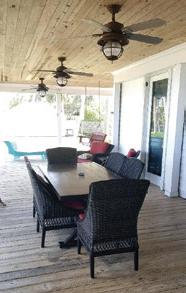
ANew Jersey angler eked out a new state record for albacore (long n) tuna in October when he boated a 78-pound, 2.4-ounce long n that bested the previous 1984 record by 3.4 ounces.
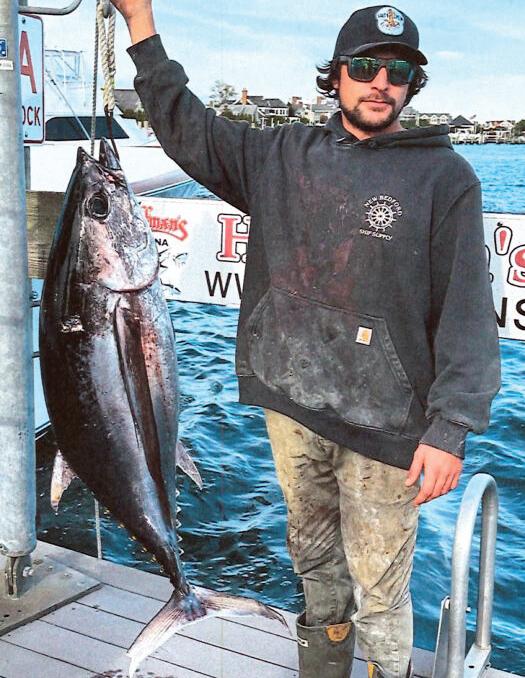
Matthew Florio, of Brick, N.J., is a commercial scalloper and he was shing with the rest of his scalloping crew aboard the Luna Sea at the east elbow of Hudson Canyon, the largest known underwater canyon o the east coast of the U.S. ey were at least 75 miles o shore and chunking for yellow n tuna, which is a technique that involves cutting up a bunch of butter sh and throwing them overboard before following up with hooked chunks of butter sh. e crew was already having a good day with yellow ns when Matthew hooked into his big albacore. He battled it in with a Kevin Bogan 30 Stand Up rod and a Penn 30 reel loaded with 60-pound mono lament. e sh measured 48 and 3/8 inches long and had a girth of 37 inches. e previous record was a 77-pound, 15-ounce long n caught in 1984 by Dr. S. Scannapiego in Spencer Canyon.
For more record sh, see coastalanglermag.com.
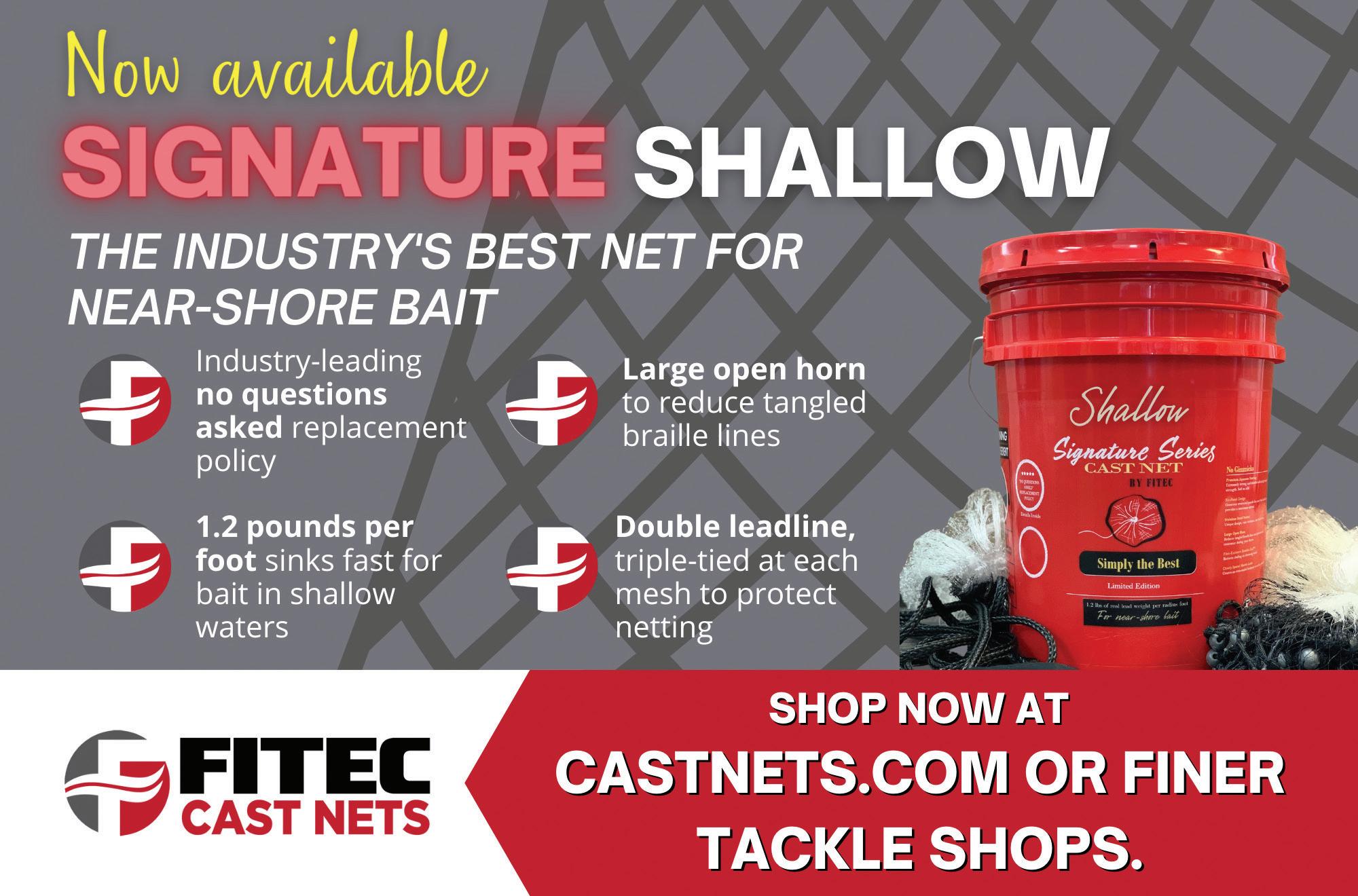

Now that Jack Frost has bay temperatures thoroughly chilled, only diehard lure chuckers will be found stalking the ats. Most of us have one thing in mind this time of year, catching a trophy trout. Here is how I approach my quest for that dirty 30-incher.
When water temperature stabilizes in the COLD range, all the migratory forage ees for warmer pastures. e bays are le with larger mullet as the primary food source for prized speckled trout. is is the time of year that I pull out my larger lures. is could be a longer length, a wider pro le, or both. is doesn’t have to be a 12-inch lure that is no fun to cast all day, but I do upsize from my typical 3- and 4-inch lures that I use most of the year. We have all seen a 25-inch trout with a 15-inch mullet in its belly, so they will eat something huge, but giant baits aren’t as fun to sh.

My con dence lures this time of the year are typically a 4-inch wide-pro le slow-sinking lure or a 5-inch bulky body paddletail. Since plastisol is buoyant, the bulky lure will have a slower sink rate, which I prefer under most conditions. e
slower sink allows for dual bene ts this time of year. Logically, the slower sink rate matches the slower mood of a cold sh. Also, I spend a lot of time targeting sh over shallow grass in knee-deep water. A slower sink rate keeps my lure in the strike zone longer before it disappears into the grass.
weedless hook. Depending on the conditions, I might go weightless or with a 1/16- or 1/8-ounce jighead. e weedless version keeps me out of the grass, it lessens the opportunity for my cold, less-dexterous hands to be impaled by a hook, and most of all, it does less damage to the trophy sh that I am targeting.
Areas I target will be near deeper water, have so er bottom, have visible forage, structure and hopefully be lowertra c areas. While planning trips, I take into consideration moon phase, current conditions and recent conditions when determining where to sh.
I have never caught a trophy trout by accident. I don’t know if that is lucky or unlucky, but every trout I have landed over 27 inches was on a day when I set out speci cally targeting larger sh. Case in point, if you want to catch trophy trout consistently, you must make the e ort to target them, sh where they live and be attentive to details. I know numerous anglers have caught large trout with no e ort, but most don’t catch two.
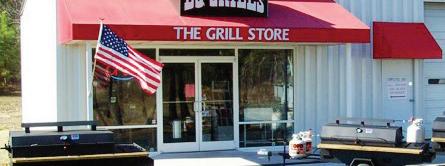

I t my 5-inch rattling paddletail with a
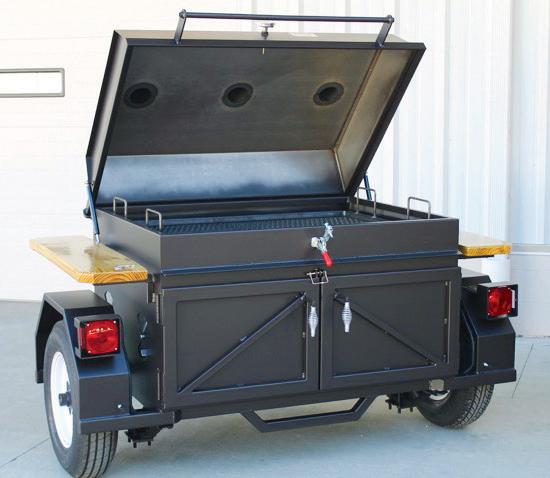

Capt. Michael Okruhlik is the inventor of Knockin Tail Lures®, and the owner of www.MyCoastOutdoors.com.
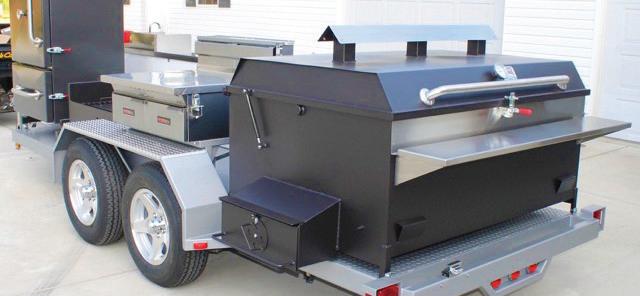
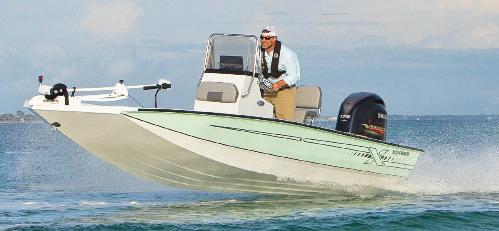
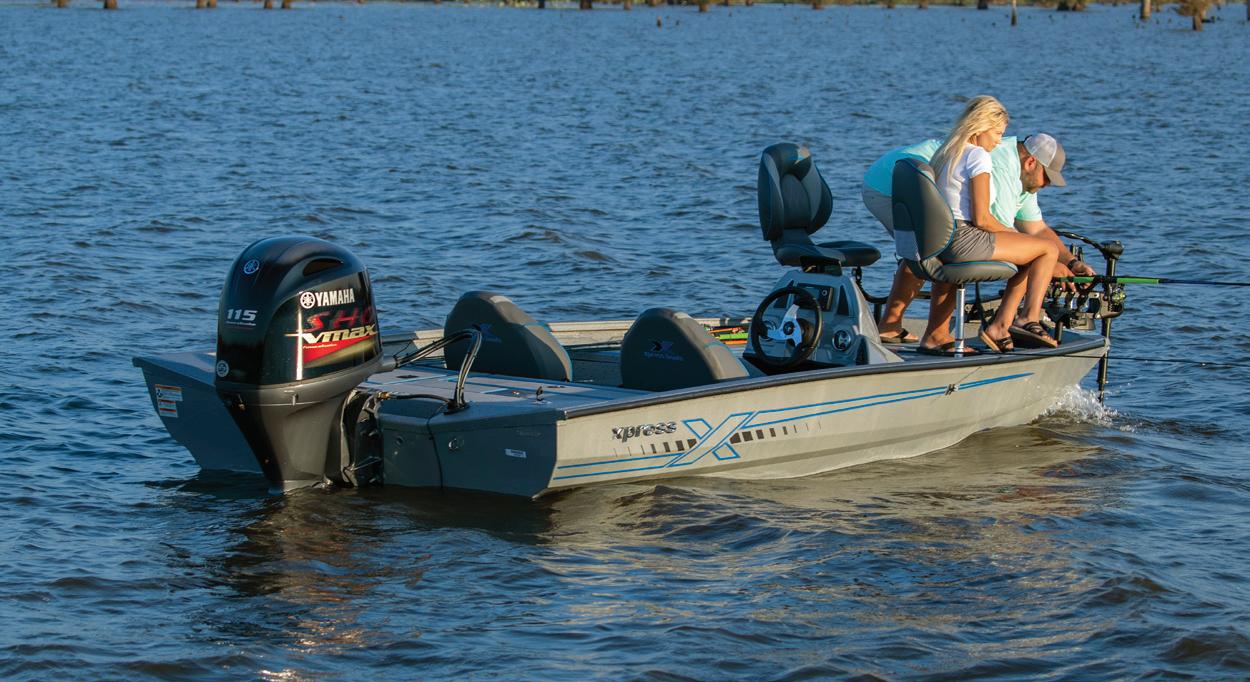
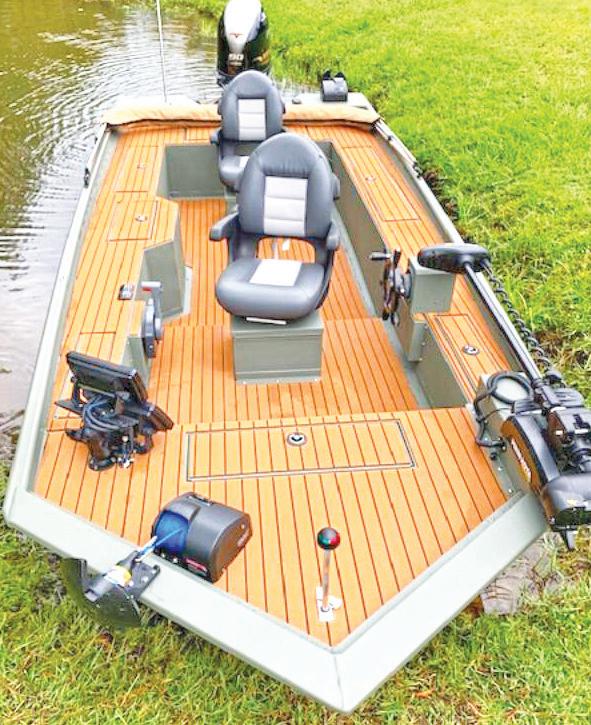






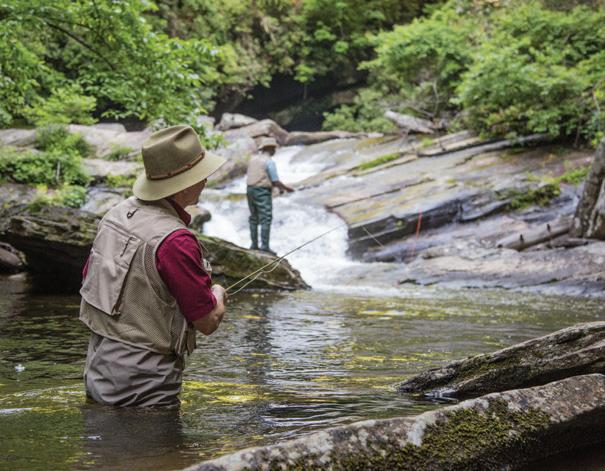





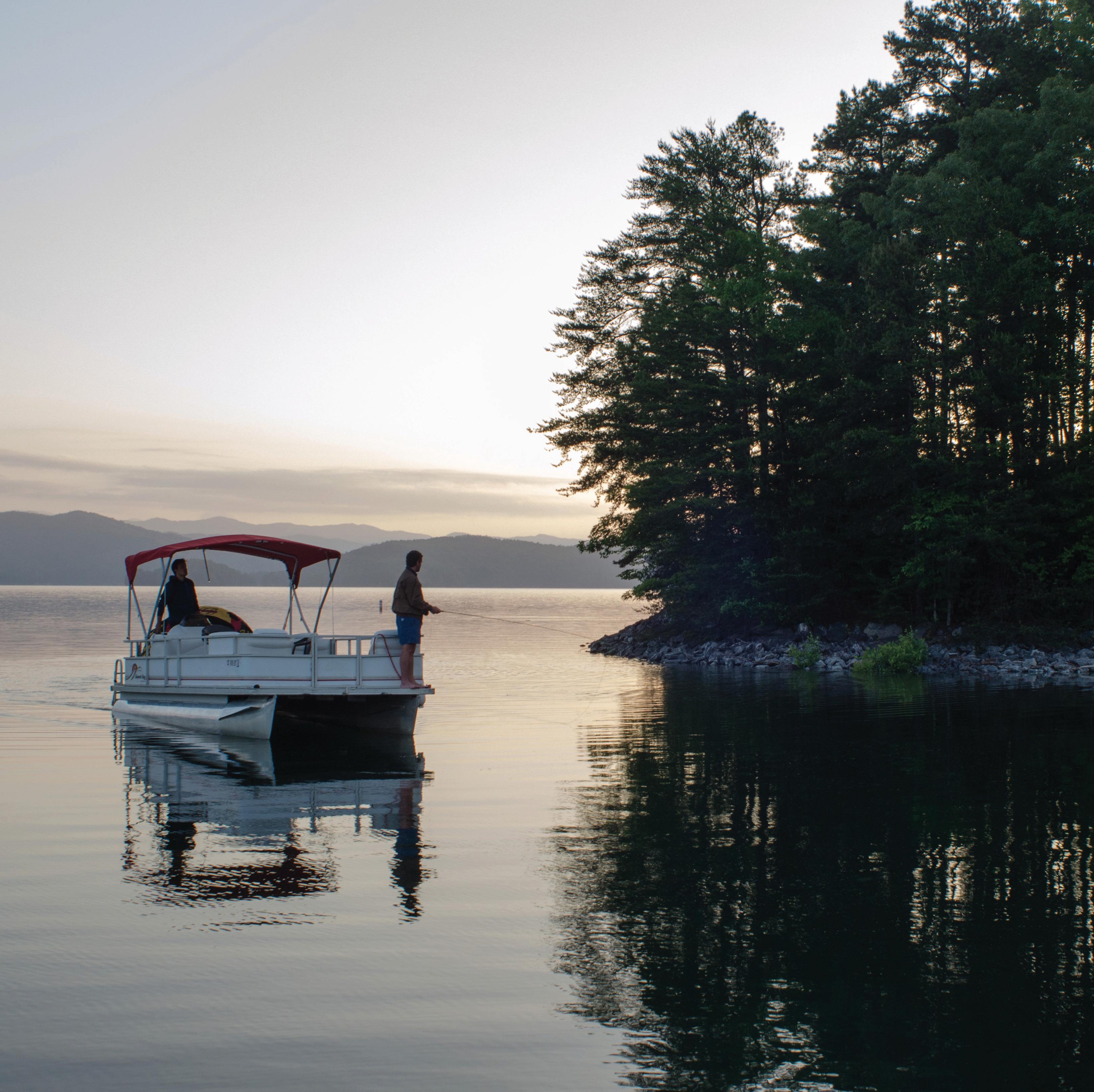
Every season is the best season to explore the many treasures in the Upcountry.
